

How to write a Perfect Position Paper (A Student's Guide)

Writing a position paper is akin to writing an objective research paper that considers either side of an argument based on facts.
A position paper focuses on controversial issues by exploring an aspect of an argument, presenting valuable insights into interpreting the problems, and coming up with recommendations to solve them.
To write a strong position paper that scores excellent grades, you must choose a good topic, align with a position, develop arguments, draft the paper, and polish it well before submitting it for grading.
In this guide, our expert paper writers at GradeCrest share tips, insights, and details about how to write an excellent position paper.
What is a Position Paper?
Like an opinion essay , a position paper is an essay that presents an arguable opinion about a topic or an issue. The main goal of a position paper is to convince the readers (audience) that the author's argument is valid and worth consideration. The author picks a view on a specific topic and uses evidence and facts to support their stance, just like in a persuasive essay.
Like an objective research paper, an academic position paper draws from evidence, data, statistics, and facts, enabling the authors to take an evidence-based position by presenting an arguable opinion about the issue or problem in question. It is similar to an argument paper or a debate supporting one side of an issue.
When writing a position paper, you are expected to convince the audience that your opinion is valid and worth listening to, even if there are other potentially viable positions. It is an impartial paper that addresses both sides of an issue and persuades the audience that you have well-founded knowledge on the topic.
Although position papers might be assigned in high school and college, professionals in many industries also write them as part of their daily duties.
In college, the intention is to achieve what is set in the assignment prompt/instructions. However, for professional purposes, the point of focus is on matters relating to the industry and sometimes an entire country.
You are likely to write a position paper if you practice in healthcare, nursing, scientific research, public policy, education, economics, political sciences, international relations, and law, among others. In that case, the format differs because you have to include an abstract, background, position, conclusion and recommendations, appendices, and bibliography sections.
Purpose of a Position Paper
The overarching goal of a position paper is to generate support for an issue. It vividly describes the author's position on a problem and the rationale for the position based on facts that offer a solid foundation for the arguments and counterarguments. It entails inductive reasoning and the use of facts to critically examine a position to expose the strengths and weaknesses of the opinion of the author.
Position papers are usually short documents stating an organization's policy, position, or philosophy regarding a subject. It can also be an issue brief where you pose a problem or question and answer it by giving information or coming up with a proposed solution.
It is a paper created to transfer knowledge and enable the readers to understand a specific topic or issue. Position papers also provide critical information that can help in decision-making. They are also an excellent tool for professionals to present their perspectives on pertinent issues in the industry.
A position paper explains the conclusions or findings resulting from research collaborations, design and development efforts, or insights by an organized committee.
A policy position paper helps implement a procedure or policy in government and can also help build consensus and come up with solutions. Companies and corporations use position papers to share their ideologies, beliefs, stance, and recommendations.
Structure of a Great Position Paper
A comprehensive position paper has an introduction, body paragraphs, and a conclusion. Since it is a one-page document, these three sections must be brief, clear, concise, and succinct. There is no room for wasting words when you only have a limited word count.
Although the structure of a position paper might be flexible, it should convey the problem and the author's position. The author's background, relevance, and position must be clear.
When writing the position paper, ensure that you address the critical components of the issue. Besides, you should present it in a palatable manner to the audience.
Introduction
The introduction paragraph of a position paper is a critical part of the assignment. It identifies the issue you are about to discuss in the paper and clearly states your position on the issue through your thesis statement.
It is vital to grab the readers' attention using a relevant hook statement. You can use a fact or statistic to draw the readers' attention. For example, if you are writing a position paper on microplastics, you can present facts about the number of organisms affected by microplastics in oceans.
Besides, the introduction should give a proper background of your topic, showing your readers why they need to focus on it. Wrap up the opening by including a thesis statement and, if possible, signpost the ideas the reader should expect in the rest of your paper.
The body section of your paper contains the central arguments and counterarguments, claims and counterclaims, examples, and supporting facts to support your position while looking at other potential positions. This means you must present a discussion of both sides of the issue that addresses your position and refute those that contradict your position.
It should have at least three paragraphs that are well-balanced, organized, and flow into one another. Every section should contain a topic sentence, supporting details, and a concluding sentence. Ensure that the topic sentence, like a mini-thesis, only focuses on one issue or idea that relates to the thesis statement. Use good, valid, relevant quotes, evidence, facts, and real-life examples to support your arguments or views.
When introducing opposing ideas to show your maturity in reasoning, ensure that you optimize the arguments and refute them to make room for acceptance of your position by the readers.
To craft an amazing body for a position paper, look at the model position papers published by different institutions of higher learning for inspiration. These examples can help you format and frame your arguments, organize your essay, and present your points logically.
At least have 2-3 main arguments that assert your position and relate to your thesis with relevant supporting details. At the same time, give room for counterarguments and have information that refutes the counterargument.
Ensure that each paragraph is indented well and that there is a clear transition from one to the other. Besides, your choice of words should be meticulous. Use powerful academic words and phrases to show that you understand your craft.
The conclusion paragraph of your position paper should offer closure for your readers. Having presented facts, it is now time to summarize the main points. You should restate your thesis by rephrasing it in different words but with the same meaning. Wind the paper by suggesting solutions or making recommendations.
- How to write perfect Paragraphs
- How to nail counterarguments
- How to make a paper longer
Outline Template for a Position Paper
- Introduce the topic
- Provide the background of the topic
- Assert the thesis (this should be your view, position, or perspective of the issue)
- Summarize the counterclaims
- Provide supporting details for the counterclaims
- Refute the counterclaims
- Give evidence for the argument
- Give your opinion
- Provide supporting points
- Restate the thesis
- Provide a plan of action
Steps for Writing an Excellent Position Paper
A position paper is like an argument paper or a debate where you pick a side on an issue and gather facts, evidence, and information to present a convincing argument that your position is the correct stance.
1. Read the instructions
Reading the assignment instructions before beginning to plan and write your academic position paper is a no-brainer.
The instructions have guidelines that you must follow to the T. besides, you will also know the format to use, citation style to incorporate, and the number of words or pages to include in the paper. Some professors also give a list of topics or hints of what topics to select for the specific assignment.
Apart from the prompt, you might also get the assessment criteria as a rubric. Go through it to determine what your instructor wants to see.
Comprehending the instructions will help you write a position paper that is compelling, clear, concise, and complete. It is good to read them as you take notes to piece everything together and earn full marks or score the best grade.
2. Select a Topic
After reading the instructions, the next step is to select a suitable position paper topic. You can select from the list your professor has suggested or choose one that meets the criteria outlined in the paper prompt. Selecting a good topic for the position paper is as essential as having a good structure with solid arguments and well-presented counterarguments.
If you are selecting a topic on your own, ensure that it has a multisided issue. Ensure that the topic is controversial and has at least two clear sides, with one side being the most agreeable to most people. To meet these criteria, you will need to do some rough search (preliminary research) to find a suitable position paper topic that:
- Is controversial;
- It has two precise positions and is thus debatable;
- It has enough information, evidence, and facts to enable you to argue for one of the positions and,
- It has a manageable scope (not too narrow, not too broad).
Such a topic will help you build a solid case for your argument and convince your readers that your position is defendable and valid. Remember, as you would in an argumentative essay , you will include supporting evidence for both sides, then refute the conflicting arguments.
For instance, you don't have to write about children requiring close parental guidance, as nobody would disagree.
A good topic could be Children aged nine years (preteens) and teenagers who need to get mandatory HPV vaccines to prevent them from HPV infections that could expose them to cancers in later years of life.
You can also take a stance on the actions that should be taken against parents who abandon their children. It could also be a position paper on climate change, focusing on global warming, overpopulation, industrialization, or wildfires.
As you select the topic, consider a manageable topic in terms of finding related scholarly resources because you will need facts and evidence anyway. Don't focus on topics related to your values. Instead, to succeed in a position paper assignment, get a topic you can explore for an excellent grade.
With the topic secured, some professors will request that you send it for approval. If that is the case, ensure they have given you the go-ahead to use the topic for your position paper.
3. Brainstorm
Brainstorming occurs almost constantly, but it does so more when you read new information. You can draw mind maps, concept maps, or flow charts to represent the ideas that come to mind as you try to comprehend the direction of the topic. You can also take short notes to record any ideas that you generate.
As you brainstorm, you can also use the freewriting technique to have as many ideas as possible. At this point, no thought can be underestimated.
Even the idea that seems farfetched can be developed into solid arguments, provided you can find substantial evidence and facts to support it. If frameworks, concepts, vocabulary, or keywords are challenging, try to simplify and comprehend them better.
By thinking outside the box, you are determined and prepared to write a position paper that will wow your professor. Please do not skip this step; it is integral to your writing process.
4. Research Widely
From the brainstorming, you can already connect the dots about the topic. The next step is to optimize your understanding through in-depth research.
For your research, check on the primary and secondary sources to understand the facts, evidence, and stance on the topic. Consider the background information, reasons behind every argument or side, and recent developments on the topic.
You can then narrow down the process to pros and cons list of the two major positions to choose good arguments when writing the paper. As you read, think about your perspectives on the issue. Sometimes, you might have strong views about a topic, which can help you choose a position. You can list your opinions and see if they are valid reasons to include in the position paper.
When considering your views, also try to evaluate the potential views of the audience on the topic. The audience matters the most because their perception of the topic determines how they will receive your paper. If it is a class assignment, consider the views of your instructor.
And if it is a policy paper, localize the issue and consider a wider worldview if you are writing for an international audience. If you cannot tweak your stance to suit the audience, address the reasons behind your position or counterargument to cater to their curiosity and concerns.
It would be best if you focused more on research that supports your lens, position, or perspective. Take notes and organize the sources because you will use them as evidence and supporting facts when drafting your position paper. Identify and manage the evidence you will use to support your arguments. If you prefer writing, you can use index cards to record your citations or ty
5. Come up with a Thesis
With the research done and the sources organized, you would want to build your argument, which is your voice in the position paper. Come up with a claim, which is your position on the topic you will defend in the paper. Base the claim on facts and evidence. Identify 2-3 of your strongest supporting reasons for your claim for a shorter paper and even more for a longer paper. The supporting reasons should be from the evidence you gathered.
It would be prudent to identify the counterargument you can easily dismiss. A counterargument should strengthen your claim, showing the reader that you have considered the other side before taking a stance. An example of a counterargument is "dams should not be built because they chock the life of rivers leading to damage to the environment, habitats, and local economies." You should, at the same time, find credible, reliable, and valid evidence that supports the counterargument.
It would be wise to let your argument and counterarguments feature in your thesis. For example, suppose you are talking about the dangers of dams. In that case, your thesis could read: " Even though dams help control waterways, irrigate the land, and conserve water for domestic, industrial, and agricultural use, they risk sedimentation and thus a potential source of disaster and a destruction of water ecology ."
6. Write an Outline
With the thesis formulated, your main arguments, and the counterargument set, you need to plan your position paper. Creating a position paper outline helps to envision what to expect in the end. The outline should include the main arguments in each body paragraph and what to include in the introduction and conclusion.
Proper planning and outlining help you estimate the number of words for each section. Therefore, you can make decisions on how to approach your paper. Besides, it also helps you fight writer's block because all there is left after it is to write the paper.
7. Write the First Draft
If you have the outline, you can begin writing in whatever format pleases you. Some people prefer writing logically from the introduction to the conclusion, and others prefer to do it randomly, starting with the body paragraphs, then the introduction, and finalizing with the conclusion. Whichever way works for you, choose it.
The introduction of a position paper begins with a hook or attention grabber, which can be a statistic, fact, or statement that makes a person see the value of your paper. You should include a few sentences introducing the topic and narrow it down to your stance. The last part of the introduction should be your thesis, which should consist of a claim and be original, arguable, clear, and concise.
As for the body, including at least two paragraphs for a short position paper: one for the counterargument and another for the main arguments that support your stance. If you are writing a standard position paper, you will need 3 or 4 body paragraphs, with at least one being for the counterargument.
When writing the body paragraphs, the topic sentences should be your mini-theses. They should back the thesis and control or predict what the reader expects in the paragraph. They should be followed by supporting evidence such as facts, quotes, statistics, or documented stories.
You should also include a commentary to expound on the evidence to show how it supports or refutes your position and link the evidence to the thesis. As part of the paragraphs, include a closing sentence that reasserts your position in the paragraph and transitions to the next paragraph.
Finally, write the conclusion of your paper. Restate the thesis or claim (position) to make it stronger and explain why it is the correct stance. You should then summarize your argument and briefly dismiss the counterargument. As it is a position paper, you can end with a call to action. Writing entails filling out the outline. And when writing, focus on writing first.
9. Write the Final Draft
Because you focused too much on writing, chances are that you made errors, mistakes, and omissions. You must write the final draft that meets the rubric requirements and answers the assignment prompt.
Begin by checking the in-text citations and the general format of your paper. If you were writing the paper in APA , MLA, Harvard, Chicago, or Turabian, ensure that the spacing, indentation , margins, fonts, and other aspects align with the style requirements. Ensure that you set the paper in double-spacing . To the least, the best position paper should match the writing levels of a master's level essay , which means everything should be perfect.
You should polish your paper well, including checking for the similarity score . It is higher; try to reduce it through simple strategies like paraphrasing , rewriting, or rephrasing to lessen the similarity levels or plagiarism in a paper .
You can use spell-check tools in your word processor to check if everything is fine. After checking for spelling and plagiarism, run the paper through an editing tool to correct the mistakes, errors, and omissions. Check whether the punctuations, choice, and use of words, language, voice, and tenses are correct. Remember, there is no use of first-person pronouns such as I in a position paper. It should be as objective as it can be.
You can then take a break and resume reading the essay objectively to spot and correct mistakes before submitting. Revise the paper sufficiently to ensure that anything unclear is clarified and that you do not exceed the word count limit. Proofread the paper and make final edits so that the paper is 100% perfect. Insert the works cited, reference, or bibliography section and recheck the format. Submit the paper via the preferred channels such as Turnitin, Canvas, Blackboard, SafeAssign, or Dropbox.
Watch this video to get further the points we have widely discussed.
Position Paper Topics and Ideas
If you are looking for a place to get some ideas to build your position paper, below are some suggestions you can select and write about.
- Should scientists be allowed to experiment on human embryos?
- Should feral cats be killed?
- Dams are problem creators, not problem solvers
- Is illegal migration justified?
- Is war justified?
- Should certain products have warning labels?
- Are fast food restaurants bad for health?
- Are TV commercials targeting children justified?
- Should people pay to watch TV?
- Should the internet be free?
- Should boundaries be abolished?
- Should currencies be abolished?
- Should the world have the exact pricing and one currency?
- Are the rich controlling the poor?
- Is religion to blame for poverty in Africa?
- Religion or cultism?
- Should presidents be held liable for losses during wars?
- Should schools teach multiculturalism?
- Should the west pay reparations for slavery?
- Human activities cause climate change
- Health effects of climate change
- Ignoring climate change will eventually affect economic growth
- Climate change increases infectious diseases
- Wildfires are a threat to biodiversity
- Impacts of drought on wild animals
- Poaching as an organized crime
- Human trafficking and drug trafficking are related
- Importance of clean water
- How pollution impacts physical and environmental health
- Role of humans in stopping global pollution
- Are citizens responsible for their safety?
- Is community policing dead?
- Effectiveness of using computers in classroom settings
- Should students wear school uniforms?
- Are charter schools better than public schools?
- Can the digital divide for black students in the USA be bridged?
- Are college admission committees fair or racially biased?
- Low admission rates into nursing for minority students
- The disparity in resources in schools located in low-income settings
- Is pollution overrated?
- Should same-sex marriage be abolished?
- Are GMOs better than organics?
- Should women and men earn the same salary?
- The link between disarmament and international security
- The connection between global peace and development
- Can African leaders end corruption on their own?
- Is the death penalty justified?
- Are video games to blame for violent behavior?
- Does universal healthcare provide security in times of uncertainty?
- Should sex education be taught in schools?
- Teachers should get better pay and perks
- Nurses should be paid well
- Do school vouchers make public schools worse or good?
- Are school meals to blame for rising cases of childhood obesity?
- Should animal testing be banned?
- Parents are failing teens, not social media exposure
- Cell phones should not be allowed in schools
- Corporal punishment is good for society
- Is cloning humans ethical?
- Are test tube babies legal or ethical?
- Should COVID-19 vaccines be mandatory?
- Is cheerleading a sport?
- Should extreme sports be banned?
- Should the use of makeup be banned?
- Are social media influencers better?
- Should test scores matter for college athletes?
- Should college athletes be paid?
- Should we ban the electoral college?
- Cyberbullying vs. Face-to-Face bullying, which is worse?
- Are Arts subjects as important as science subjects?
- Is the legalization of marijuana good for the economy?
- Should governments spend more on renewable energy?
- Are electric cars saving or destroying the environment?
- The Patriotic Act should be repealed
- College tuition should be capped
- The war on drugs should shift to addiction
- Ex-convicts should be allowed to vote
- Prisoners should be allowed to continue their education while serving
- Social welfare programs should be a priority
- Gun ownership should be restricted
- Public education should be free for all
- Overseas military bases are a waste of resources
- Spending too much on the military is a waste of resources
- Carbon tax does not reduce greenhouse gas emissions
- Developed nations should support developing nations
- Developed nations should pay more for pollution
- Abortion should be illegal after the first trimester
- Police brutality targets minorities in the USA
- All lives matter
- Technology has transformed society
- Beauty contests and self-esteem issues
- Eating disorders among teenagers
- Reality shows should be regulated
- Video gaming helps improve creativity and problem-solving
- Simulation helps in better training
- Young children should not engage in athletics
- Is Covid-19 a real problem or an overhyped pandemic?
- Police officers should be paid well
- Body cameras help save the innocent
- DNA evidence is 100% reliable
- Fun argumentative essay topics and ideas
Before you Go …
A position paper is a dreaded assignment by students and professionals alike. However, it is an assignment like any other, and it should argue why your chosen stance or point of view is valid or worth defense compared to different viewpoints. To write an excellent position paper, ensure that you stay focused on your claim and provide proper evidence to support the claim. Besides, your ending should have a call to action that suggests a solution.
- How to write an Issue Paper
- Ways to avoid plagiarism
- Using Active and Passive Voice in academic papers
- How to replace I in academic papers
We understand the weight such papers have on your grades, which is why we offer custom paper writing services . When you say, "write my position paper," all you have to do is to fill out the order form, pay for your paper, and have it done by an expert. We deliver 100% original, organized, well-researched, and polished papers for high school, college, and graduate students. We also offer professional writing services that span around writing position papers for organizations, professionals, and governments. Don't hesitate to contact us and get a chance to work directly with our paper writers for the better!
Pssst! Please check the FAQ section for questions that we get often.
For us to do a comprehensive guide on writing a position paper, we have heeded the call of many. Often, we get consulted by those who need model papers or original samples for their topics, and here are some questions we get. We have tried to answer them so that you can get a rough idea of facts about position statements that could be bothering you.
How long is an academic position paper?
A typical position paper should be a one-page document. However, every instructor, department, or institution will have its unique preference on the appropriate length to attain. Since it has an introduction, a series of body paragraphs and a conclusion, writing at least 3-4 double-spaced pages (not counting title or reference/bibliography pages) suffices as the best length as it allows you to comprehensively address either side of the issue using facts, evidence, and information. It should at least have 1000 words so that your position and arguments are clear, elaborate, and supported by relevant in-text citations from scholarly sources .
What makes a good Position Paper?
A good position paper comprehensively breaks down the position into arguments and supporting facts. It should also make proposals and recommendations for solutions. Besides, it should contain the following:
- A brief introduction to the topic and position (thesis statement)
- The reason the topic is worth considering
- Facts, statistics, and information from scholarly sources supporting your stance or position
- The best approach to solve or address the issue
Does a position paper have an abstract?
Unless it is a professional position paper, an academic position paper follows the typical format of a comprehensive essay . Therefore, an abstract is not necessary in this case. If you are writing a professional position statement, include an abstract and appendices as necessary.
What is a Model UN position Paper?
A Model UN (MUN) position paper, a policy paper, is a strategic document where the author (s) present an overview of the delegate's country position. It bears three parts:
- The position of the country on the topic
- The relationship of the country to the topic
- Proposals of policies the country wishes to see in a resolution.
You can learn more about MUN position papers by looking at resources online and looking for sample position papers for inspiration.
What is the difference between a position paper and a research paper?
A position paper focuses on a topic to persuade the readers that your position on the topic or issue is the best-given evidence, real-life examples, statistics, data, or information. On the other hand, a research paper is like a literature review on a topic where you weigh in on the opinions of scholars on a given topic, summarize these positions, and address an issue, potentially without taking sides unless it is an objective research paper. Scientific research papers are also written in the IMRAD format, usually following a study or experimentation.

Gradecrest is a professional writing service that provides original model papers. We offer personalized services along with research materials for assistance purposes only. All the materials from our website should be used with proper references. See our Terms of Use Page for proper details.

- Privacy Policy
Buy Me a Coffee

Home » Position Paper – Example, Format and Writing Guide
Position Paper – Example, Format and Writing Guide
Table of Contents

Position Paper
Definition:
Position paper is a written document that presents an argument or stance on a particular issue or topic. It outlines the author’s position on the issue and provides support for that position with evidence and reasoning. Position papers are commonly used in academic settings, such as in Model United Nations conferences or debates, but they can also be used in professional or political contexts.
Position papers typically begin with an introduction that presents the issue and the author’s position on it. The body of the paper then provides evidence and reasoning to support that position, often citing relevant sources and research. The conclusion of the paper summarizes the author’s argument and emphasizes its importance.
Types of Position Paper
There are several types of position papers, including:
- Advocacy Position Paper : This type of position paper presents an argument in support of a particular issue, policy, or proposal. It seeks to persuade the reader to take a particular action or adopt a particular perspective.
- Counter-Argument Position Paper: This type of position paper presents an argument against a particular issue, policy, or proposal. It seeks to convince the reader to reject a particular perspective or course of action.
- Problem-Solution Position Paper : This type of position paper identifies a problem and presents a solution to it. It seeks to convince the reader that the proposed solution is the best course of action to address the identified problem.
- Comparative Position Paper : This type of position paper compares and contrasts two or more options, policies, or proposals. It seeks to convince the reader that one option is better than the others.
- Historical Position Paper : This type of position paper examines a historical event, policy, or perspective and presents an argument based on the analysis of the historical context.
- Interpretive Position Paper : This type of position paper provides an interpretation or analysis of a particular issue, policy, or proposal. It seeks to persuade the reader to adopt a particular perspective or understanding of the topic.
- Policy Position Paper: This type of position paper outlines a specific policy proposal and presents an argument in support of it. It may also address potential objections to the proposal and offer solutions to address those objections.
- Value Position Paper: This type of position paper argues for or against a particular value or set of values. It seeks to convince the reader that a particular value or set of values is more important or better than others.
- Predictive Position Paper : This type of position paper makes predictions about future events or trends and presents an argument for why those predictions are likely to come true. It may also offer suggestions for how to prepare for or respond to those events or trends.
- Personal Position Paper : This type of position paper presents an individual’s personal perspective or opinion on a particular issue. It may draw on personal experiences or beliefs to support the argument.
Position Paper Format
Here is a format you can follow when writing a position paper:
- Introduction: The introduction should provide a brief overview of the topic or issue being discussed. It should also provide some background information on the issue and state the purpose of the position paper.
- Definition of the problem : This section should describe the problem or issue that the position paper addresses. It should explain the causes and effects of the problem and provide evidence to support the claims made.
- Historical perspective : This section should provide a historical perspective on the issue or problem, outlining how it has evolved over time and what previous attempts have been made to address it.
- The organization’s stance : This section should present the organization’s stance on the issue or problem. It should provide evidence to support the organization’s position and explain the rationale behind it. This section should also address any counterarguments or alternative perspectives.
- Proposed solutions: This section should provide proposed solutions or recommendations to address the problem or issue. It should explain how the proposed solutions align with the organization’s stance and provide evidence to support their effectiveness.
- Conclusion: The conclusion should summarize the organization’s position on the issue or problem and restate the proposed solutions or recommendations. It should also encourage further discussion and action on the issue.
- References: Include a list of references used to support the claims made in the position paper.
How to Write Position Paper
Here are the steps to write a position paper:
- Choose your topic: Select a topic that you are passionate about or have knowledge of. It could be related to social, economic, environmental, political, or any other issues.
- Research: Conduct thorough research on the topic to gather relevant information and supporting evidence. This could include reading scholarly articles, reports, books, and news articles.
- Define your position: Once you have gathered sufficient information, identify the main arguments and formulate your position. Consider both the pros and cons of the issue.
- Write an introduction : Start your position paper with a brief introduction that provides some background information on the topic and highlights the key points that you will discuss in the paper.
- Present your arguments: In the body of your paper, present your arguments in a logical and coherent manner. Each argument should be supported by evidence from your research.
- Address opposing views : Acknowledge and address the opposing views on the issue. Provide counterarguments that refute these views and explain why your position is more valid.
- Conclusion : In the conclusion, summarize your main points and reiterate your position on the topic. You can also suggest some solutions or actions that can be taken to address the issue.
- Edit and proofread : Finally, edit and proofread your position paper to ensure that it is well-written, clear, and free of errors.
Position Paper Example
Position Paper Example structure is as follows:
- Introduction:
- A brief overview of the issue
- A clear statement of the position the paper is taking
- Background:
- A detailed explanation of the issue
- A discussion of the history of the issue
- An analysis of any previous actions taken on the issue
- A detailed explanation of the position taken by the paper
- A discussion of the reasons for the position taken
- Evidence supporting the position, such as statistics, research, and expert opinions
- Counterarguments:
- A discussion of opposing views and arguments
- A rebuttal of those opposing views and arguments
- A discussion of why the position taken is more valid than the opposing views
- Conclusion:
- A summary of the main points of the paper
- A call to action or recommendation for action
- A final statement reinforcing the position taken by the paper
- References:
- A list of sources used in the paper, cited in an appropriate citation style
Purpose of Position Paper
Here are some of the most common purposes of position papers:
- Advocacy: Position papers are often used to promote a particular point of view or to advocate for a specific policy or action.
- Debate : In a debate, participants are often required to write position papers outlining their argument. These papers help the debaters clarify their position and provide evidence to support their claims.
- Negotiation : Position papers can be used as part of negotiations to establish each party’s position on a particular issue.
- Education : Position papers can be used to educate the public, policymakers, and other stakeholders about complex issues by presenting a clear and concise argument supported by evidence.
- Decision-making : Position papers can be used by decision-makers to make informed decisions about policies, programs, or initiatives based on a well-reasoned argument.
- Research : Position papers can be used as a starting point for further research on a particular topic or issue.
When to Write Position Paper
Here are some common situations when you might need to write a position paper:
- Advocacy or lobbying : If you are part of an organization that is advocating for a specific policy change or trying to influence decision-makers, a position paper can help you articulate your organization’s position and provide evidence to support your arguments.
- Conferences or debates: In academic or professional settings, you may be asked to write a position paper to present your perspective on a particular topic or issue. This can be a useful exercise to help you clarify your thoughts and prepare for a debate or discussion.
- Public relations: A position paper can also be used as a tool for public relations, to showcase your organization’s expertise and thought leadership on a particular issue.
- Internal communications: Within an organization, a position paper can be used to communicate a particular stance or policy to employees or stakeholders.
Advantages of Position Paper
There are several advantages to writing a position paper, including:
- Organizing thoughts : Writing a position paper requires careful consideration of the issue at hand, and the process of organizing thoughts and arguments can help you clarify your own position.
- Demonstrating expertise: Position papers are often used in academic and professional settings to demonstrate expertise on a particular topic. Writing a well-researched and well-written position paper can help establish your credibility and expertise in a given field.
- Advocacy: Position papers are often used as a tool for advocacy, whether it’s advocating for a particular policy or for a specific point of view. Position papers can help persuade others to adopt your position on an issue.
- Facilitating discussion : Position papers can be used to facilitate discussion and debate on a particular issue. By presenting different perspectives on an issue, position papers can help foster dialogue and lead to a better understanding of the topic at hand.
- Providing a framework for action: Position papers can also be used to provide a framework for action. By outlining specific steps that should be taken to address an issue, a position paper can help guide decision-making and policy development.
About the author
Muhammad Hassan
Researcher, Academic Writer, Web developer
You may also like

What is Art – Definition, Types, Examples

What is Anthropology – Definition and Overview

What is Literature – Definition, Types, Examples

Economist – Definition, Types, Work Area

Anthropologist – Definition, Types, Work Area

What is History – Definitions, Periods, Methods
- Other Guides
- How to Write a Position Paper: Definition, Outline & Examples
- Speech Topics
- Basics of Essay Writing
- Essay Topics
- Other Essays
- Main Academic Essays
- Research Paper Topics
- Basics of Research Paper Writing
- Miscellaneous
- Chicago/ Turabian
- Data & Statistics
- Methodology
- Admission Writing Tips
- Admission Advice
- Student Life
- Studying Tips
- Understanding Plagiarism
- Academic Writing Tips
- Basics of Dissertation & Thesis Writing
- Essay Guides
- Research Paper Guides
- Formatting Guides
- Basics of Research Process
- Admission Guides
- Dissertation & Thesis Guides
How to Write a Position Paper: Definition, Outline & Examples

Table of contents
Use our free Readability checker
A position paper is a written statement that presents a particular perspective on any issue or topic. It typically argues a specific point of view and presents evidence to support that position. To write a position paper, you need to research and understand the topic, develop a supported argument, and address opposing viewpoints.
In this comprehensive guide, you will find all important information that will help you prepare this type of assignment. More specifically we will talk about:
- What is a position paper?
- How to write a position paper?
- Position paper example you could use for inspiration.
As an experienced paper writer team, we always come to support fellow students by providing them with helpful information and tips. Our readers can find detailed definitions and high-quality supporting materials on this website – all of that available for free!
What Is a Position Paper: Definition
First of all, let’s define it. Your position paper should clearly display and support your own view of a specific problem. Typically, position papers explore more or less controversial questions, which is why they must include argumentation supported by valid data. Providing evidence to the readers is the main distinctive feature of such an essay. Your work should demonstrate your ability to put up a strong case, not just describe your beliefs. Before you write a position paper, think it through and start with understanding your purpose. What do you try to tell your audience, and what is the best way to convey it? This helps with building good argumentation and structuring your essay.

Keep in mind that unlike a persuasive essay , convincing your readers to accept your point isn’t your primary task. Your piece should mainly focus on information that makes an argument strong. That’s why you should use supportive evidence that backs up your viewpoints.
Purpose of a Position Paper
Why do you need a position paper? First of all, it serves as great supporting material when talking about your viewpoint in front of an audience. Writing a position paper beforehand helps to organize your thoughts on the topic and set your defenses properly. Besides, you can use it when speaking to ensure you haven’t forgotten to mention something important. You might also be required to submit your paper before or after your speech. If it is your college or university assignment, this document will be your main output, which is why its structure and format are so important.
Position Paper Outline
One of the main first steps is preparing an outline for a position paper. After you’ve done some research and gathered enough data on your topic, spend additional time and create a concise draft. It should display your paper’s entire structure, including the key arguments, without going into much details. Your writing should follow a basic 5 paragraph essay outline . Once done with your plan, you can review it and easily spot major gaps or inconsistencies. Checking your work at this stage is typically much more productive than after writing the full text. Here is an example of position paper outline:
- Hook the reader with stats, numbers or facts
- Introduce the issue
- Include a thesis statement presenting your central idea and stand on the problem
- Present counterclaims
- Offer evidence that backs up counterarguments
- Refute the counter arguments using examples
- Strong opinion
- Supporting examples
- Restate your main claim
- Offer a course of action
Hopefully, this position paper template will speed up your progress with your own work. Check the attachments below – complete sample papers along with outlines are available there.

Position Paper Structure
What exactly does the structure of a position paper include? This is quite easy: similarly to any other scholarly essay, your position paper should contain three main parts:
Introduction
- Main body part
- Conclusion.
You’ll write a good position paper if you make it readable and concise in addition to preparing string argumentation backed by valid evidence. Otherwise, your poorly structured text won’t impress your readers. We’ve prepared more helpful information on how you should compose each of these sections. You can find it below, so please read it attentively. Also, check out the sample position papers available on this page. You can find more tips and ideas below.
Good introduction for a position paper should make your reader well familiar with the problem you are arguing about. This typically involves explaining why it is important for everyone or why you’ve decided to discuss it. Besides, the introduction must engage your audience so that they would be interested in hearing more about your position and evaluating its validity. This is how to start writing a position paper:
- Clearly state your position, giving the thesis statement.
- Give enough context about the problem and its background, explaining why you stand this ground.
- ‘Hook’ your readers by making it sound interesting.
The latter can be achieved by making some hints about upcoming evidence, using some kind of wordplay, or just making a suitable joke.
Body of a position paper is where its argumentation should be placed. When you make a position paper, be sure to divide it into logically interconnected paragraphs – each one for one of your major arguments expressed in the topic sentence . Make proper transitions between them. Leave at least one paragraph for the counter argumentation you may have faced and for its rebuttal. The evidence you’ve collected to support your claim should also be presented in the main body, together with quotes and references (if any). Remember to use solid and relevant data and avoid unnecessary facts, as they don’t bring value and may just make the text less readable. Pay attention to the consistency and readability of this section. Its structure and contents show how well you’ve built your argumentation. And that is what makes position papers persuasive.
This is how to write a conclusion for a position paper that adds real value to it:
- Properly summarize your argumentation, showing how it supports your take.
- Make it sound strong; ensure that it is logical and well-readable.
- Keep it brief, don’t repeat anything from the main part.
Remember that your proposition paper conclusion will be the last thing your audience reads, so making a strong and persuasive ending would help with leaving a good impression on it. You’ll find a conclusion template in one of the sections below.
How to Write a Position Paper in 9 Steps
Let’s get to the point – you must write a good position paper, and now you’re looking for some helpful tips on that. We’ve got your back! First and foremost, the best beginning is to set up a strong position. Otherwise, your essay will simply be uninteresting. Now make sure you can actually prove what it states. But that’s just the beginning: think about captivating headings, add some clever techniques and diligent work to that, keeping focus on your goal – and you’ll get an excellent paper. What should be added? Just keep reading. We’ve prepared an elaborate guide on how to write a position paper step by step. Let’s go and check it!
1. Choose a Topic
Creating position papers requires some hard work, but choosing a proper subject may save a lot of time and effort. If it is uninteresting or too narrow, that might result in an issue. Better to choose a topic that:
- Is relevant and controversial: this will draw your readers’ interest.
- Is understandable for you, so it would be easier for you to discuss some points about it.
- Has received some coverage in news, books, or other sources, making it simpler to find enough evidence about it.
Before commencing the writing process, search among good topics for position papers and select one most suitable for taking a point around it.
2. Do Research Before Writing a Position Paper
Conducting preliminary research for position papers is a key step before starting with actual writing. This is where you can collect evidence about your subject:
- Google it This is easier but remember to filter out results with low credibility.
- Media If this is a recent and big event, it should be mentioned in the news; make sure to pick the most credible resources.
- Check the sources used by books or articles written on the subject This way, you might find some ‘hidden gems’ that are difficult to google.
Don’t know if you’ll write a winning position paper? Follow the next steps closely. And don’t forget to explore the free samples available on this page, check their structure and style.
3. Draft a Position Paper Thesis
Thesis of a position paper is basically its foundation. Make it strong, and you’ll ensure your success. Don’t be too wordy. One sentence is enough to deliver your thesis and summarize your position on the topic. You can put it closer to the start or put it at the end of your introduction so that it summarizes the explanations you would give about the problem. Examples of a position paper thesis:
4. Create an Outline
Once you have decided about the direction you’re taking with your essay, proceed with the position essay outline. This step is often overlooked, but it will be much easier to find and correct mistakes and gaps at this early stage. So, writing a position paper outline actually saves you time. This is how to write a position paper outline:
- Keep it brief, just one sentence per idea. No need to always use full sentences, just make them readable.
- Include your thesis, mention the context, then write one sentence per each argument.
- Briefly summarize it, one sentence will suffice as well.
Don’t forget to review your outline carefully.
5. Begin Writing Your Position Paper
Once you’ve ensured the outline of an essay doesn’t have any gaps or logical flaws, go ahead and complete the full-text version. If you wonder how to start a position paper at this stage, begin with the introduction. You already have its shortened draft, so just add necessary details and list explanations if needed. But don’t give particular arguments or refute opposing opinions yet, those should come in the main body part. See how to write an introductory paragraph for a position paper in the next section.
Position Paper Introduction Example
Looking for introduction position paper examples? We’ve got one for you. Here’s how you can start your essay:
Check our sample position paper for introduction examples. They are available for free download.
6. Include Evidence in Your Position Paper
As we’ve already explained, position papers must be backed by solid evidence. You have to prove your point, and that requires addressing it with data, not just stating it with confidence. When you write your position paper, there are two main requirements for backing your claim:
- collect valid and relevant data;
- present it in your text properly.
Here’s an example of evidence in a position paper:
7. Provide Counterarguments and Refute Them
Still learning how to write position paper? If it is your first one, consider an important fact: ignoring evident contradictions to your claim doesn’t add credibility. Instead, you must work with counter arguments which is similar to writing an argumentative essay . You may be aware of the opposite opinions or think and assume which objections your opponents would make. Better mention them in your essay and show how you counter these claims. Here are some examples of counterarguments for position papers:
8. Summarize Your Position
When writing your position paper, it is important that you make it sound impressive in the end. Your position paper conclusion should properly summarize all arguments and rebuttal of counterarguments . Keep it brief, without repeating much, just highlight how all your findings support the claim. You can also add some extra notes, e.g., making additional assumptions, different predictions about this problem’s impact in the future, or hints about extra evidence you haven’t mentioned before to keep your text brief. This may help to make a lasting impression on your audience. Finally, review your conclusion once again, ensuring that it is logical and doesn’t contradict any claims, arguments, or assumptions provided above. Check the next section for an example of how to write a position paper conclusion.
Example of a Position Paper Conclusion
Need an actual conclusion for a position essay example? It can be something like this:
You can also find the conclusion of a position paper essay example if you check the free samples that are available on this page.
9. Proofread Your Position Paper
After your position essay is complete, you absolutely should spend some extra time and review it again. Try adopting a critical view, putting yourself in your potential opponent’s shoes. Are there any logical gaps or grammar mistakes left? Paper position is not clear enough? Wrong source mentioned? Nearly every text has some issues to correct. Sometimes even evident typos are left overlooked when writing. It is best to have someone else review a position paper since its writer may be biased toward their own text. Another way is reading it aloud to yourself prior to submission. Some flaws may be uncovered this way too.
Position Paper Format
Your position papers format is another element that shouldn’t be overlooked. Proper headline and paragraph styles make your text more readable. Also, there might be specific requirements for making citations. All your evidence must be presented correctly so that it doesn’t get mixed with your own opinions. Format depends on the discipline. You might need to use one of the popular styles: MLA, APA, or Chicago. If you don’t see which one of them is required, better ask your tutor. You can find some position paper format sample in our free attachments, available below.
Position Paper Examples
Need an example of a position paper so that you could learn how all these recommendations can be implemented? We’ve got some for you! Scroll down to the bottom of the page, and you’ll find sample of position papers available for free download. Each position paper example essay has been written by professional research writers and can be used for inspiration or as a reference. Just don’t copy any of those materials in your own text, as you should only submit 100% original works. Position paper example 1
Position paper example 2
Position paper example 3
Position Paper Sample 4
Tips for Writing a Position Paper
Finally, some extra tips on writing a position paper that is really persuasive:
- Choose topics that are interesting for you. This will motivate you to discuss them.
- Plan ahead and consider your deadlines. Don’t spend too much time conducting the preliminary research or perfecting your argumentation if it is already valid.
- Pay attention to your sources. Some books or research might be considered dubious by your opponents or might have some obvious gaps.
- Review your position papers as many times as possible. Ideally, ask a person with an opposite side on this issue to read and refute it.
- Keep it professional. Maintain a confident tone but stay logical and correct, avoid emotional or derogatory remarks.
More examples of position papers are available here – you can check them below.
Final Thoughts on How to Write a Position Paper
So, in order to write a position paper, you need to choose an appropriate topic and elaborate on your position regarding the specific problem. Then you should defend it using logic, facts, and confidence. Still not clear what are position papers and how one should write them? Check out this sample position paper for students available below, and you’ll find all our tips illustrated there. Follow its structure and style, just don’t copy anything to avoid plagiarizing.
If you are stuck in any stage of the writing process, don’t hesitate to use professional academic writing services. StudyCrumb is always here for you to solve any academic challenge you may have. Let us know your task, and we will match you with the most fitting expert who can write an excellent position paper for you.
FAQ About a Position Paper
1. how long should a position paper be.
The length of a position paper is usually limited to one page and a half (up to 350 words). Don’t make it too long, stick to the facts and brief statements. When given with confidence, concise claims are more persuasive. At the same time better include all necessary evidence, not rely just on confidence. So don’t make it less than one page.
2. What are the kinds of support in a position paper?
You can use these support types in your position paper:
- Factual knowledge: either well-known facts (e.g., historical or biological) or data retrieved from credible sources;
- Statistical trends: always helpful for making assumptions but also need to be backed by sources;
- Informed opinion: citations from renowned specialists in fields related to your topic.
3. What is forbidden in a position paper?
When writing a position paper, avoid the following:
- Taking opinions for facts.
- Using threats or derogatory language as a means of persuasion.
- Comparing unrelated situations and making some conclusions from that.
- Copying other works without citing them.

Rachel R. Hill is a real educational devotee. She prides in writing exceptional general guides while listening to every need of students.
You may also like

• Online education is cost-effective, being more affordable for both students and educational institutions. • Schools should offer low-income pupils summertime educational resources.
Traditional education is commonly regarded as a better alternative since live interaction with teachers often facilitates the learning process. However, given the ever-growing problem with student loans, the affordability of online education has become an important factor. Additionally, when studying online, people don’t have to commute, thus saving extra time and money. So, we can see that online education is more effective for common students.
As shown by many researchers (particularly by Kim and Norton in their work, 2018), more than 60% of students in the US attend online courses on a regular basis.
Evidently, e-learning doesn’t allow face-to-face interaction with your tutor, which may make it harder to exchange experience. However, the affordability factor still makes it a better choice, especially for motivated students. The price difference between traditional and online education might not be that big. But if we add the price of commuting and time spent on that, this difference becomes much bigger.
According to the statistical data presented above, e-learning is already gaining increasing popularity among students below 25 ages all over the globe. Since it is better compatible with the part-time work schedule most students have to follow, this format has actually proven its efficiency in recent years. And it is quite safe to assume it will become a new dominant way of education within the next decade or two.
- PRO Courses Guides New Tech Help Pro Expert Videos About wikiHow Pro Upgrade Sign In
- EDIT Edit this Article
- EXPLORE Tech Help Pro About Us Random Article Quizzes Request a New Article Community Dashboard This Or That Game Popular Categories Arts and Entertainment Artwork Books Movies Computers and Electronics Computers Phone Skills Technology Hacks Health Men's Health Mental Health Women's Health Relationships Dating Love Relationship Issues Hobbies and Crafts Crafts Drawing Games Education & Communication Communication Skills Personal Development Studying Personal Care and Style Fashion Hair Care Personal Hygiene Youth Personal Care School Stuff Dating All Categories Arts and Entertainment Finance and Business Home and Garden Relationship Quizzes Cars & Other Vehicles Food and Entertaining Personal Care and Style Sports and Fitness Computers and Electronics Health Pets and Animals Travel Education & Communication Hobbies and Crafts Philosophy and Religion Work World Family Life Holidays and Traditions Relationships Youth
- Browse Articles
- Learn Something New
- Quizzes Hot
- This Or That Game New
- Train Your Brain
- Explore More
- Support wikiHow
- About wikiHow
- Log in / Sign up
- Education and Communications
How to Write a Position Paper
Last Updated: March 22, 2024 Fact Checked
This article was co-authored by Emily Listmann, MA and by wikiHow staff writer, Danielle Blinka, MA, MPA . Emily Listmann is a private tutor in San Carlos, California. She has worked as a Social Studies Teacher, Curriculum Coordinator, and an SAT Prep Teacher. She received her MA in Education from the Stanford Graduate School of Education in 2014. There are 8 references cited in this article, which can be found at the bottom of the page. This article has been fact-checked, ensuring the accuracy of any cited facts and confirming the authority of its sources. This article has been viewed 234,911 times.
Just like an argument paper, a position paper supports one side of an issue, similar to in a debate. Your goal will be to provide convincing evidence to the reader that your position is the correct stance to take on an issue. You can write a great position paper by choosing your position carefully, developing your argument, drafting your paper, and revising and editing your work.
Position Paper Outline and Example

Choosing Your Position

- For example, you wouldn’t want to write a paper arguing that children need proper care, as no one would disagree with that stance.
- A better topic may be taking a stance on what should be done if children are not receiving proper care.

- Visit your local library to find books, journals, and newspapers.
- Access online databases, credible websites, and news sources.
- To decide if a source is credible , look for peer-reviewed journals, check the credentials of the author, locate the information in two separate sources, and check the date to make sure the information is the most recent available. You should also avoid self-published sources.

- Looking at both sides not only helps you pick the best position, it will also help you choose a good counterargument. [3] X Research source
- For example, if you are writing a paper about whether or not your community should invest in new park equipment, your two sides would be either in favor of the new park equipment or against it. A pro of buying new equipment might be purchasing safer equipment, while a con would be the expense of the purchase.

- In some cases, it’s easier to argue a position if you don’t have strong opinions either way. This is because you can focus on the evidence, not on your personal views.

- While you don’t have to change your position to fit your audience, you may want to adjust your reasons behind the position or the counter-argument you choose.
Building Your Argument

- If possible, look for supporting reasons that are shown through 2 or more different pieces of evidence, as this will make your argument stronger.
- Use your assignment sheet or the parameters of your paper to determine how many supporting reasons you should include. For many academic papers, you will use 2 to 3 reasons.

- Use an organizing strategy that works for you.
- Compiling your evidence now will help you more easily write your paper.
- Keep in mind that it is important to cite your sources. If you use a direct quote from a source, then put it into quotation marks and identify the author when you use it. If you paraphrase or summarize something from a source, give credit to the author for the ideas.
- Don’t go overboard on including evidence! Remember that most of the ideas in the paper should be your own. It’s good to quote sources, but avoid quoting entire paragraphs from other sources. Keep your quotes to a sentence or two and try to avoid including more than one quote per paragraph.

- For example, if you are writing a position paper arguing that your community should purchase new playground equipment, your counter-argument could be that the purchase will be too expensive. To strengthen your argument, you would cite this possible point against you but show why it's not a valid reason to dismiss your position. A good way to do that would be to show that the equipment is worth the expense or that there is outside funding to pay for it.
- You will also want a piece of evidence that supports your counter-argument. This evidence, which should be easy to dismiss, will be included in your paper.
Drafting Your Paper

- One easy way to set up your argument in your thesis is to include both your counter-argument and claim, preceded by the word “although.” For example, “Although installing new playground equipment in the park will be expensive, new playground equipment would provide a safe play area for children and offer options for special needs children.”
- If you’re an expert writer, you may not need to include supporting reasons in your thesis. For example, “As parents learn the benefits and dangers of outside play, communities across the nation are turning their eyes toward their parks, making safe, accessible equipment a public necessity.” [11] X Trustworthy Source Purdue Online Writing Lab Trusted resource for writing and citation guidelines Go to source

- Start with a hook that introduces your topic. For example, you could provide a statistic of how many children are injured on old playground equipment every year.
- Include a few sentences that provide more information on your topic, narrowing down toward your stance.
- End your introduction with your thesis.

- Follow the requirements for your paper, which may state how many paragraphs you should include.

- For example, you could write: “Installing new playground equipment would make the park more inclusive for special needs children because updated designs are accessible to those who are disabled.”

- Documented stories

- Without commentary, there is no link between your evidence and your position, leaving your argument weak.

- Restate your thesis. For example, "While new playground equipment is expensive, it's worth the investment because it serves the best interests of the community by providing children with a safe area to play and making the park more accessible for special needs children."
- Sum up your argument.
- End on a high note with a call to action. For example, "Children need a safe, accessible place to play, so the only choice is to install new park equipment in Quimby Park."

- If you don’t cite your sources, then you will be guilty of plagiarism. You could lose credit or face harsher penalties if you are caught stealing someone else’s words or ideas.
Revising and Editing Your Paper

- Before you change a word, re-read the sentence to make sure that the new suggestion fits. The spell checker may think that you mean one thing, while you really mean something else.

- Waiting at least a day is best. If you are short on time, wait at least 30 minutes before reviewing what you’ve written.

- If possible, have a friend or mentor read your paper and suggest edits or revisions.

- Combine short, choppy sentences, and break up long sentences.
- Fix sentence fragments and run-ons.

- If possible, ask a friend or mentor to proofread your final draft. They may be able to spot errors that you don’t see.

- If you are presenting or turning in a printed paper, check to see if you should place it in a presentation folder.
Community Q&A
- Avoid using the words “I” and “you” in your thesis. Thanks Helpful 7 Not Helpful 0
- Make sure that you stay focused on your claim throughout your paper and that all of the evidence you present in the paper is supporting your claim. Thanks Helpful 2 Not Helpful 0

- Give credit when you use someone else's opinion, statistics, facts or quotations. Avoid plagiarism by referencing and citing your sources. Thanks Helpful 10 Not Helpful 3
You Might Also Like

- ↑ https://www.indeed.com/career-advice/career-development/how-to-write-a-position-paper
- ↑ https://www.cs.rutgers.edu/~rmartin/teaching/fall15/Writing_a_Position_Paper.pdf
- ↑ https://www.nmun.org/assets/documents/nmun-pp-guide.pdf
- ↑ https://owl.purdue.edu/owl/general_writing/academic_writing/essay_writing/argumentative_essays.html
- ↑ https://bowiestate.libguides.com/c.php?g=442189&p=3014828
- ↑ https://opentextbc.ca/writingforsuccess/chapter/chapter-12-peer-review-and-final-revisions/
- ↑ https://owl.purdue.edu/owl/general_writing/the_writing_process/proofreading/steps_for_revising.html
- ↑ https://academicguides.waldenu.edu/writingcenter/writingprocess/proofreading
About This Article

If you need to write a position paper, choose a topic that has at least 2 clear sides, then pick one of those sides as your position. Gather research from books, newspapers, academic journals, online databases, and other credible sources, making sure to cover your own position and at least one opposing side. Open your paper by stating your claim, or the position you have taken, then offer at least 2 pieces of evidence to support that stance. Identify and dismiss a counter-argument to your position as well. For tips on how to use topic sentences to link your paragraphs to your thesis, read on! Did this summary help you? Yes No
- Send fan mail to authors
Reader Success Stories
Hannah Curry
May 22, 2018
Did this article help you?

Aug 17, 2016
Mitra Mohamadzadeh
Jan 30, 2018
Jul 26, 2016

Featured Articles

Trending Articles

Watch Articles

- Terms of Use
- Privacy Policy
- Do Not Sell or Share My Info
- Not Selling Info
Get all the best how-tos!
Sign up for wikiHow's weekly email newsletter
- Buy Custom Assignment
- Custom College Papers
- Buy Dissertation
- Buy Research Papers
- Buy Custom Term Papers
- Cheap Custom Term Papers
- Custom Courseworks
- Custom Thesis Papers
- Custom Expository Essays
- Custom Plagiarism Check
- Cheap Custom Essay
- Custom Argumentative Essays
- Custom Case Study
- Custom Annotated Bibliography
- Custom Book Report
- How It Works
- +1 (888) 398 0091
- Essay Samples
- Essay Topics
- Research Topics
- Uncategorized
- Writing Tips
How to Write a Position Paper
October 25, 2023
Understanding What is a Position Paper
A position paper is a written document that outlines and advocates for a specific viewpoint on a particular issue or topic. It presents a clear and concise argument, supported by evidence and logical reasoning, in order to convince readers of the validity of the stated position. The purpose of a position paper is to influence and persuade others, whether it be policymakers, organizations, or the general public.
When writing a position paper, it is important to thoroughly research the chosen topic and gather relevant information and data to support your stance. Begin by introducing the issue and providing a brief background to provide context. Use examples, statistics, and expert opinions to strengthen your arguments and make them more persuasive.
To effectively write a position paper, address and refute counterarguments that may arise, demonstrating a thorough understanding of different perspectives. Use clear and concise language, and structure your paper in a logical and organized manner. Conclude by summarizing your main points and restating your position.
Understanding what a position paper is and how to write one is essential for effectively communicating your ideas and influencing others. By following these guidelines, you can create a well-reasoned and persuasive position paper that can have a significant impact on the intended audience.
Selecting and Researching a Controversial Topic
When it comes to writing a position paper, selecting a controversial topic is crucial as it allows for a diverse range of opinions and perspectives to be explored. Here are some tips to help you choose the right topic and conduct thorough research:
- Choose a topic that interests you: Select a subject that you are passionate about and genuinely curious to learn more about. This will make the research process more enjoyable and encourage you to delve deeper into the subject matter.
- Identify key issues: Once you have chosen a broad topic, narrow it down by identifying specific issues or subtopics within that area. This will enable you to focus your research and provide a specific and targeted argument.
- Gather credible sources: Look for reliable and authoritative sources such as academic journals, reputable websites, and books written by experts in the field. Ensure that the information you gather is up-to-date and supported by evidence.
- Analyze multiple perspectives: To write a comprehensive position paper, it is essential to consider various viewpoints on the topic. Analyze arguments from different sides and critically evaluate their strengths and weaknesses.
- Take notes and organize information: Keep a detailed record of the information you gather during your research. Organize your notes systematically, making it easier to refer back to specific sources and key points as you write your position paper.
By following these steps, you will be well on your way to selecting an engaging and controversial topic and conducting thorough research for your position paper. Remember that a well-researched and informed position paper carries more weight and has a higher chance of making a compelling argument.
Articulating Your Position
Once you have conducted thorough research on your chosen topic, it’s time to articulate your position in your position paper. Writing a strong and persuasive position statement is crucial to effectively convey your stance. Here are some tips to help you express your position clearly and convincingly:
- State your position clearly: Start by writing a concise and assertive declaration of your position. Be direct and make sure your stance is unmistakable to the reader.
- Provide supporting evidence: Back up your position with strong evidence and persuasive arguments. Incorporate the research you have conducted, using facts, statistics, expert opinions, and examples to lend credibility to your position.
- Anticipate counterarguments: Acknowledge and address potential counterarguments or opposing viewpoints. By doing so, you show that you have considered alternative perspectives, further reinforcing the validity of your position.
- Use persuasive language: Choose your words carefully to create a compelling and persuasive argument. Utilize strong and assertive language to convey your conviction and to engage your reader.
- Organize your thoughts: Structure your position paper in a logical and coherent manner. Use clear headings and subheadings to guide your reader through your arguments.
Remember, writing an effective position statement requires clarity, persuasive language, and solid evidence. By following these tips, you can craft a strong and compelling position paper that communicates your stance convincingly.
Example outline for a position paper
I. Introduction A. Background information on the topic B. Briefly introduce your stance C. Thesis statement
II. Overview of the Problem A. What is the problem or issue? B. Why is it important? C. What are the implications of this issue?
III. Outline of Evidence A. Provide evidence to support your position B. Include examples, statistics, and expert opinions C. Address counterarguments and refute opposing views
IV. Conclusion A. Summarize your main points B. Restate your position using strong language C. End with a call to action or a final thought
V. References A. List of sources used in the paper B. Follow proper citation guidelines
Note: This is just a sample outline and should be modified as per the specific requirements of your position paper. Your outline may include additional sections or subheadings based on the complexity of your topic and the depth of the research. However, this outline should serve as a starting point to help you structure your paper in a logical and organized manner.
Writing the Introduction
The introduction sets the tone for your position paper and provides a glimpse into what the rest of the paper will cover. It should grab the reader’s attention and clearly state your stance on the topic. Here are some tips to help you write an effective introduction for your position paper:
- Start with a hook: Begin with an attention-grabbing statement or a relevant quote to engage your reader right from the start.
- Provide background information: Introduce the topic of the paper and provide some context to help the reader understand what you will be discussing.
- Identify the problem: Clearly state the problem or issue that the paper will address, emphasizing its importance and urgency.
- Present your position: In one clear and concise sentence, state your position on the topic. This should be the thesis statement of your paper, and it should be the main focus of the entire paper.
- Preview the paper: In a few sentences, provide an overview of the main points that your paper will cover. This will help the reader understand the structure and flow of the paper.
By following these steps, you can create an engaging and informative introduction for your position paper that effectively sets the stage for the rest of your argument. Remember, the key is to be clear, concise, and persuasive in presenting your stance.
Providing Supporting Evidence and Examples
To persuade your audience to accept your position, you should support your arguments with relevant and credible evidence. Here are some tips to help you provide convincing evidence and examples in your position paper:
- Conduct thorough research: Before you start writing, it’s important to conduct thorough research on the topic. Gather as much reliable and relevant information, data, and statistics as possible to support your claims.
- Use credible sources: Rely on credible and authoritative sources to back up your arguments and provide evidence for your claims. Peer-reviewed articles, scholarly publications, and government reports are good sources that you can rely on.
- Provide real-world examples: Real-world examples and case studies can help illustrate your points and make your arguments more convincing. Use case studies, anecdotes, and other examples to add weight to your claims.
- Address opposing views: Acknowledge opposing views and arguments, but use counterarguments and evidence to demonstrate why your position is stronger.
By providing relevant and compelling evidence and examples in your position paper, you can demonstrate your expertise and persuade your audience to accept your position. Remember to use credible sources, include real-world examples, and anticipate and address opposing views to create a strong and persuasive argument.
Structuring the Body Paragraphs
The body paragraphs of your position paper are where you present your arguments and provide supporting evidence to validate your position. Structuring your body paragraphs effectively is crucial for organizing your thoughts and ensuring a coherent and logical flow. Here are some tips to help you structure your body paragraphs:
- Topic sentences: Start each body paragraph with a clear and concise topic sentence that introduces the main point or argument of that paragraph.
- Supporting evidence: After stating your topic sentence, provide supporting evidence such as facts, data, examples, or expert opinions. Make sure your evidence directly relates to and strengthens your argument.
- Analysis and explanation: Analyze and explain your evidence in relation to your position. Clearly demonstrate how the evidence supports and reinforces your argument.
- Counterarguments and rebuttals: Address potential counterarguments or opposing viewpoints. Present alternative perspectives, but then refute them with strong evidence and reasoning to show the validity of your position.
- Transition words and phrases: Use transition words and phrases to create a smooth and logical flow between paragraphs and ideas. Examples include “furthermore,” “moreover,” “on the other hand,” and “in addition.”
Using this structure, each body paragraph should focus on a specific argument or supporting evidence while maintaining a clear connection to the overall thesis statement. By organizing your body paragraphs effectively, you can present a compelling and cohesive argument in your position paper.
Writing a Convincing Conclusion
Your conclusion is your final opportunity to leave a lasting impression on your reader and drive home the significance of your position. Here are some tips to help you write a strong and convincing conclusion for your position paper:
- Summarize your position: Restate your thesis statement or main argument to remind the reader of your position.
- Recap key points: Provide a brief recap of the key points and arguments you presented in your paper, highlighting their importance.
- Emphasize significance: Emphasize the significance of your argument and its relevance to real-world issues.
- Call to action: End with a call to action or a final thought that inspires your readers to take action or consider your position.
- Leave a lasting impression: Make a lasting impression on your readers by using a powerful quote, anecdote, or example that summarizes your position.
When writing your conclusion, avoid introducing new ideas or arguments. Instead, focus on summarizing and reiterating your main points and arguments. By providing a well-structured and persuasive conclusion, you can leave a positive impression on your reader and reinforce the strength of your position.
Sociology Research Topics Ideas
Importance of Computer in Nursing Practice Essay
History Research Paper Topics For Students
By clicking “Continue”, you agree to our terms of service and privacy policy. We’ll occasionally send you promo and account related emails.
Latest Articles
Navigating the complexities of a Document-Based Question (DBQ) essay can be daunting, especially given its unique blend of historical analysis...
An introduction speech stands as your first opportunity to connect with an audience, setting the tone for the message you...
Embarking on the journey to write a rough draft for an essay is not just a task but a pivotal...
I want to feel as happy, as your customers do, so I'd better order now
We use cookies on our website to give you the most relevant experience by remembering your preferences and repeat visits. By clicking “Accept All”, you consent to the use of ALL the cookies. However, you may visit "Cookie Settings" to provide a controlled consent.
A Brief Guide to Writing a Position Paper
13 July, 2020
13 minutes read
Author: Mathieu Johnson
Speaking your thoughts out loud happens to be easier than doing the same in writing. Why is that so? Every time you prepare a speech, you need to write it down first. And your writing needs to be precise because readers are about to know what you’ve put down on a paper. When it comes to a position paper, your mission is to express your opinion on a controversial topic. You will have to take a side on a specific topic and make up a case based on your opinion. To succeed in this writing task, you may need some guidelines.
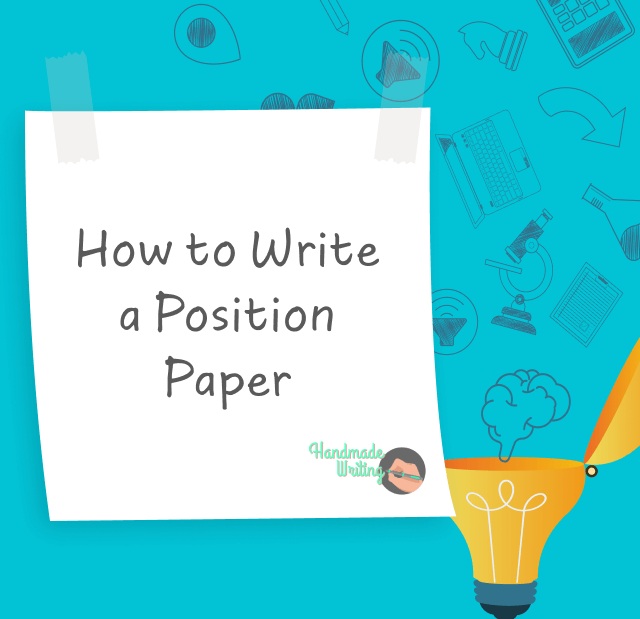
What Is Position Paper?
A position paper is a kind of essay in which you express your opinion or position regarding a particular subject matter. It can be used for different purposes, from a discussion of international challenges to an analysis of business strategies. As a result, a position paper format is widely used in business and politics. Also, it can take a form of a report revealing your plans for the subject matter at hand. A position paper should contain a smooth flow of thoughts and ideas that provide a rock-solid evidence for your line of reasoning.
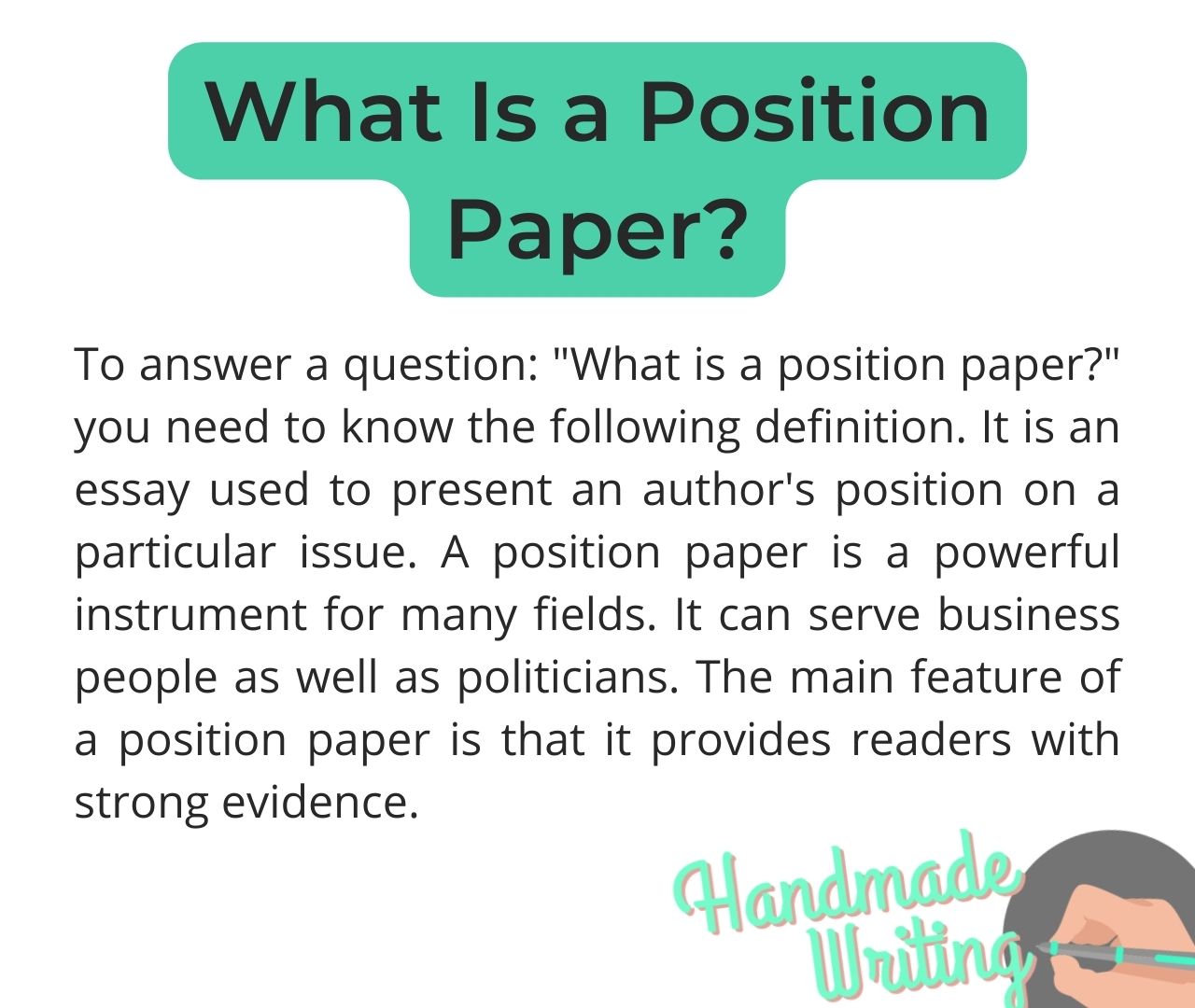
What Are The 3 Parts of a Position Paper?
A position paper consists of three main parts: introduction, body, and conclusion. Here is an explanation of what you can write in each part:
Introduction
The introductory part aims to attract the reader’s attention to the covered subject matter. Ideally, you should begin with several opening sentences about the specific issue to hook the reader.
The body part involves background information, evidence to back up your opinion, and analysis of both sides of the subject matter. By conducting thorough research, you will collect enough data to support your claims. The main point is to address both aspects of the argument. That way, you will show the reader that you are objective in your statements.
In the conclusion part, you need to restate the key points of your essay without adding anything new. Depending on your topic, it makes sense to suggest a solution to the problem.
How to Write a Position Paper?
To start writing a position paper , you should have a clearly stated topic that is debatable with logical details. While writing a paper, you should examine your vision of the problem through the prism of available arguments. Consider practicability, cost-effectiveness, and local environment when evaluating possible solutions and necessary actions. In other words, you should express, explain, and back up your opinion. And don’t forget to be specific in stating and supporting your arguments.
Select a Position Paper Topic
If you want to create a good position paper, you should focus on a subject matter that has enough findings to support it as well as some controversy to produce an argument. If you are dealing with a position paper assignment, you will want to skip your personal values and focus on something that can get you the highest grade. Here are some of the position paper topics to consider:
- Should reality TV shows be regulated?
- What are the positive and negative sides of video gaming?
- Are there any parallels between video gaming and addiction?
- Can beauty contests have a positive impact on women?
- Should children have a schedule for school and after-school activities or be given more free time for playing?
- What affects the rapid increase in child obesity?
- How to reduce the number of abortions without legislation?
- How can pro-life and pro-choice groups cooperate?
- Should the production of Barbie dolls be banned?
- What is the meaning of true beauty?
- Should young children be forced to compete at athletics?
- What are the reasons for blood cancer?
- How does COVID-19 pandemic affect the business sector?
- Is COVID-19 a real problem or a huge fake?
- How does COVID-19 affect our lives?
- Should media coverage be taken under control?
- Is private school tuition really worth it?
- How can the country’s school system be amended?
- What role should technology play in the business sector?
- Should college athletes receive a salary?
- Should college athletes be allowed to skip classes?
- Technologies are changing the way people think.
- How are online technologies affecting the way we live?
- What laws should regulate the use of cell phones in cars?
- Should parents limit teenagers’ use of social media?
- Should scientists be allowed to experiment on human embryos?
- What causes people to immigrate illegally?
- Is there any way to reduce the immigration rate?
- Can illegal immigration be justified?
- How do people justify war?
- How significant is race to American identity?
- What is the world culture?
- What is the value of knowing your cultural background?
- Should schools teach multiculturalism?
- Is global warming a problem?
- Is racism the problem of the modern community?
- How can clean water be provided to everyone?
- Is the problem of air pollution exaggerated?
- What needs to be done to reduce the level of air pollution?
- Who should take responsibility for air pollution?
- Will the worldwide population increase?
- What needs to be done to stop poaching of endangered species?
- Is hunting good for the environment?
- Are citizens responsible for their local environment?
- What can manufacturers do to reduce the air and water pollution across the world?
- What is the real importance of clean water?
- Is there any connection between health and pollution?
- What can people do to stop global pollution?
- How can people be encouraged to recycle more?
- How does global warming increase?
Preliminary Research
How do you write a position paper? Where to start from? Preliminary research requires you to find sufficient evidence for the covered subject matter. At the same time, you don’t need to rely on a subject matter that falls apart under a challenge of hefty research. You will also need to specify the sources you are planning to use. Follow them in bibliography and make some notes about every particular book, journal, or document you take information from. Thus, you will save a lot of time in the writing process.
By searching a couple of education and social sites, you will be able to find professional research data. Our professional essay writer recommends to narrow your focus, you will develop a list of questions that you have to answer in your paper. If you find no valuable information after spending several hours on research, you should understand that your position cannot be supported by sufficient findings on trustworthy sites.
Challenge Your Topic and Collect Supporting Evidence
You will need to dispute the truth or validity of your topic by finding supporting evidence. If you have some doubts, you may need some time to identify all the possible challenges that you have to deal with. Your position paper will address the opposing view and address it with counterevidence. It will make sense to have some discussions with friends, colleagues, or family about the topic. That way, you will be able to learn some additional thoughts and ideas that can be used for further research. As soon as you find some counterarguments, you will need to analyze them. Once it is done, you will see whether they are sound or not.
Another useful approach to challenging the topic requires you to mention your arguments on one side and opposing arguments on the other one. In which part of the paper do you have more points collected? Which points are stronger? If counterarguments seem to outnumber your arguments, you will have to reconsider your subject matter or your opinion on it .
Position Paper Outline
Before taking action, you’ll need to develop a position paper outline to organize your thoughts and ideas. With an outline, you will find it easier to write a position paper. So how will you do that? It depends on your personal preferences. Some writers find it easier to apply pictures and diagrams, others just follow a template offered by the teacher. If you feel like writing an outline yourself from scratch, don’t hesitate to do so. You can create it on your computer or write it down in your notebook. After all, there is no right or wrong approach to developing an outline. The main point is that an outline contains all the key points that you have to add to your position paper. You may want to look at a position paper sample before starting the writing process. Here is the format to be followed:
Decide on your topic with some background details. Develop a thesis sentence that addresses your position. Some examples are as follows:
- Smoking is a bad habit causing breathing problems.
- Fast food packages should be marked with health warnings .
- Air pollution requires certain actions from the national governments.
Decide on potential contradictions to your position. Here are some examples: :
- A medical examination needs to be conducted on an annual basis to monitor the possible negative health conditions .
- Health warnings can affect the companies’ revenues.
- The national program can be quite costly.
Cover the opposing points. Make sure that you aren’t contradicting your own thoughts and ideas. Sample points are as follows:
- It can be hard to determine the monitoring process.
- Citizens don’t want their government to abuse its power.
- Program funding will fall on the shoulders of average taxpayers.
Explain your position through the prism of counterarguments. This is how you can contradict some of the counterarguments and back up your own one. Sample points are as follows:
- The government has already tried to reduce smoking statistics in the country.
- Restaurants will enhance the quality of food in case of using health warnings .
- The government’s primary role is to protect citizens.
Sum up your arguments and express your opinion in different words. You should finish your paper by focusing on your arguments and responding to the counterarguments. You need your reader to understand and accept your opinion on the covered subject matter.
When you create a position paper, you should act with confidence. In the end, your mission is to reveal your position from the best side.
Tips on Writing a Position Paper from Our Experts
Even if you have a position paper example, you still may need some practical recommendations to make things easier for you. Here are some tips you need to follow during the writing process:
- Decide on a topic. While choosing the topic for discussion, you should find the one you have a clear idea of. You can broaden your outlook by reading some literature on the desired subject matter. Ideally, you should embark on different viewpoints to consider them for further analysis.
- Express your position idea. Focus on one specific aspect of the topic in order to express it in a one-sentence opinion. Make sure you have found a really arguable idea. If the topic cannot be debated, then it can hardly be used for writing a good position paper.
- Be precise in your statement. Try to express your opinion briefly and clearly. A position paper is not meant to be vague.
- Lead the narrative in the present tense. You are discussing the topic here and now, so the use of the past tense is quite inappropriate.
- Minimize the use of superlatives . Avoid using superlatives such as biggest, major, extremely, and so on because they make the context sound exaggerated.
- Use frequently used terms. To make the content look appealing and well-written , you should use the most common thematic terms such as world community, member states, recommendations, development, realization, regulations, international, and so on.
- Use commonly used verbs . You should include some commonly used verbs such as comprehend, enable, recognize, acknowledge, believe, suggest, consider, addresse, highlight, and so on.
- Proceed with final proofreading . You cannot consider your position paper as completed unless a successful spelling and grammar check is done. To achieve the maximum result, you should read your paper aloud a couple of times. That way, you will find it easier to indicate and fix mistakes.
While there is no universal formula for writing a perfect position paper, you can still follow some simple tips that’ll make you closer to the desired result. Just think analytically and act logically throughout the writing process.

A life lesson in Romeo and Juliet taught by death
Due to human nature, we draw conclusions only when life gives us a lesson since the experience of others is not so effective and powerful. Therefore, when analyzing and sorting out common problems we face, we may trace a parallel with well-known book characters or real historical figures. Moreover, we often compare our situations with […]

Ethical Research Paper Topics
Writing a research paper on ethics is not an easy task, especially if you do not possess excellent writing skills and do not like to contemplate controversial questions. But an ethics course is obligatory in all higher education institutions, and students have to look for a way out and be creative. When you find an […]

Art Research Paper Topics
Students obtaining degrees in fine art and art & design programs most commonly need to write a paper on art topics. However, this subject is becoming more popular in educational institutions for expanding students’ horizons. Thus, both groups of receivers of education: those who are into arts and those who only get acquainted with art […]
5 Steps to Writing a Position Paper
- Writing Research Papers
- Writing Essays
- English Grammar
- M.Ed., Education Administration, University of Georgia
- B.A., History, Armstrong State University
In a position paper assignment, your charge is to choose a side on a particular topic, sometimes controversial, and build up a case for your opinion or position. You will use facts, opinion, statistics, and other forms of evidence to convince your reader that your position is the best one. To do this, you'll collect research for your position paper and craft an outline in order to create a well-constructed argument.
Select a Topic for Your Paper
Your position paper centers around a topic that is supported by research. Your topic and position have to hold up when challenged, so it's helpful to research a few topics and pick the one you can best argue, even if it may not reflect your personal beliefs. In many cases, the subject matter and your topic are not as important as your ability to make a strong case. Your topic can be simple or complex, but your argument must be sound and logical.
Conduct Preliminary Research
Preliminary research is necessary to determine whether sufficient evidence is available to back up your stance. You don’t want to get too attached to a topic that falls apart under a challenge.
Search a few reputable sites, like education (.edu) sites and government (.gov) sites, to find professional studies and statistics. If you come up with nothing after an hour of searching, or if you find that your position doesn’t stand up to the findings on reputable sites, choose another topic. This could save you from a lot of frustration later.
Challenge Your Own Topic
You must know the opposite view as well as you know your own stance when you take a position. Take the time to determine all the possible challenges that you might face as you support your view. Your position paper must address the opposing view and chip away at it with counter-evidence. Consider having friends, colleagues, or family debate the topic with you to get alternative points of view that you might not have readily considered yourself. When you find arguments for the other side of your position, you can address them in a fair manner, and then state why they are not sound.
Another helpful exercise is to draw a line down the middle of a plain sheet of paper and list your points on one side and list opposing points on the other side. Which argument is really better? If it looks like your opposition might outnumber you with valid points, you should reconsider your topic or your stance on the topic.
Continue to Collect Supporting Evidence
Once you’ve determined that your position is supportable and the opposite position is (in your opinion) weaker than your own, you are ready to branch out with your research. Go to a library and conduct a search, or ask the reference librarian to help you find more sources. You can, of course, conduct online research as well, but it's important to know how to properly vet the validity of the sources you use. Ensure that your articles are written by reputable sources, and be wary of singular sources that differ from the norm, as these are often subjective rather than factual in nature.
Try to collect a variety of sources, and include both an expert’s opinion (doctor, lawyer, or professor, for example) and personal experience (from a friend or family member) that can add an emotional appeal to your topic. These statements should support your own position but should read differently than your own words. The point of these is to add depth to your argument or provide anecdotal support.
Create an Outline
A position paper can be arranged in the following format:
1. Introduce your topic with some basic background information. Build up to your thesis sentence , which asserts your position. Sample points:
- For decades, the FDA has required that warning labels should be placed on certain products that pose a threat to public health.
- Fast food restaurants are bad for our health.
- Fast food packages should contain warning labels.
2. Introduce possible objections to your position. Sample points:
- Such labels would affect the profits of major corporations.
- Many people would see this as overreaching government control.
- Whose job is it to determine which restaurants are bad? Who draws the line?
- The program would be costly.
3. Support and acknowledge the opposing points. Just be sure you aren't discrediting your own views. Sample points:
- It would be difficult and expensive for any entity to determine which restaurants should adhere to the policy.
- Nobody wants to see the government overstepping its boundaries.
- Funding would fall on the shoulders of taxpayers.
4. Explain that your position is still the best one, despite the strength of counter-arguments. This is where you can work to discredit some of the counter-arguments and support your own. Sample points:
- The cost would be countered by the improvement of public health.
- Restaurants might improve the standards of food if warning labels were put into place.
- One role of the government is to keep citizens safe.
- The government already does this with drugs and cigarettes.
5. Summarize your argument and restate your position. End your paper focusing on your argument and avoid the counter-arguments. You want your audience to walk away with your view on the topic being one that resonates with them.
When you write a position paper, write with confidence and state your opinion with authority. After all, your goal is to demonstrate that your position is the correct one.
- Tips on How to Write an Argumentative Essay
- How to Write a Persuasive Essay
- Writing an Opinion Essay
- How to Write a Research Paper That Earns an A
- Choosing a Strong Research Topic
- Preparing an Argument Essay: Exploring Both Sides of an Issue
- The Five Steps of Writing an Essay
- What Is Expository Writing?
- How to Write and Structure a Persuasive Speech
- Definition and Examples of Analysis in Composition
- Tips for Writing an Art History Paper
- Persuasive Writing: For and Against
- Write an Attention-Grabbing Opening Sentence for an Essay
- How To Write an Essay
- How to Write a Solid Thesis Statement
- Ethos, Logos, Pathos for Persuasion
How to Write a Position Paper: Step-By-Step Guide with Examples
Learn how to write a position paper with our step-by-step guide, including topic prompts and example papers.
A position essay or research paper is a paper that requires you to take a position on a controversial subject or question. Often, these papers cover argumentative essay topics that evoke emotion, like illegal immigrants, climate change, violent video game age rating or animal testing.
Your position on the topic because your topic sentence and the rest of the paper or essay back up your point with your research. A high-quality position essay will conclude with a final push toward getting your audience to believe your topic sentence based on the research you present.
You must have the right topic to write a position paper that will persuade an audience to your point of view. These position essay topics will get you started on your research. For help with your essays, check out our round-up of the best essay checkers .
How to Write a Position Paper?
A. is cloning humans to help with medical procedures ethical, b. should covid-19 vaccinations be mandatory, c. is cheerleading a sport, d. should the minimum wage be raised, step 2. conduct preliminary research, step 3. write your thesis, step 4. create an outline, step 5. write a draft , step 6. review and write, 1. the death penalty has no place in america by anthony langdon, 2. universal healthcare provides americans the security needed in uncertain times by jeremy c. kourvelas, 3. should sex education be taught in schools by peter dewitt, 4. we are the ones failing our teens, not social media by emma mccarthy, 5. communication is key to a successful roommate relationship, 6. the growing demand for limits on speech in academia.

Step 1. Pick a Topic

The purpose of a position paper is to pick a side of a question and aim to convince the reader of the writer’s stance by using research data to back up their views. Choosing a topic is the first step to writing a position paper.
Sometimes, your high school teacher or college professor might have assigned you a topic. But if you’re choosing your own topic, you can begin the process by considering your academic interests or deciding on a specific industry.
You can brainstorm topic questions from here by narrowing in on one section of your chosen interest. For example, if you’re writing about sports, you might choose to write about cheerleading as a sport. Whether you believe that cheerleading is a sport or whether you believe it’s not – you can use the paper to prove your point. Check out these position paper prompts to help you:
The ability to cline humans still hasn’t made it to reality , but the question is there. Would it be ethical to clone humans for help with medical procedures, such as organ transplants? This question raises a few concerns, including the ethics of experimenting on a newly created clone and the general ethics of cloning a replica of another person.
Discuss this important question in your argumentative essay. Back your choice with facts found in your research. For this topic, you don’t have to research the science behind cloning, just its ethics, so you can do the piece even if you don’t fully understand its science. Check out our explainer on how to write a thank you letter .

As we near the end of the pandemic, many people wonder whether or not COVID-19 vaccinations should be required by law . Some claim that vaccination is for the greater good and is something everyone should do, while others state that it should be a personal choice.
If you argue for mandated vaccines, consider whether or not there should be exceptions to this rule. If you decide to argue against it, be prepared to show other measures society can take to slow or stop the spread of the virus.
Ask any cheerleader, and you will get an emphatic “yes” to this question. Cheerleading is physically demanding and often requires careful diets and exercise routines to find success.
Yet others will argue that cheerleading is not a sport because it is not a competition in the way that basketball or soccer are. You can argue either way based on your opinion after doing the research. You might also find our headings and subheadings examples helpful.
Federal labor laws have the minimum wage set at $12 an hour . Yet, this is not enough to live off a full-time income in many parts of the country. You could argue whether or not the minimum wage should increase to accommodate inflation.
Here’s the problem with that argument, which you should also consider. If you raise the minimum wage, you will have increased inflation to accommodate the higher labor costs. This can backfire, preventing you from enjoying the benefits of higher base pay.

Position papers use evidence to support the claims and to persuade the reader to join their stance on the chosen topic. It’s essential to use supporting evidence for your statements and to supply background information when writing your paper.
Gather evidence from reliable and credible sources to support your point of view and make a compelling argument to convince the reader. Doing this before writing your arguments and counterarguments is a great way to make writing easier and complete a good position paper.
Remember to include citations in your paper. Failing to include citations can put you at risk of being penalized for plagiarism. Also, ensure you use the correct format, such as MLA or APA. If you’re unsure of the citation style to use, check with your teacher or professor. You might also find our guide on how to write a case study useful.
Once you’ve decided on your topic and stance and gathered your preliminary evidence, it’s time to write the thesis statement! The thesis statement is a summary sentence that states your position on the topic and includes your key supporting evidence. Place your thesis statement after your introductory paragraph to help readers understand the main parts of your argument.

Use your thesis statement and notes to create a template and outline your argument. To do this, split your page into sections for the introduction, body, and conclusion.
- Introduction: Introduce the topic and your position on the topic chosen for the paper. Include background information on the chosen topic, and explain why the topic is important to you.
- Body: This section should include your arguments and claims with supporting evidence. Split your content into body paragraphs for each point of your argument, and include supporting evidence and counter arguments to support your stance. The body is the most important part of your paper, so make sure to include as much information on the subject matter as possible and use all of your research. Short position papers usually include three body paragraphs, but longer papers may have multiple sections and several body paragraphs.
- Conclusion: The conclusion of a position paper is used to highlight the key points of your argument, emphasize your stance, and summarize your paper in a way that is compelling to the reader. Use a conclusion as an opportunity to leave a lasting impact on the reader and finish strong.
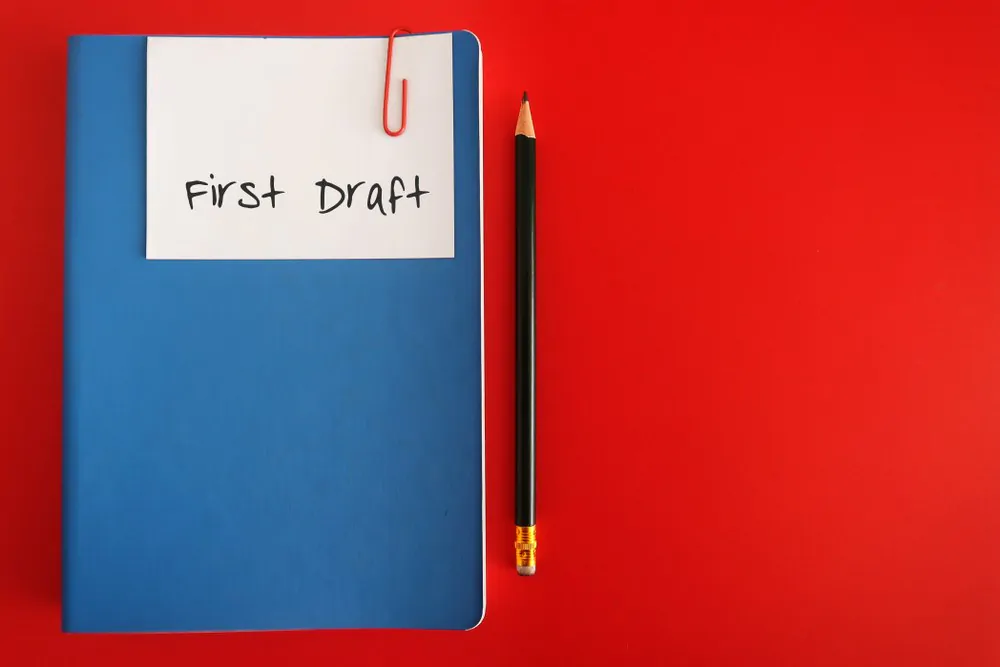
Write the first draft of your position paper using the outline template and bulk up the content with your research and arguments. Creating a draft is a great way to get into the flow of your paper and not get hung up on the details of writing. Use this as an opportunity to get your ideas on paper.
A great way to approach your draft is to add your evidence to each section of your outline template and build your content around the research. Once you’ve outlined the main points and counter arguments, you can work on bulking up the content.
Review your final draft and fill out your paper by adding emotive language, supporting your arguments with contextual information, and fully explaining your research data. Once you’ve completed your paper, it’s time to proofread and review your work. A great way to review your work is by using an AI assistant like Grammarly to tidy up the grammar, improve readability, and ensure your points resonate with the reader. Check out our Grammarly review !
Position Paper Examples
“Racial bias is obvious throughout our prisons and police departments, so it tracks that capital punishment is afflicted, as well. Katherine Beckett and Heather Evans studied the role of race in Washington state’s capital sentencing from 1981 to 2014 and found that, controlling for all other legal factors, Black defendants were four and a half times more likely to be sentenced to death as non-Black defendants.” Anthony Langdon
In this article, Langdon discusses his opinion that the death penalty should not be part of the American justice system. He cites problems with racial bias as a reason for this belief.
“Universal healthcare would free small business owners from having to provide coverage while simultaneously enhancing the freedom of the worker. Lifespans could be longer, people could be happier and healthier in systems that are simpler and more affordable.” Jeremy C. Kourvelas
In this piece, Kourvelas discusses the benefits of universal healthcare for Americans and the economy. He uses these benefits to show how, in his opinion, universal healthcare is the right choice for Americans.
“Thinking about sex education conjures up all of those uncomfortable moments as an adolescent when we had to sit at our desks and listen to our health teachers talk about things that we joked about with friends but never wanted to have a conversation about with adults. But things have changed a lot since then.” Peter DeWitt
As a former public school principal, DeWitt has a strong opinion on this topic. In this opinion piece, he looks at how middle school and high school students benefit from sex education in school and what people should consider when discussing this topic.
“It’s no secret that social media is taking a toll on teenagers, especially girls. Filters and photo editing create the facade of a seemingly perfect life and put an emphasis on unrealistic beauty standards and constant comparison. This often leads to decreased self-esteem and to body image concerns.” Emma McCarthy
There’s no denying that social media use by high school and college students is creating a mental health crisis. Still, in this article, McCarthy argues that the lack of parental and educator input into young people’s lives may have the most significant impact. She claims that a lack of education about how teens use social media among adults is the biggest problem.
“We respected each other by setting boundaries. We discussed when we typically went to bed during the week and then decided when to turn the lights out. We also always asked if it was okay to have a visitor, to borrow personal belongings or to call family. Our constant conversation allowed us to start off our college dorm experience seamlessly, as we both agreed to be honest with each other.” Maggi Abboud
Moving out of home is tough, but it becomes even tougher when you realize it’s time to navigate roommate relationships. In this position paper example, Maggi Abboud discusses the importance of creating a healthy relationship with her roommate through communication. She states that setting clear boundaries at the start of college helped them maintain respect and build a positive relationship with respect.
“The protection of free speech on campus should not be valued over the protection of students from the possible harm that the content of this speech may cause. In college, students are still learning who they are and how to love themselves and they should be free to grow into their identities without shame or embarrassment.” Sophia Eppley
Sophia Eppley believes that the protection of free speech should not be valued over the protection of students at University campuses. Georgia House Bill 1 was passed in 2022, which removed any restriction of free speech by making every accessible, common area on a college campus a free speech zone. Although free speech is arguably a positive thing, it’s important to remember that free speech also allows the freedom of those with controversial ( and often offensive) opinions to speak freely. This position paper example gives great insight into the experiences of students who face challenging confrontations by free speech activists.
Looking for more? Check out our round-up of informative essay topics !

Meet Rachael, the editor at Become a Writer Today. With years of experience in the field, she is passionate about language and dedicated to producing high-quality content that engages and informs readers. When she's not editing or writing, you can find her exploring the great outdoors, finding inspiration for her next project.
View all posts
What Is a Position Paper – Free Writing Guide for Beginners

Academic writing covers all course units in the form of different essay types. A position paper is a type of essay where the writer provides concrete opinions relating to a certain study. The writer can express their own opinion or from another credible source. These essays are applicable in various fields such as academics, law, and political affairs, among other disciplines.
Since this assignment focuses on argumentation, most students might find it challenging to develop exceptional essays. Writing it well needs intense planning, research, and meticulous writing skills. That is why college students turn to professional services to get expert assistance.
This article discusses essential aspects that offer insight into how to write a position paper and things to consider to get remarkable results.
Table of Contents
5 Things to Consider Before Writing a Paper
What is a position paper ? It is imperative to comprehend its definition before we embark on the writing phase. Learners often think that a position paper is a regular report, but it comprises one-sided argumentation from the writer’s perspective.
Express your standpoint to the readers through adequate research and presentation of findings from other published works.
However, before you embark on the writing phase, below are a few factors you must consider to compose a remarkable product.
Understand the Topic
Read the essay question carefully to understand the paper’s expectations. Ensure you comprehend the topic before you pick an argumentative side. If you don’t understand the topic, you might argue irrelevant points that might jeopardize your entire paper.
Research Sources
Conducting extensive research is a crucial aspect that allows you to get relevant resources. It is essential to have an arguable topic with a broad perspective. You can use online sites, the public library, or other available resources.
Intend Audience
Who are the target readers? Having the audience in mind will help you compose relevant opinions that will convince them to back your perspective. Make sure you also know where the audience stands.
Pick Your Standpoint
It is essential to choose a standpoint after reading through the essay question. Picking a stand will allow you to organize your thoughts and see whether they are sufficient to back your arguments.
Deliberate Arguments
Evaluate the argument thoroughly and weigh the upsides and downsides. Make sure your stand has strong arguments to give you the upper hand in persuading the audience.
Position Paper Example – Get Creative First
A position paper example, in this case, will help you learn more about the contents of each section. It would help if you organized you articulated your thoughts in a logical and transitional flow to ensure your readers follow through with the entire text.
Below is a guideline to use as an example when composing a position paper.
1. Introduction
- Topic introduction
- Background information
- Thesis statement
2. Body Paragraphs
- Counter argument
– Supporting evidence
– Refute counter-claims
– State your argument with evidence
- Your perspective
– Present your opinion
– Evidence
– Reliable resources
3. Conclusion
- Summarize main arguments
- Offer solutions
- Avoid adding new information
Position Paper Format: APA, MLA, and Other Styles Explained
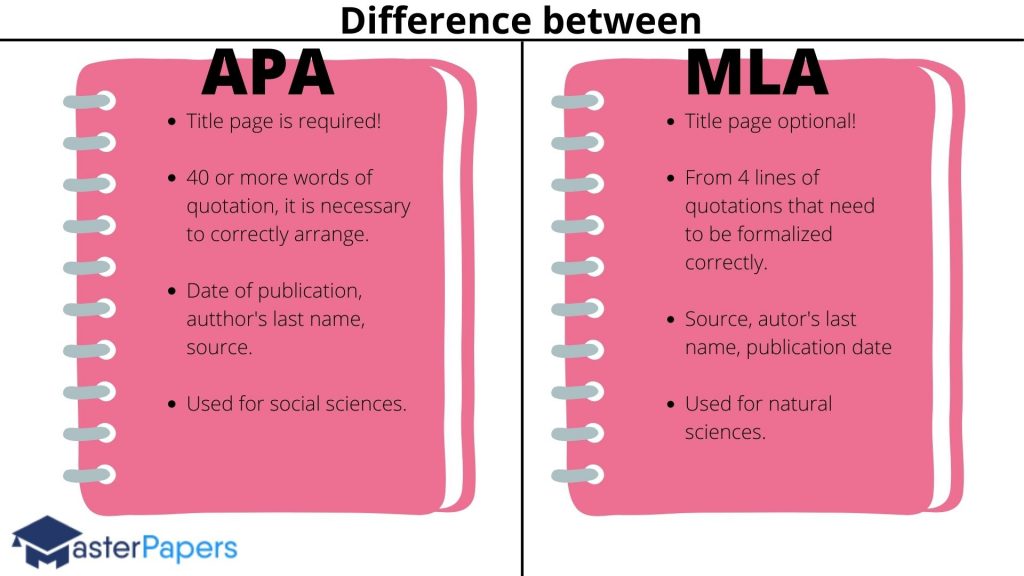
Academic writing has various formatting styles that students must learn to incorporate in the various essays. How do you know the required style? Usually, the essay instructions have the specified format expected from the students. Therefore, if you are unsure, you can consult with your tutor on the required formatting style. The most common styles are APA, MLA, and Chicago formatting styles. Each style is unique and has subtle differences from the rest.
When citing a position paper, format APA is usually recommended by scholars. In this style, you start with the author’s name, publication year, title name, location, and publisher’s name. You must note the comma, full stop, and semi-colon placements to avoid compromising the citation rules.
It is imperative to learn more about the formatting styles to know which style is the best for a particular essay.
How to Start a Position Paper Like a PRO
Starting any academic paper is a tricky section since it is critical to determining its direction. Therefore, students must know how to start a position paper to capture to keep it interesting.
The first step is to introduce your topic with captivating hook sentences that inform the audience about the topic. Research comprehensively and come up with background information about the research issue and explain why the investigation is essential. Not forgetting to formulate a relevant thesis statement to guide the audience.
To engage readers, your introduction sentence can be in a question form that invokes curiosity. You can also add a thought-provoking statement that leaves the reader with an excellent first impression. Or a quote from a reputable scholar that relates to the research topic.
The body comprises three to five paragraphs with the arguments. You can start the body paragraph by generating the counter-arguments first. You can do this by stating what people who disagree might say about your position. Present your arguments and disprove the counter-claims objectively with factual information. For each argument, ensure you provide supporting evidence from reliable sources.
Finally, compose a conclusion paragraph that reiterates your main argument and offers a recommendation. However, don’t introduce new ideas or arguments in this section.
If you are still stuck and don’t know how to write a position paper , you can seek professional help from our academic experts. We guarantee you top-notch essays that will score you top-of-the-class grades.
FAQ on How to Write a Position Paper
Read the detailed FAQs below to help you make an informed decision about our writing services.
How do you start an introduction for a position paper?
Make sure you capture the readers’ interest by using hook sentences. You can pose a captivating question, interesting quote, or introduce a strong declaration that will evoke curiosity to continue reading the essay.
How do you outline a position paper?
A position paper is similar to a standard academic paper. It has an introduction section that reveals your position, which captures several arguments, and the conclusion section summarizes the major research points.
How important is the position paper in an academic setting?
Position papers are significant in academics because it helps students discuss different topics without having the original research. It presents various opinions and perspectives with supporting evidence of the subject matter.
Why is it essential to make a reliable position paper?
It is vital to craft an accurate paper with factual information because the primary purpose is to persuade the readers to understand your opinion through your arguments.
Don’t Understand a Thing? Contact Us for Help!
Need help to write an outstanding position paper? You are on the right platform. We have dedicated experts working round the clock read to deliver flawless papers. Excellence is a paramount aspect of our service since we guarantee exceptional essays that will score you super grades.
If you are still asking yourself, “what is the purpose of a position paper?” then you need immediate academic assistance. Why stress yourself with detailed research and argument presentation? We hire skilled authors with years of experience in the academic writing industry. Each writer writes the orders from scratch without lifting content online. Therefore, you will submit 100% original essays without a doubt.
All you have to do is reach out to us, and we will match you with a qualified writer to help you compose a top-notch paper. Contact us now and transform your grades.

15% OFF Your first order!
Aviable for the first 1000 subscribers, hurry up!
You might also like:

150 Qualitative and Quantitative Nursing Research Topics for Students

Why You Should Read a Data Gathering Procedure Example

What Is Culture and What Are Some Popular Culture Essay Topics?
Money-back guarantee
24/7 support hotline
Safe & secure online payment

- Customer Reviews
- Extended Essays
- IB Internal Assessment
- Theory of Knowledge
- Literature Review
- Dissertations
- Essay Writing
- Research Writing
- Assignment Help
- Capstone Projects
- College Application
- Online Class
How to Write a Position Paper Outline the Right Way in 2021
by Antony W
September 5, 2021

A position paper outline provides guidance and structure for students to write a position paper the right way . A good outline will summarize the content you want to include in your essay and organize it in a coherent and sensible structure.
The ability to outline a position paper is an important skill because some lecturers will ask for an outline first before they give you the permission to choose a position paper topic and write the paper.
So in this article, we give you a guide on how to come up with an appropriate position paper outline.
And if you need help with your position paper, place your order here and we’ll help you get the assignment done in good time.
How to Write a Position Paper Outline
Carefully read the assignment guidelines.
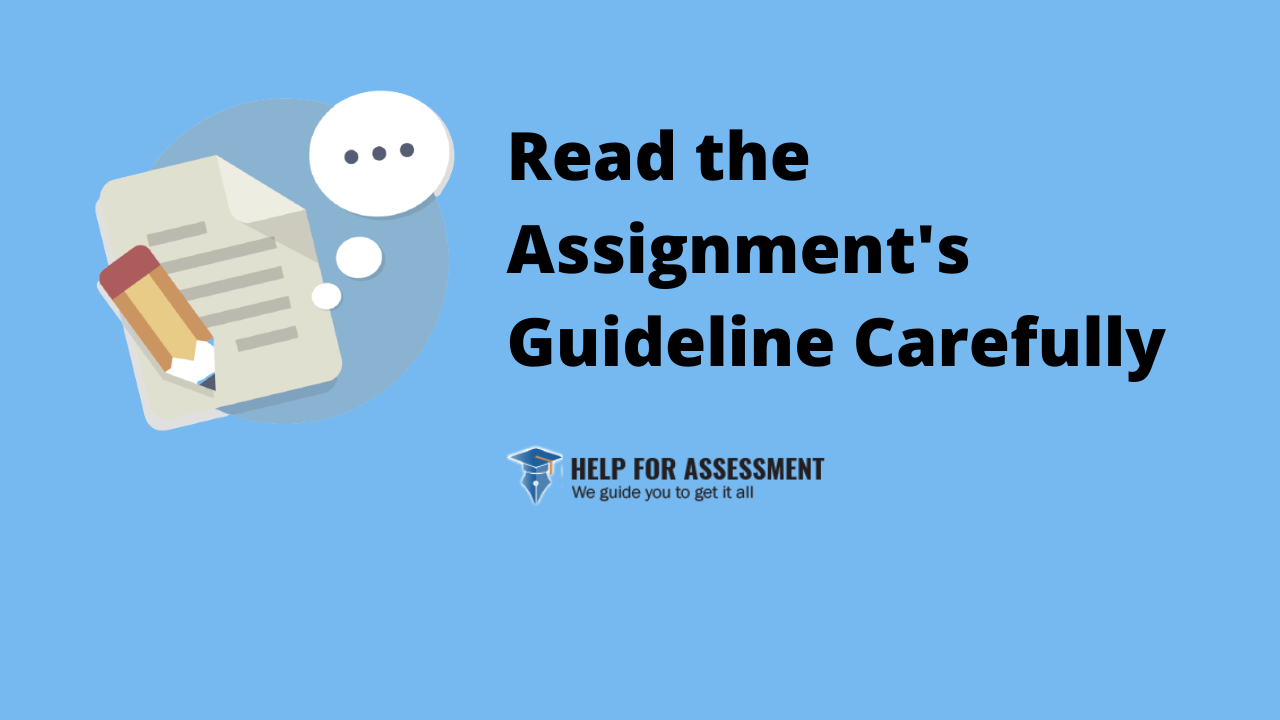
Go through the guidelines and mark any important phrases and words in the instructions. It’s important to understand what your instructor wants before you begin to draft your outline.
If you realize that anything is vague or unclear, ask for an explanation.
Develop a Topic
While there is no doubt that outlining a paper is a great way of developing and organizing your ideas, it may be important to do some form of prewriting to start. Below are a few useful prewriting strategies that will help you get ideas for the paper you want to write.
- List all the ideas you think of and then group similar ideas on one side. You can expand on the lists by adding more ideas or using other prewriting activities.
- Free writing : This involves writing non-stop for roughly 10 minutes. Just write anything that comes to your mind and when you have finished, go through what you have written and underline the information that you think is most useful.
Identify Your Purpose
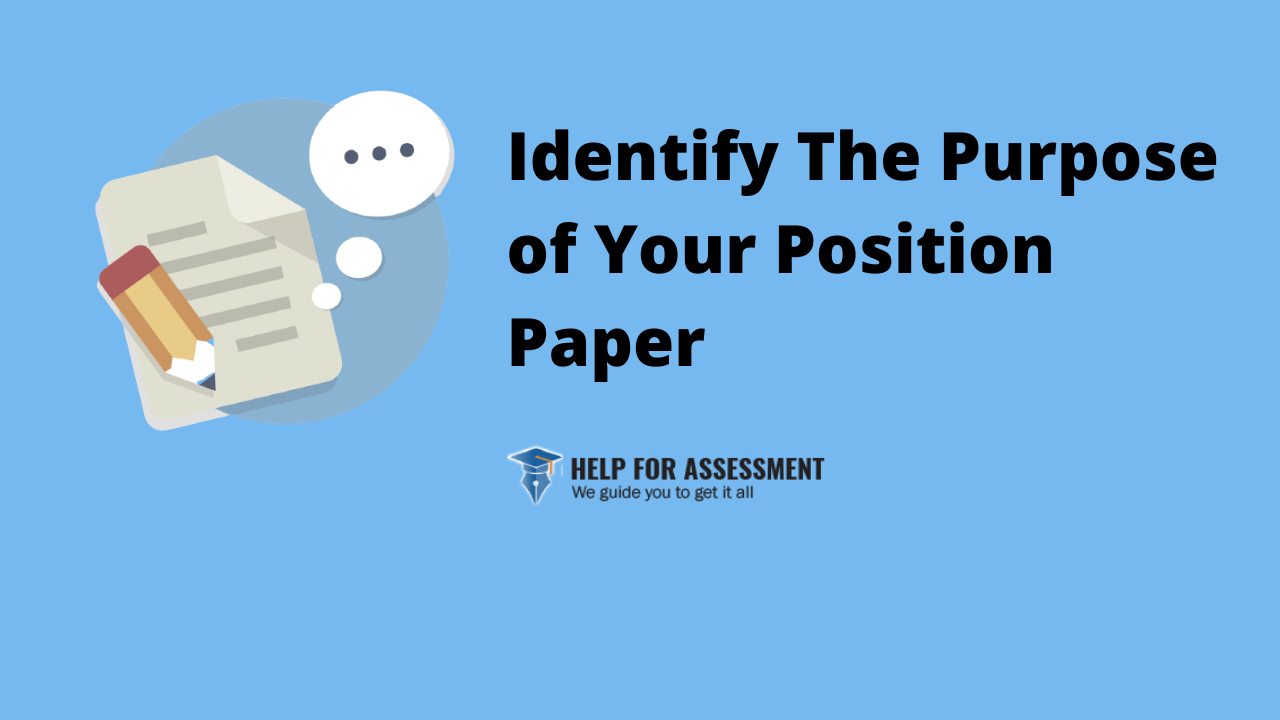
What do you aim to accomplish with your position paper? Do you want to persuade, enlighten, and entertain? Or is there something else to it?
Knowing the purpose of your essay is important as it helps you to get ideas on how to proceed with your outline.
You only need to ensure that your purpose doesn’t clash with the assignment requirements. Read the assignment and identify the keywords that will help you to identify what your purpose is.
Develop Your Thesis Statement
After developing your ideas and considering your purpose for the essay, you are now ready to embark on writing a thesis statement .
Well-crafted essay statements will effectively express the main focus of a paper and also present an arguable claim. Your thesis statement shouldn’t exceed one sentence in length.
Ensure that your thesis is arguable. You can achieve this by avoiding to state matters of facts or tastes.
For instance, “America is the Greatest Nation on Earth” wouldn’t be a particularly good position paper topic since most people would agree that it is. Similarly, “Football is a great sport” shows a matter of taste and it wouldn’t work.
Your thesis statement also needs to provide enough detail. Do not just write that something is effective or good. Instead, focus on what makes it good or effective.
Decide on the Structure and Style of your Outline
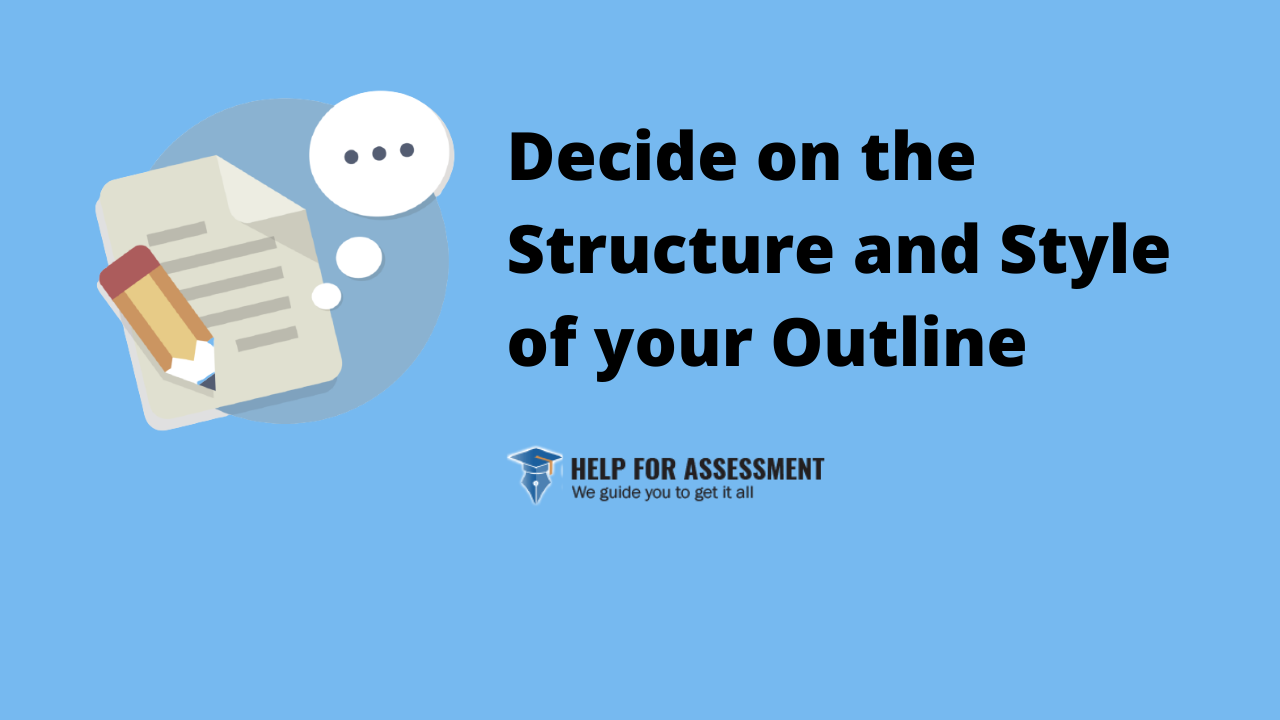
Choose a Standard Alphanumeric Structure. This is the most common structure of an outline and is the one that’s easily recognized. Roman numerals, Arabic numerals, uppercase, and lowercase letters.
Decimal Outline Structure shows the relationship between our ideas. A decimal structure is nearly the same as an alphanumeric structure but uses numbers in identifying each subsection. This structure is preferred by some people because it shows how each part is contributing to the position paper as a whole.
Determine whether you are going to use brief phrases or full sentences in your outline
Full sentences are more useful in most position paper outlines because they let you write more thorough information. If your instructor asks to be given the outline, it becomes even more important to use full sentences.
Coordinate section titles and secondary subsections. Make sure that each section title features information that is of equal importance to the other titles of sections. Similarly, subsections should carry less important information than that in the section titles.
Break down each heading into two at least two parts. For each section to have adequate information, it will need to be broken down into 2 or more parts.

Organize the Information in Your Outline
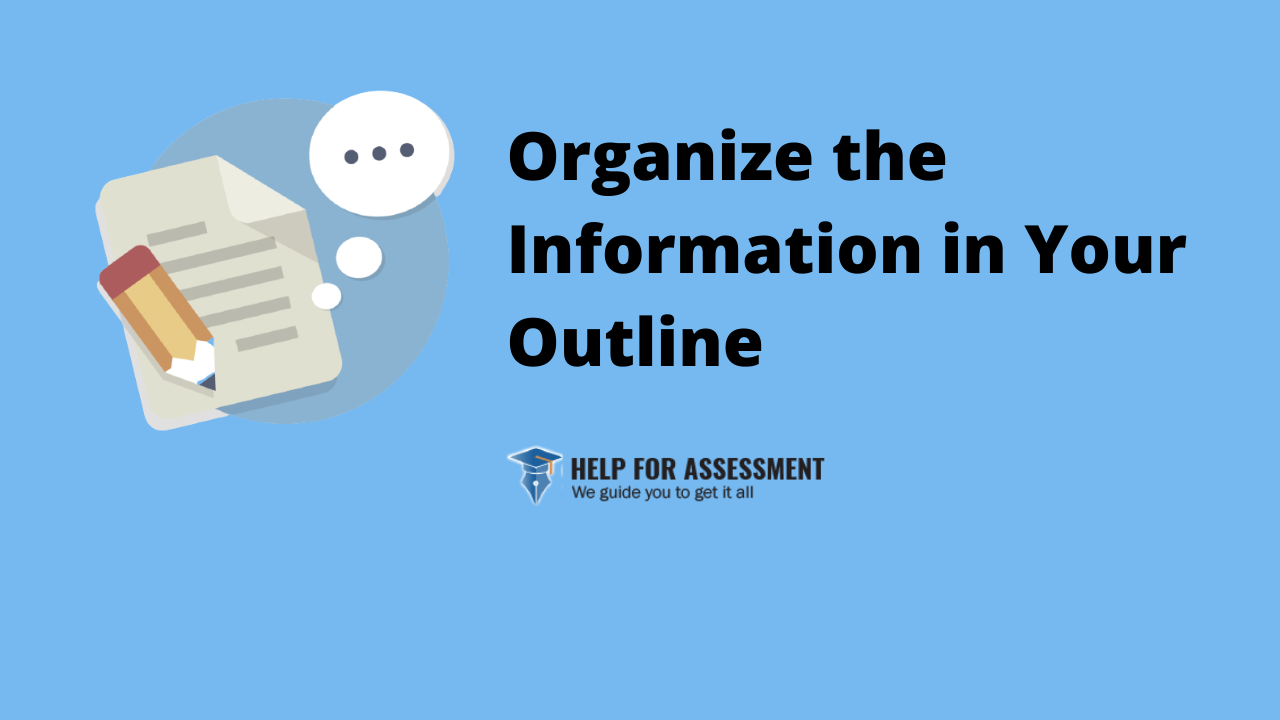
Write an Introduction in the first part of your outline. The introduction hooks the reader and provides a brief overview of the topic.
The info you provide in this part should become more specific as you move to the subsections. The thesis statement should be the last of your subsections in the introduction.
Provide body information in the next outline section. Naturally, the essay body is the largest part of your paper and so you should devote a minimum of three subsections to this part of your outline.
Write a Conclusion
The last part of your outline needs to provide conclusion information. It should generally return the reader to the discussions you broached up in the introduction part.
- Restate your thesis. You don’t necessarily need to copy it word-for-word. You are free to rephrase it in another way.
- Conclude. A concluding statement usually discusses the thesis implications, suggests solutions to issues raised, and explains how important the thesis to something that is outside the essay range.
Compare Your Work Against the Assignment Sheet
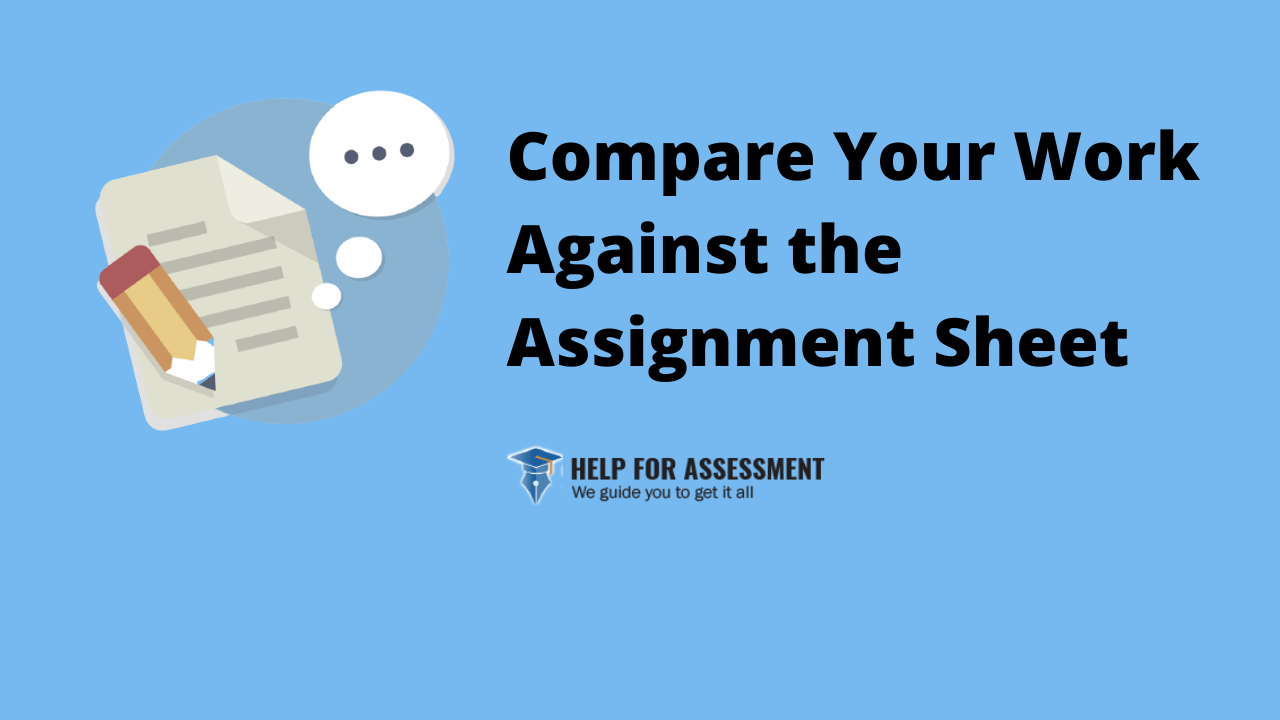
It is a good idea to go back to the rubric to ensure that your outline fulfills all the requirements.
Check doubly to ensure your outline satisfies the expectations of the instructor to get the best marks.
Creating a position paper outline can be a great strategy before you start writing your paper. This is because it organizes your thoughts and allows you to write much more progressively and clearly.
When written properly, an outline provides an overview or summary of the logic and order that your position paper must follow.
Creating a great outline will also be important especially if it’s a requirement that you submit it to your instructor. Therefore, it’s in your best interest to learn the skills of writing a good position paper outline. A position outline should have the introduction, body, and conclusion.
About the author
Antony W is a professional writer and coach at Help for Assessment. He spends countless hours every day researching and writing great content filled with expert advice on how to write engaging essays, research papers, and assignments.

Position Paper
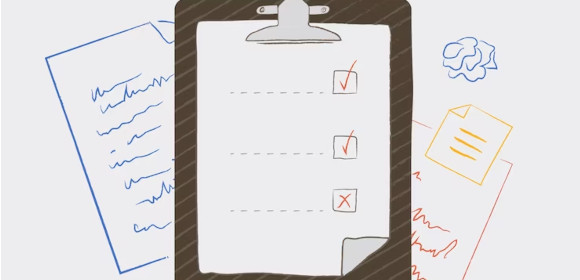
[bb_toc content=”][/bb_toc]
1. Sample Position Paper
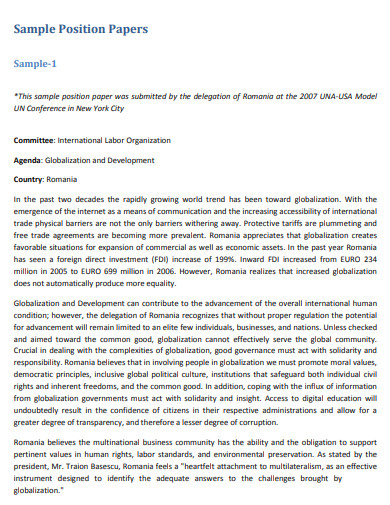
Size: 382 KB
2. Position Paper Format
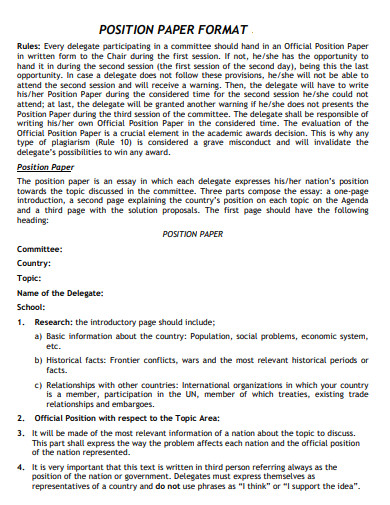
Size: 351 KB
3. Student Position Paper Example
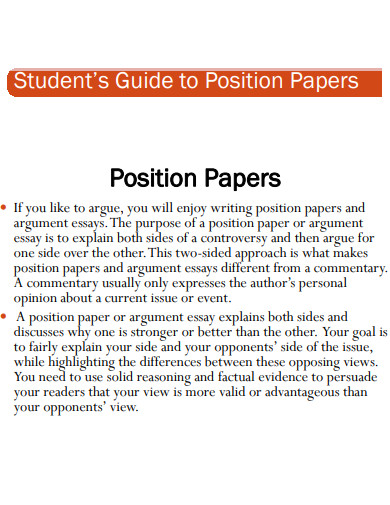
Size: 388 KB
4. High School Position Paper Example
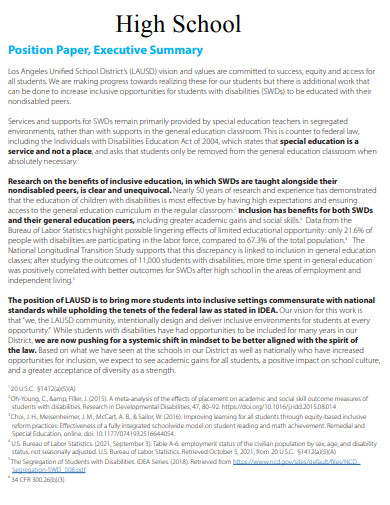
5. Position Paper Outline Example
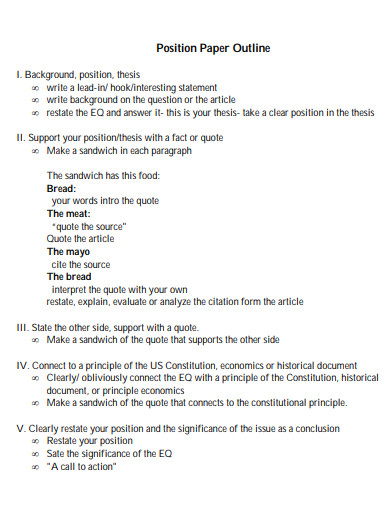
6. Education Position Paper Example

Size: 950 KB
7. Position Paper Introduction Example

Size: 140 KB
8. Position Paper Template
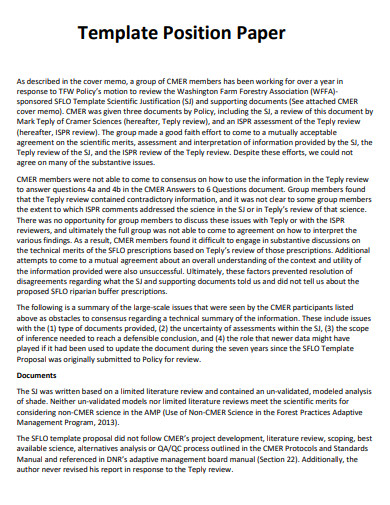
Size: 563 KB
9. Poverty Position Paper Example
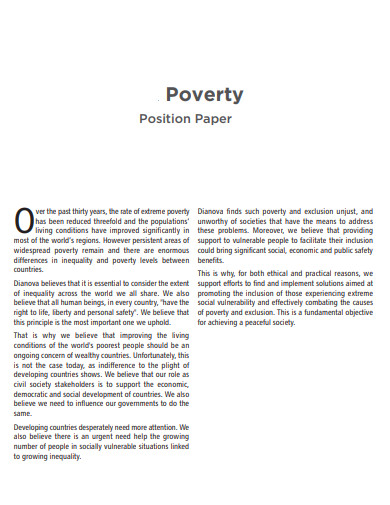
Size: 156 KB
10. Position Paper Essay Example
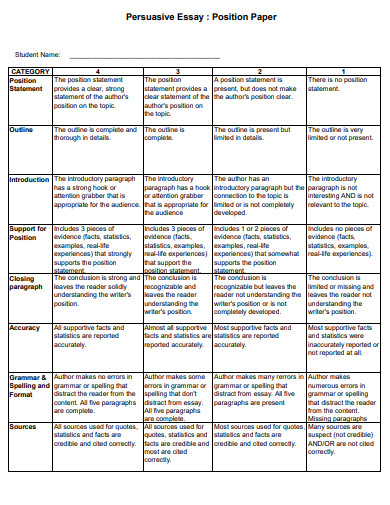
Size: 11 KB
11. Position Paper Bullying Example
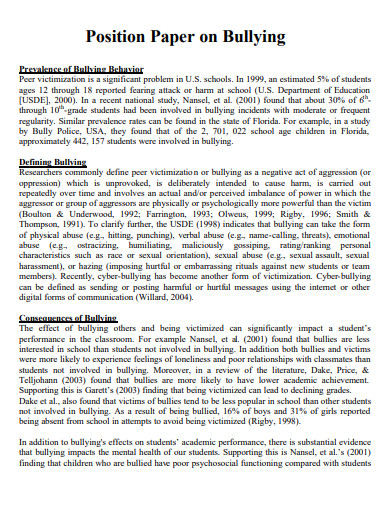
Size: 22 KB
12. Position Paper Teenage Pregnancy Example
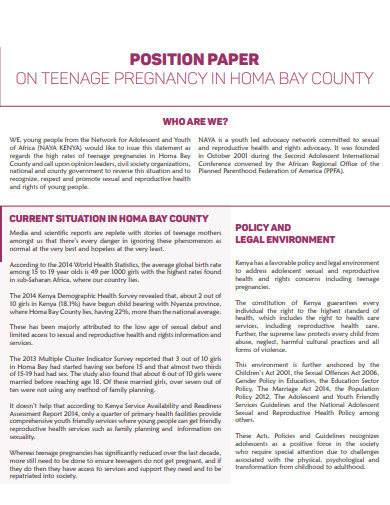
Size: 92 KB
13. Position Paper on Depression Example
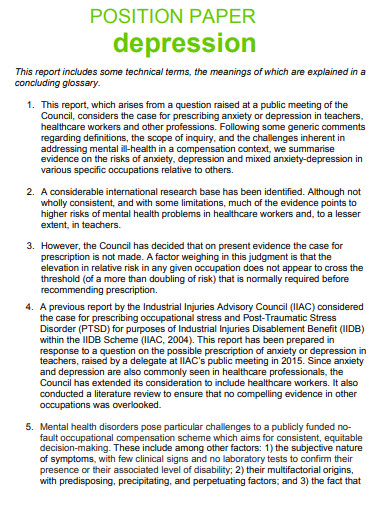
Size: 225 KB
14. College Position Paper Example
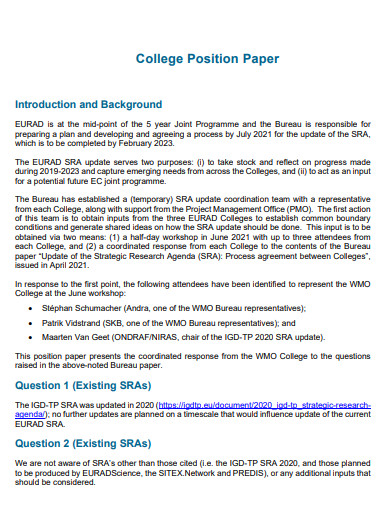
Size: 311 KB
15. Position Paper on Business Example
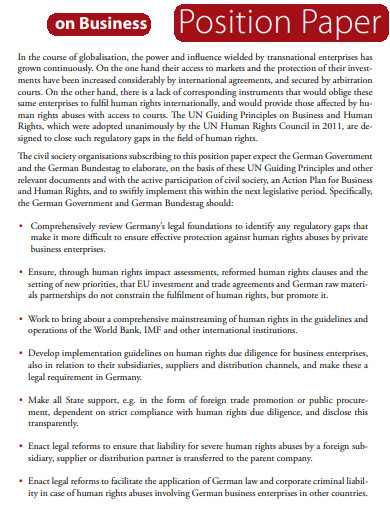
Size: 703 KB
16. Research Position Paper Example
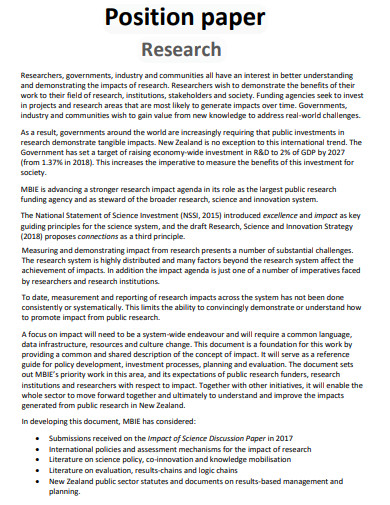
17. Mental Health Position Paper Example
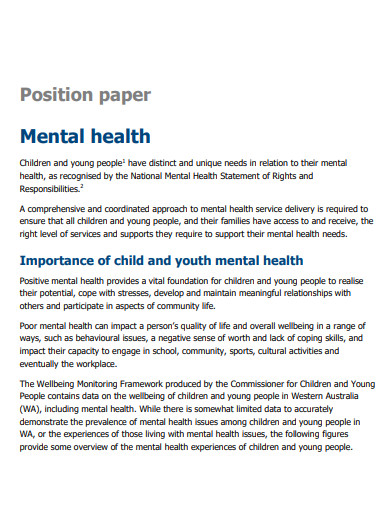
Size: 355 KB
18. Position Paper on Social Media Example
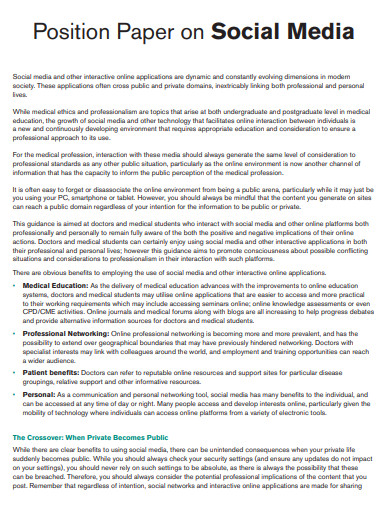
Size: 125 KB
19. Law Position Paper Example
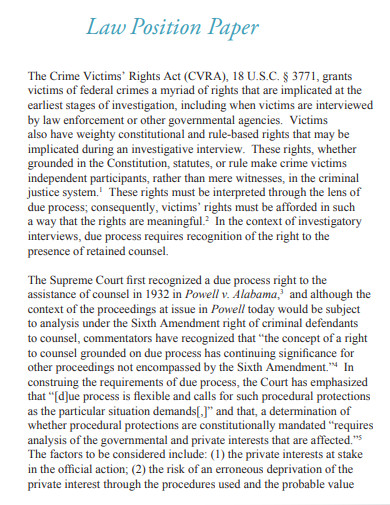
Size: 273 KB
20. Early Pregnancy Position Paper Example
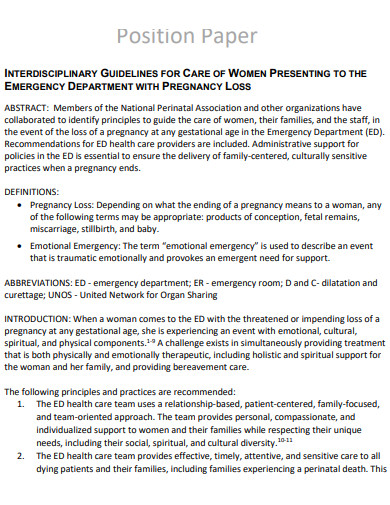
Size: 566 KB
21. Position Paper Argument Example
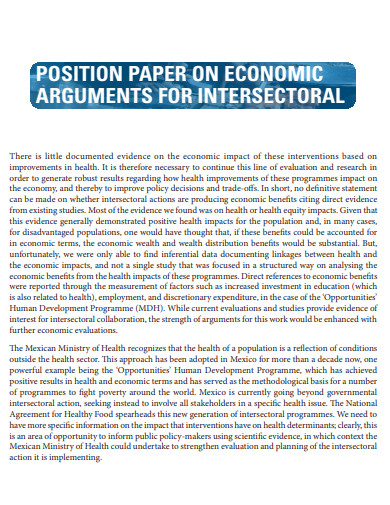
22. Writing a Position Paper Example
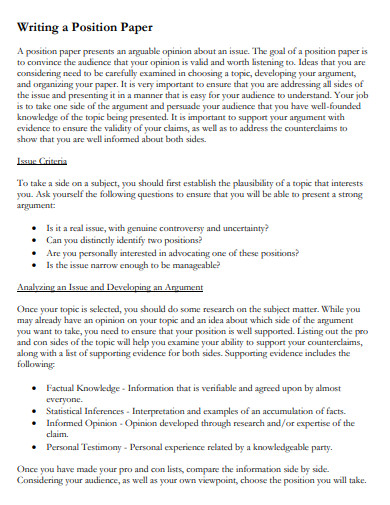
Size: 73 KB
23. Position Paper Guide Example
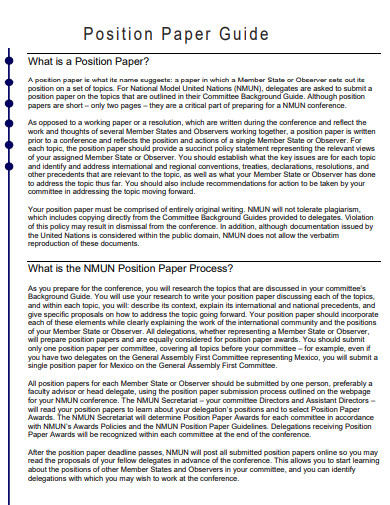
24. Simple Position Paper Example
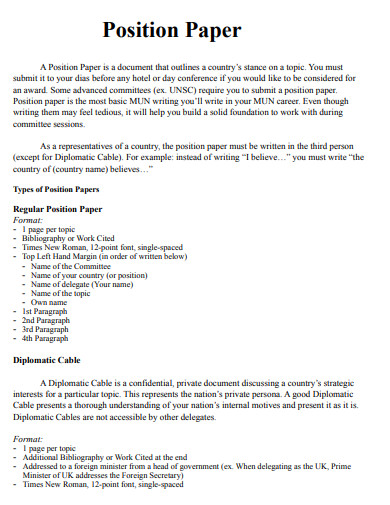
Size: 767 KB
25. Basic Position Paper Example
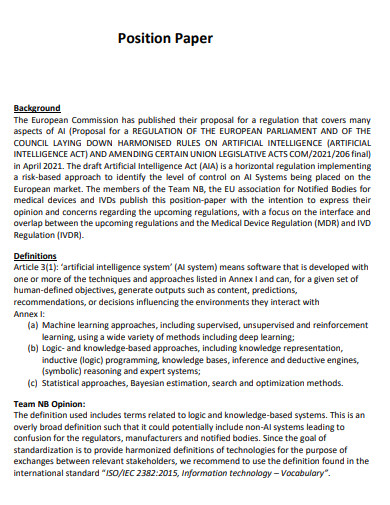
Size: 181 KB
26. Standard Position Paper Example
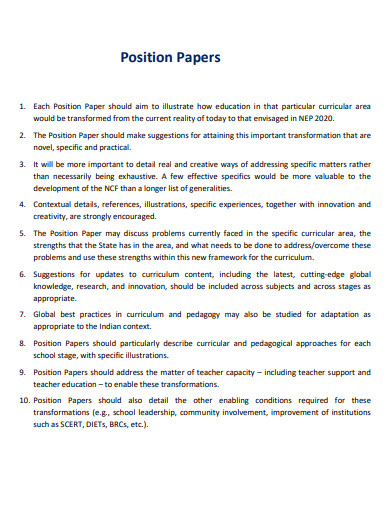
27. Printable Position Paper Example
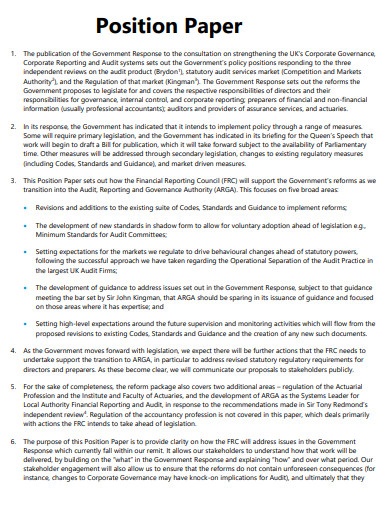
Size: 877 KB
28. Position Paper Policy Example
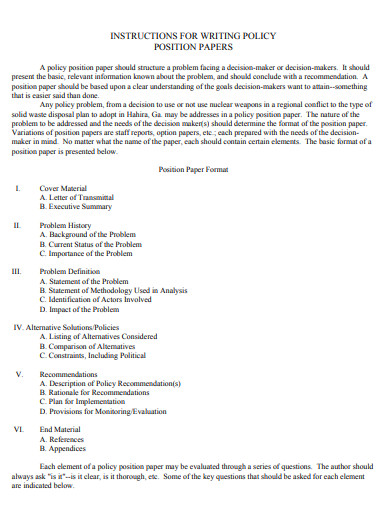
Size: 72 KB
29. Position Paper Checklist Example
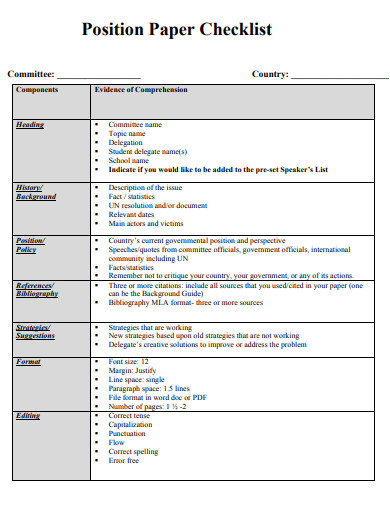
Size: 81 KB
30. Health Position Paper Example
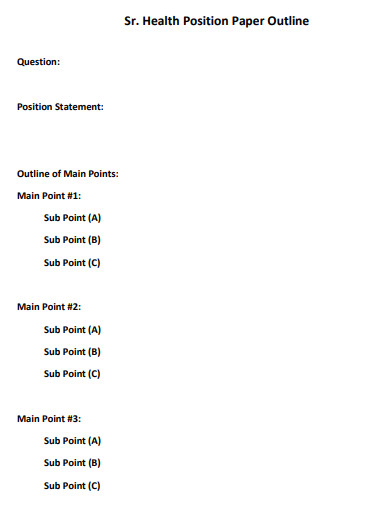
Size: 43 KB
What is a Position Paper?
How to write a position paper.
Are you ready to make your voice heard and influence opinions? Our step-by-step guide will walk you through the process of writing a persuasive position paper. From defining your stance to addressing counterarguments, we’ll provide you with the tools and strategies to create a compelling and impactful document. Let’s get started on your journey to persuasive writing success!
Step 1: Define Your Position:
Begin by clearly defining your stance on the issue at hand. Conduct thorough research to gather relevant information, statistics, and expert opinions that support your position. Consider the context and the target audience to tailor your arguments effectively.
Step 2: Create an Outline:
Developing a well-structured outline is essential for organizing your thoughts and ensuring a logical flow in your position paper. Use different outline formats such as alphanumeric or decimal to categorize your main points, supporting evidence, and counterarguments.
Step 3: Craft a Compelling Introduction:
The introduction sets the tone for your position paper and should grab the reader’s attention. Start with a thought-provoking observation , a simple sentence that highlights the importance of the issue, or provide relevant context to establish the significance of your position. Clearly state your thesis statement, which encapsulates your main argument.
Step 4: Present Your Arguments:
In the body paragraphs, present your arguments in a clear and concise manner. Use a persuasive tone and employ various literary devices , such as metaphors or rhetorical question , to engage the reader. Support your claims with credible evidence, including data, research findings, and expert opinions. Use strong verbs and common nouns to convey your message effectively.
Step 5: Address Counterarguments:
Acknowledge and address potential counterarguments to strengthen your position. Anticipate opposing viewpoints and provide well-reasoned rebuttals. This demonstrates your ability to consider different perspectives and strengthens the overall credibility of your position paper.
Step 6: Craft a Convincing Conclusion:
In the conclusion paragraph, summarize your main arguments and restate your thesis statement. Emphasize the strengths of your position and highlight the weaknesses of opposing viewpoints. End with a compelling call to action or a thought-provoking statement that leaves a lasting impression on the reader.
Are citations necessary in a position paper?
Yes, citations are crucial in a position paper to provide evidence for your claims and give credit to the original sources. Use a recognized citation style, such as APA or MLA, to ensure accuracy and consistency.
What elements should be included in a position paper?
A position paper should include an introduction, body paragraphs with supporting arguments, counterarguments, and a conclusion. Additionally, it should have a clear thesis statement , well-structured paragraphs, and logical transitions between ideas.
Can I use compound sentences in a position paper?
Yes, using compound sentences can enhance the clarity and coherence of your position paper. However, ensure that the sentences are concise and effectively convey your message without becoming overly complex.
AI Generator
Text prompt
- Instructive
- Professional
10 Examples of Public speaking
20 Examples of Gas lighting
How to Write a MUN Position Paper
A MUN Position Paper, also known as Policy Paper, is a strategic document that gives an overview of a delegates country position.
A good MUN Position Paper has three parts:
1) Country’s Position on the Topic 2) Country’s Relation to the Topic 3) Proposals of Policies to Pass in a Resolution
The following guide will show you how to write an excellent Position Paper, make the right impression to your chair and fellow delegates while achieving your overt, and covert, goals.
Table of Contents:
What is a Position Paper?
- The Sections of a Position Paper
- The PREP Formula
Types of Position Papers
The purpose of a position paper.
A Position Paper/Policy Paper, is a document, normally one page, which presents your country’s stance on the issue/topic your committee will be discussing. A solid position paper has three parts 1) Country’s position, 2) Country’s relation 3) Country’s Proposal
Great Position Papers require research and strategic analysis to effectively convey your countries position. Most MUN conferences require Policy Papers for a delegate to be eligible to win an award. Having an outstanding Position Paper could be the tiebreaker to win an award.
Why is the Position Paper important?
A MUN Position Paper is important for a wide variety of reasons beyond ensuring that delegates do a basic level of research before the conference. Understanding why a Position Paper is important lays the foundation to help you sort your thoughts as well as delivering your desired message to the chair.
The chairs oversee the committee from start to finish and as a delegate, you will want to show consistency with the principles and values present in your Position Paper.
Goals of a Position Paper
1. Show your country’s unique understanding of the issue being discussed . 2. Show your country’s previous relationship with the topic (preferably with relevant examples). 3. Show policies and ideas that your country would like to see in the resolution .
As most position papers are limited to one page, a minimum of one paragraph should be devoted to each of the aforementioned goals, and there should be clear transitions from paragraph to paragraph. The following position paper outline is universal, with options to expand in specific sections if you see it is needed.
The Sections of a Good Position Paper
A position paper is the result of proper preparation and research for your Model UN conference . Once you finish researching, follow the position paper guidelines (the conference should provide you with these). With the formatting instructions in mind, follow the instructions below to produce a high-quality position paper.
Model UN Position Paper Structure
1) How you / your country sees the situation/problem in general
2) Your country’s relation to the topic
3) What you want to pass in your MUN resolution
1) Your Position on the Topic Being Discussed
To answer the question “how to start a Position Paper’, keep in mind that you are not only sharing your position, but also introducing the reader to see the topic being discussed from your eyes.
To establish your position, start with a brief history of the situation / problem the committee will be discussing (How you see the situation / your position on the topic). Define what you see as the challenge to the global community (or at least what some of them face). Keep in mind that your goal is to meet this challenge by the end of the paper.
Frame the issue to be discussed as something that does not only pertain to your country but, ideally, also the other countries you would want to support your policy.
It helps to keep in mind that you will not get support for your clauses, or pass a resolution, alone. It is only if other countries see the topic the same way you do, that they will want to join you to implement your solution.
Example of Position Country: Angola Committee: The Food and Agriculture Organization (FAO) Topic : Improving Access to Clean Water
The Republic of Angola believes consistent access to clean water is a basic human right. Some countries have an abundance of water, such as: Canada, Scotland and Switzerland. Others have next to no water, such as: Yemen, Libya and Djibouti, or low rainfall like Namibia and Sudan which creates water scarcity and desertification. The solution to all of these problems is the weather control that comes from cloud-seeding, with richer countries already reaping the benefits. The National Center of Meteorology and Seismology (NCMS) witnessed an increase in rainfall of 10%–15% in polluted air and 30%–35% in clean air. China uses cloud seeding over several increasingly arid regions including Beijing, the capital. In 2017, the United Arab Emirates launched 235 cloud-seeding operations by five cloud-seeding planes based in Al Ain. The use and success proves the technology works, but it is only accessible to those who can afford setting up the mechanisms to cloud seed, or pay for the chemicals from companies like Bayer and DowDuPont Inc, who control the patents and sales rights.
2) Your Country’s Relation To The Topic
presentation of the policies your country has used to deal with the issue in the past. You should also describe the successes or failures of those policies (Your country’s previous relation to the topic and the precedents it set).
Note: This is also the place to write previous actions your committee has with the topic ONLY IF it is relevant to how your country introduces itself. Otherwise, you are repeating factual information that is not related to you introducing your position. Writing facts that do not forward your case is a trap many fall into. In the cases where your country has a strong link to the issue, the examples in the 2nd paragraph should be about your country’s connection to the specific issue.
If your country has no direct relation, see if similar countries to yours, or countries with similar positions, have a relation to the topic. You can also conduct research to find out if your country has a relation to a similar topic, from where you can draw inspiration and a direction to justify your policies. (More on this in our article about ‘ How to effectively represent your country ’)
Example of Relation Country: Angola Committee: The Food and Agriculture Organization (FAO) Topic : Improving Access to Clean Water
Angola’s history is scarred with conflicts arising from the abuse and mismanagement of natural resources, such as iron ore, petroleum, uranium, and diamonds. Angola is oil-rich while our people are dirt-poor. We stand at 149 out of 186 on the 2016 Human Development Index poverty scale. In rural areas, which contain 11.4 million people (38.5% of our total population), only 6% of households having access to electricity and 38% do not have access to safe water sources. Approximately 15 out of every 100 children do not survive beyond the age of five, leaving us with a child mortality rate is around 17%. These challenges are especially difficult for our president Joao Lourenco, who entered the office in September 2017. President Lourenco biggest challenge is reforming 38 years of cronyism and corruption under former President José Eduardo dos Santos. During his 38 years in power, infrastructure has not been developed while tens of billions of petrodollars disappeared. The 2014 oil slump made our situation worse reaffirming that we are unable to pull ourselves up on our own. Additionally, we do not get enough rain. We only get 32 days of rain with more than 0.1mm of rainfall meaning only 2.7 days of quality rain, sleet, and snow per month. Not enough to maintain adequate crop yields.
3) Extra Supporting Material
be hard data needed to support paragraph 2 or justify paragraph 3; this 4th paragraph still comes before the final section where you describe your desired policies.
what was originally read in the committee study guide.
Example of Extra Country: Angola Committee: The Food and Agriculture Organization (FAO) Topic : Improving Access to Clean Water
The global system that depends on technologies provided by companies like Corteva is strongly entrenched in the Sub Saharan agriculture sector, as well as all over the world. The four biggest companies, Bayer-Monsanto, ChemChina, Corteva and Syngenta have 59 percent of the world’s patented seeds, 64 percent of all pesticides and held near-monopolies over other agrichemicals. The use of these crops and chemicals has become fundamental to grow corn in Tanzania, potatoes in Kenya and other crops in sub-Saharan Africa throughout their diverse range of crops and terrains. This position of power persists because the sub-Saharan farmers are similar in their lack of access to best practices, techniques, technologies, finances and markets. This lack of skills is combined with limited resources results in the agriculture sector that is as under-development in agriculture as it is dependent on companies like ChemChina.
4)Proposal – What You Want to Pass in a Resolution
Give an outline of possible / likely solutions that your country proposes and would advocate to see implemented during the Model UN simulation. Do this within the limits of what your particular committee can do (What you would want to pass a resolution about). If you want to do additional actions beyond the mandate of your committee, you can outsource them to other committees. If this is an integral part of your strategy they should also go here. In the Proposal section, you can either commit to one strong Call to Action, a few different policies or two extreme red lines, which you say you intend to work between. Remember, while you do not need to fully commit yourself to what you write in your Position Papers, it is important that you show the margins within which you will be operating at the conference. Doing this shows there is thought behind your actions and gives you more credit with the chairs for diplomatic progress. It is thus strongly advisable that you not write something that you will directly contradict through your actions in committee sessions.
What is a Policy? A policy is a course of action proposed, or adopted, by a government, party, business, or individual. Your policies are a Call to Action telling the UN officials, who get the resolution, what to do.
You want your MUN policy to be clear, concise, and SMART .
The SMART MUN Policy
SMART is an acronym to describe the criteria needed to set policy goals. S pecific – Target a specific area for improvement in your policy.
M easurable – Suggest an indicator of progress once the policy is in place.
A ctionable – Specify what action this policy will do.
R ealistic – Given available resources and committee mandate, ensure your proposed policy can realistically be attained.
Timely – Specify when the result(s) from your proposed policy can be achieved, or when to revisit.
Example of Proposal Country: Angola Committee: The Food and Agriculture Organization (FAO) Topic : Improving Access to Clean Water
Angola advocates for a UN-sanctioned policy that gives permission to dry developing countries to make generic replicas of their patented chemicals at a fraction of the cost to achieve water independence. An example of these technologies belongs to German rainfall enhancement leader WeatherTec Services GmbH. WeatherTecs cutting edge technologies to improve water access are cheaper than many of their competitors but the operating costs start at 11 – 15 million Euros a year. Angola does not believe the United Nations should subsidize the cost of the chemicals, as the subsidy is a temporary solution and it would take funds from other important programs while leaving the corporations with the same level of control. Today, aside from South Africa, none of us can afford cloud seeding. We can cloud seed on our own if freed from the shackles of patent laws that benefit the rich. Dupot made net sales of $62.5B in 2017, by charging prices which the poorer dry countries could never afford. The UN should allow the relevant member states to locally produce WeatherTecs technologies so we can join the ranks of self-sufficient nations who can provide for themselves the basic water needs to survive.
The PReP Formula for Successful Position Papers
PReP stands for Position, Relation, extra & Proposal , which are the essential parts of every position paper . PReP will help you remember the formula.
Position – Your view / interpretation of the issue being discussed. (Paragraph 1)
Relation – Your connection to the topic being discussed. (Paragraph 2)
extra – The optional 4th paragraph which can contain extra information your feel is critical to your case, but doesn’t naturally fit into one of the other three paragraphs. This paragraph still comes before the one containing your policies.
Proposal – The practical policies you would want to see in the resolution. (Paragraph 3)
The PReP Strategy
With the Proposal ( paragraph 3), you solve the issue shown in your Position (paragraph 1) with the tools and relevance you set up in your Relation (paragraph 2). (The examples used in paragraph 2 should, preferably, also show the policy margins of your country).
The policy outlined in the final section of the Position Paper should show ideas that address the issues outlined in your position associated with the committee topic (as should have been specified in the first paragraph). This position should be justified by the country’s relation (or guesstimate relation) to the topic (the second paragraph). These should be used to justify the policy proposals you outline in the third paragraph. Each of these paragraphs should try to have as much unique information as possible that can’t be found in the committee study guide (because everyone in the committee should theoretically know that information). Obviously, your paper should have some connection to the main issues of the topic, but if you feel the paper should go in a different direction, that is completely your right.
Topic: Finding the cure for the Zika virus
Country: Greece
While this topic is one that is important, the delegate of Greece can decide that he doesn’t want his country to fund viruses they don’t have and only exists half a world away. In such a case, we would see:
Position (First paragraph) : How the global community spends collective money on local issues.
Relation (Second paragraph): How Greece doesn’t have the money to spend and how it has local diseases and problems at home.
Extra (Fourth Optional Paragraph): Optional paragraph could include data on regional diseases that broke out in neighboring countries and remain a viable threat for Greece.
Proposal (Third paragraph): Passing laws that would have localized diseases with body counts that don’t cross the tens of thousands, to be funded by local unions. There can also be a second idea that the World Health Organization divert extra funds instead of countries collectively forking out money.
There is no set amount of space each section needs to have. Some Position papers need a longer first section while others need double the space for the policy. What is certain is that no paper can miss any of the sections (except the extra part) and each one should be developed to at least 25% of the paper.
Practicum: The four-step plan to implement PReP
Writing a Position Paper should come after you finish your MUN research . Once you have completed that (and especially if you haven’t), follow this three-step plan and don’t over complicate things.
– Position Papers chairs read – Position Papers delegates read – Position Papers everyone will read – Position Papers no one will read
“Everyone has a story to tell or a product to sell. Know your audience before you open your mouth.” – April Sims
While not all Model United Nations conferences require Position Papers, many of them do. Whether it be your Chairs, other delegates, a mix or none of the above, knowing who will be your audience will help you craft the right paper and achieve your desired goal.
Position Papers Only The Chair Will Read
When the chair is required to send feedback, this usually means they will have read your Position Paper. This is an excellent opportunity to go all out, regarding the reasons for why your country has the position that it is taking and why you chose the policies that you did. (See our article on ‘Properly Represent Your Country?’) This is also the place to describe your Call to Action / the policies you want to implement in detail. The reason for such open and clear (but not too clear) writing is because no one but the Chair will read it, meaning you don’t need as much nuance as you would in a public Position Paper or opening speech. This is the place to give your ideas in a clear, unfiltered manner so that the Chair can understand it later when you give a more layered speech during the formal sessions.
‘For Chair eyes only’ Position Papers are also an excellent opportunity to bring facts and ideas that you want known to the chair, but don’t have time to fit into your first speech or two. While not bluntly giving away your country’s real motivation, you have a lot more liberty to flag things you’re afraid might be missed once the committee session starts.
Position Papers Only Delegates will Read (but not Chairs)
These are Position Papers where all the delegates are able to read each other’s work, research and position on the topic at hand. An example of where this can happen, is a large conference (e.g. 200 delegates), where the Position Paper deadline is the day before the conference.
For these papers, you still want to use the Position Paper platform to show why the discussion should focus on where you want it to go. For this reason, the Position Paper should be written more to frame the issue than give concrete detailed policies. Delegates who did not research to the same extent, or have no clear position, can be introduced to your interpretation of the topic. Some may completely adopt it, or at least be familiar with it when they hear it in a speech. (See our article on ‘ Writing the Killer Speech ’)
Position Papers Everyone Will Read (Chairs and Delegates)
The Chair + Delegate Position Papers are the most complex to write. In these cases, the ideal situation is for the chair to see what you would want them to see, as if it was written just for them, while at the same time, the other delegates would see a Position Paper customized for them. This is a hard balance to find, but if erring to one side, it is better to build a paper for the delegates and hope the chair has the experience to read between the lines.
One more variable to take into consideration is when Position Papers are written for a gigantic committee (100 or more delegates).
In gigantic rooms, the Position Paper should have at least the basics of the policy, because one might not speak in the first few hours and this might be the only way to get you onto the floor.
Position Papers No One Will Read
Yes, this actually exists in MUN. Some Position Papers will not be read by the Chairs or anyone else at all. However, the conference requires submission to qualify for a diplomacy award. A few conferences will admit that no one will read the Position Papers, but most will not.
Here are a few things to look out for to know your Position Papers likely won’t be read:
-When Chairs are not required to send you feedback on the Position Paper
– The deadline is the day before the conference.
In these cases, the main benefit of writing a Position Paper is to organize your thoughts. However, in practice, a poor document can be just as easily submitted to qualify.
Pitfalls to Avoid
Potential issues you may run into:
- You may run into a situation where your country does not have a clear policy towards a topic, or they have recently changed policy. For example, with the election in the US and the change from one ideology to another, their rhetoric towards the Iran Nuclear issue changed almost overnight. It would be tempting to follow the words of the leaders in a case like this, but pay attention to actual actions. Nothing has changed.
- When faced with conflicting positions from your country, choose one and stick with it. Use the position that you can find the most research on.
- Sometimes you will be stuck with a topic or committee that your country has little to no interest in. This will cause a lack of information to work with. For example, if you are in UNESCO and the topic is oil drilling in Ecuador’s rainforest, you may find that Malawi has not put out any statement on the issue. Don’t despair.
- In a situation like this, when your country has no position on a topic, you have to get creative. Find similar issues that affect your country and extrapolate that to the current topic. For the Ecuador example, Malawi can use their position of environmental issues in their own country and throughout the continent as a guide as to how they would respond.
- If you find yourself on a topic with indigenous people’s rights, but your country does not have a strong position, find out if there are indigenous groups in that country. Do they treat them well or poorly? Both will give you a direction to take with your Position Paper.
- There shouldn’t be a single sentence that has no purpose. Each fact or statement should support the identity you are constructing.
- If you feel a fact or statement that doesn’t seem to have a place, must be in the PP, think about why. If it is so vital that it fits into the first, second, or sometimes the third paragraph. If it does not, perhaps it can be replaced with one which does.
- The information can be used later – this fact or statement can be important and be saved for a later speech. However, the position paper needs to be a self-supporting document and just because it is important doesn’t mean it has to go here.
- You want to end every Position Paper on a strong note, but you do not want to have a conclusion that is overwhelming or concrete. Remember, you will not have many pages, usually, one to get your country’s position across. The Chair is not judging your Position Paper on how well you close, they are judging it based on your understanding of the issues and the solutions you bring to the table.
- That being said, it helps to close the paper well. There is an old saying about writing an essay that can apply to a Position Paper as well:
- “Your introduction tells them they will be intrigued. The body is the meat of the argument. The conclusion reminds them that they were impressed.”
- How do we apply this to a Position Paper? In the beginning, you frame the problem, not wasting your time giving a detailed research paper. The bulk of the paper is letting the Chair know that you understand your country’s relationship to the topic and your proposed solutions. Your conclusion is going to close briefly with a strong, concluding remark. BRIEFLY is the key word here.
Position Paper Format
The format of each Positions Paper, or Position Paper template, varies from conference to conference. However, even if you have no format instructions you do not want to have a messy position paper.
An unorganized paper can:
- Make you look less serious (to chairs and delegates)
- Make your text harder to follow
- Give your reader less incentive to pay attention
Messy Position Paper – Example
You can see here how the bunched lines, uneven spacing, random bullet points, different sizes, confused margins and everything else makes the paper unappealing to the eye before we even start reading.
Organized Position Paper – Example
Here you can see the Position Paper is more organized and easier to read.
Sometimes, the conference will give you an unfilled Position Paper template, with the logo and blank headings for you to fill in. Other times, the conference will send you a Model UN Position Paper sample. Other conferences will send you specific, or loose, Position Paper instructions about how they want the paper formatted.
Each Position Paper should be measured by its content and its ability to inform and influence the respective Chairs and delegate. However, the Position Paper will not reach that point if it is not accepted. It is a pity when your work is not be read or forwarded on because you got the font wrong, exceeded the margins or sent the paper in late. For this reason, whether strict or lax, read and follow the Model UN Position Paper formatting instructions so the hard work you put into the document will achieve its strategic objective.
Examples of Position Paper Instructions
Position Paper Instructions Example #1:
Write the Position Paper for ExampleMUN 2026 using the standards below:
- Length must not exceed two pages.
- Margins must be 2.54 cm or 1 inch for the entire paper.
- Font must be Times New Roman, size 12.
- Justify the paragraphs. The left and right margins must both have straight edges.
- Country name / institution committee name must be clearly labeled on the top of the 1st page.
- Agenda topics must be clearly labeled as the title.
- National symbols, such as flags, logos, etc. are deemed inappropriate for ExampleMUN Position Papers.
- Send your document in PDF format.
Position Paper Instructions Example #2:
We ask delegates of ExampleMUN to each produce a position paper before the conference. It must outline their country’s position, main objectives and issues they are seeking to address during the conference. Your Chairs will return the Position Papers to you with feedback a fortnight before the conference. This will give you time to ascertain which countries would be considered natural allies for you and for you to read which issues the other delegates may deem important.
A Position Paper the length of one side of A4 should be sufficient to state your position.
Example of Formatted Position Paper
Angola feels that in this day and age, hunger should be a thing of the past. However, in 2018, over 795 million people do not have enough food to lead a healthy, active life. This does not include the half of the world’s population, more than 3 billion people, who live on less than $2.50 a day. For better or worse, the road to more accessible and cheaper food is strongly related to water supply. Some countries have an abundance of water, such as: Canada, Scotland and Switzerland. Others have next to no water, such as: Yemen, Libya and Djibouti, or low rainfall like Namibia and Sudan which creates water scarcity and desertification. The solution to all of these problems is the weather control that comes from cloud-seeding, with richer countries already reaping the benefits. The National Center of Meteorology and Seismology (NCMS) witnessed an increase in rainfall of 10–15% in polluted air and 30–35% in clean air. China uses cloud seeding over several increasingly arid regions including Beijing, the capital. In 2017, the United Arab Emirates launched 235 cloud-seeding operations by five cloud-seeding planes based in Al Ain. The use and success proves the technology works, but it is only accessible to those who can afford setting up the mechanisms to cloud seed, or pay for the chemicals from companies like Bayer, Dupont and Dow Chemical Company, who control the patents and sales rights.
How to Win a Best Position Paper Award
T he difference between a good and a great Position Paper
Good Chairs will give credit to delegates who properly predict the room and are able to guide their policies from the Position Paper to the final resolution. This is because it means that the delegates accurately predicted which direction the discussion would go in, or better still, were able to direct the room in that direction.
This does not mean that the best delegate must have an excellent Position Paper, or perfectly stick to it. Aside from the ‘Best Position Paper’ award, the actions that take place in the committee are almost completely what Chairs will consider for awards. However, it is not uncommon that a Position Paper is used as a tiebreaker between two extremely close delegates.
In all these cases, you need to have an opinion. To win the ‘Best Position Paper’ award, your Position Paper needs to be full of new solutions, it must follow proper format and it has to be concise and ‘ fluff-free ’. Neutrality on an issue, or saying your country has no opinion, is admitting that you will let other delegates take the lead on the issue. It is better to find a policy of a country similar to yours, or your own policy on a similar issue, than saying nothing. More on how to deal with this can be found in our ‘ Research ’ and ‘ How to Represent Your Country ’ articles.
Top Position Paper Strategies
- The Chair of your committee will be reading so many Position Papers about the same exact topic that they will be bored to death of seeing the same solutions over and over again. To stand out, come up with a viable, new strategy that other countries may not have thought of. We say viable because it cannot be so outlandish as to be impossible, but it should be something that makes the Chair stop and focus on your paper.
- You can get a little off-the-wall with solutions, as long as they have a basis in reality.
- Alexander Hamilton employed a similar strategy during the Constitutional Convention in the US. When debating an overhaul of the US government, there were two main plans (the Virginia Plan and the New Jersey Plan). The New Jersey plan was closer to what was already in place, while the Virginia Plan was a change almost too much for people to handle (though most knew this was the only way to save the nation). In order to discredit the New Jersey Plan, Hamilton boldly proposed a plan so radical, that the Virginia Plan became moderate in comparison.
- Hamilton’s plan opened the discussion and changed the conversation. It caught the attention of everyone present and moved them towards a solution.
- You can do this with a position paper. Even if you do not ultimately get what you want, you have caught the Chair’s attention and have become a player in the game.
While this seems self-explanatory, you would be surprised how many people disregard the format rules given by the conference. Do not ignore this. As Chairs are reading the papers, they will come to expect certain formatting and anything not following the rules will stand out, and not in a good way. Do not get on the Chair’s bad side before the conference even begins. You can be sure that they will take points off for improper formatting and keep your name written down for conference time.
When you think about how to start a Position Paper, don’t go for an intense sound-bite. Flare is not good without substance. Try to be as clear as you comfortably can and reach your important points as quickly as possible.
What Chairs Look For
Similarly to how Position Paper format instructions are given to delegates, Chairs are also given instructions by the Model UN Conference Secretariat on how to evaluate Position Papers. Chairing, from when you write the study guide until the closure of debate, is a sacred responsibility.
Sometimes, the instructions given by the secretariat on how to evaluate Position Papers are clear and uniform. However, often, a Chair needs to fill in some gaps between the secretariat’s instructions and doing the job in real-time. To better understand the considerations regarding Position Papers, read the following instructions, given by an Under-secretary General of Chairing to their staff.
————————————–
Dear Chairs,
As of this weekend, all the registered delegates should receive their study guides. While a few delegates will still be getting allocations over the next week, most of them will have received guidelines for how and when to send Position Papers. The delegates are required to send the Position Papers to the committee email from the 20th – 26th of February. Any Position Paper received by the 26th before midnight should receive feedback from one of the Chairs. You are not obligated to give feedback to papers received from the 27th onwards. Hopefully, you should get most or all of the papers before the deadline. Papers received after the 28th are not eligible for the best position paper award, as you may not have time to check them. Position Papers that are received after March 1st, or not at all, will make the delegate ineligible for an award.
In the Position Papers, we want to see that delegates show they understand (a) the topic (b) their countries positions and history and (c) the policies they propose to solve it / perpetuate it (if they are evil).
The Position Papers which arrive on time should get feedback. This does not need to be more than a few lines per topic. However, we do require you to tell the delegates if they did a good job or if they are lacking in one of the three sections mentioned above. You should also tell them what you want them to improve. In the feedback, where possible, please use examples from their text. To do this most effectively, divide the position papers amongst yourselves and return them when you can. You are not required to send feedback if the delegate sends you an improved position paper. Our main goal is for you to have prepared delegates in your committee, and a rewritten position paper generally indicates better preparation.
If anyone would like more information on how to give feedback, or have any other questions relating to Position Papers, please let me know in a reply to this email.
If your delegates write you asking how to write a policy paper, or any other questions, we expect you to be helpful, courteous and available.
Good Luck
USG Chairing
Not every MUN conference secretariat will have this level of instruction for their Chairs. Some have more; a few give online workshops about Position Papers, while others give no instruction at all. However, in most cases, the final feedback is left to a Chair’s discretion.
If your secretariat left you alone, giving feedback on the basics according to the guidelines at the beginning of this article is a good start. You can also give topic-specific feedback, which uses examples of where more research or analyses can be used, based on what you wrote in your study guide .
11 Questions Chairs Ask When Reading Your Position Paper
Question chairs ask about a quality position paper.
- Did the delegate reframe the topic to make the problem-specific and relevant to them?
- Did they show their country’s relation to the topic?
- Did they offer policies that can gain a majority in the committee?
- Do these policies represent their countries stated interests?
- Did the delegate use examples?
- Do the examples go beyond the information in the study guide?
- Did the writer bring something new, unique and interesting?
Questions You Hope Your Chair Never Asks
- Was this position paper copied and pasted from Wikipedia or some other online source?
- If I change the country name on this super vague paper will it be just as “valid”?
- How inebriated was the delegate when they wrote this?
- Has the writer even heard of Model UN?
Using these questions to measure the quality of your paper will let you review your work with a Chair’s eyes. If the answers to these questions aren’t good enough, then you now know what to work on. A few appropriate modifications can result in a complete makeover of a Position Paper, and possibly a much-improved delegate as well.
Closing thoughts on Position Papers
Position Papers are important. Knowing if the Position Paper will be read only by the Chair or by the delegates should be taken into account when choosing what to write and focus on. Position Paper format should also be taken into account, but not at the expense of quality.
A Position Paper should accomplish three goals: 1. Show a country’s position on the topic being discussed. 2. Show a country’s previous relationship to the topic (preferably with relevant examples). 3. Show policies and ideas that (1) represent the interests of your country and (2) you would ideally like to see in the resolution.
When you’re the Chair, give instructive feedback with specific examples. Your comments could be the difference between a lost delegate or an effective one, or between a good conference and a great one.
Lastly, don’t forget the PReP strategy:
In Policy (paragraph 3) you solve the issue in Position (paragraph 1) with the tools and relevance you set up in Relation (paragraph 2).
- Privacy Overview
- Strictly Necessary Cookies
This website uses cookies so that we can provide you with the best user experience possible. Cookie information is stored in your browser and performs functions such as recognising you when you return to our website and helping our team to understand which sections of the website you find most interesting and useful.
Strictly Necessary Cookie should be enabled at all times so that we can save your preferences for cookie settings.
If you disable this cookie, we will not be able to save your preferences. This means that every time you visit this website you will need to enable or disable cookies again.
Have a language expert improve your writing
Run a free plagiarism check in 10 minutes, generate accurate citations for free.
- Knowledge Base
- How to write an essay outline | Guidelines & examples
How to Write an Essay Outline | Guidelines & Examples
Published on August 14, 2020 by Jack Caulfield . Revised on July 23, 2023.
An essay outline is a way of planning the structure of your essay before you start writing. It involves writing quick summary sentences or phrases for every point you will cover in each paragraph , giving you a picture of how your argument will unfold.
Instantly correct all language mistakes in your text
Upload your document to correct all your mistakes in minutes

Table of contents
Organizing your material, presentation of the outline, examples of essay outlines, other interesting articles, frequently asked questions about essay outlines.
At the stage where you’re writing an essay outline, your ideas are probably still not fully formed. You should know your topic and have already done some preliminary research to find relevant sources , but now you need to shape your ideas into a structured argument.
Creating categories
Look over any information, quotes and ideas you’ve noted down from your research and consider the central point you want to make in the essay—this will be the basis of your thesis statement . Once you have an idea of your overall argument, you can begin to organize your material in a way that serves that argument.
Try to arrange your material into categories related to different aspects of your argument. If you’re writing about a literary text, you might group your ideas into themes; in a history essay, it might be several key trends or turning points from the period you’re discussing.
Three main themes or subjects is a common structure for essays. Depending on the length of the essay, you could split the themes into three body paragraphs, or three longer sections with several paragraphs covering each theme.
As you create the outline, look critically at your categories and points: Are any of them irrelevant or redundant? Make sure every topic you cover is clearly related to your thesis statement.
Order of information
When you have your material organized into several categories, consider what order they should appear in.
Your essay will always begin and end with an introduction and conclusion , but the organization of the body is up to you.
Consider these questions to order your material:
- Is there an obvious starting point for your argument?
- Is there one subject that provides an easy transition into another?
- Do some points need to be set up by discussing other points first?
Receive feedback on language, structure, and formatting
Professional editors proofread and edit your paper by focusing on:
- Academic style
- Vague sentences
- Style consistency
See an example
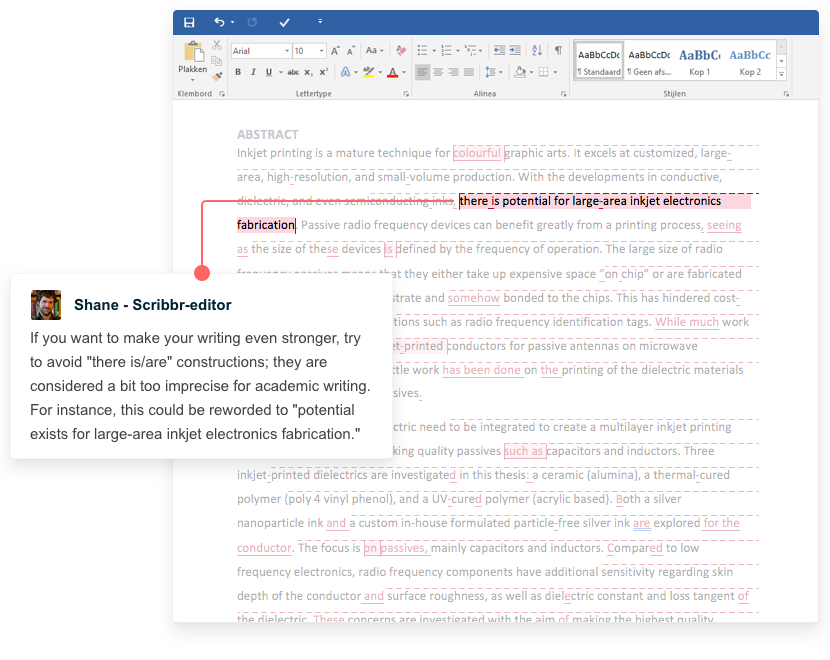
Within each paragraph, you’ll discuss a single idea related to your overall topic or argument, using several points of evidence or analysis to do so.
In your outline, you present these points as a few short numbered sentences or phrases.They can be split into sub-points when more detail is needed.
The template below shows how you might structure an outline for a five-paragraph essay.
- Thesis statement
- First piece of evidence
- Second piece of evidence
- Summary/synthesis
- Importance of topic
- Strong closing statement
You can choose whether to write your outline in full sentences or short phrases. Be consistent in your choice; don’t randomly write some points as full sentences and others as short phrases.
Examples of outlines for different types of essays are presented below: an argumentative, expository, and literary analysis essay.
Argumentative essay outline
This outline is for a short argumentative essay evaluating the internet’s impact on education. It uses short phrases to summarize each point.
Its body is split into three paragraphs, each presenting arguments about a different aspect of the internet’s effects on education.
- Importance of the internet
- Concerns about internet use
- Thesis statement: Internet use a net positive
- Data exploring this effect
- Analysis indicating it is overstated
- Students’ reading levels over time
- Why this data is questionable
- Video media
- Interactive media
- Speed and simplicity of online research
- Questions about reliability (transitioning into next topic)
- Evidence indicating its ubiquity
- Claims that it discourages engagement with academic writing
- Evidence that Wikipedia warns students not to cite it
- Argument that it introduces students to citation
- Summary of key points
- Value of digital education for students
- Need for optimism to embrace advantages of the internet
Expository essay outline
This is the outline for an expository essay describing how the invention of the printing press affected life and politics in Europe.
The paragraphs are still summarized in short phrases here, but individual points are described with full sentences.
- Claim that the printing press marks the end of the Middle Ages.
- Provide background on the low levels of literacy before the printing press.
- Present the thesis statement: The invention of the printing press increased circulation of information in Europe, paving the way for the Reformation.
- Discuss the very high levels of illiteracy in medieval Europe.
- Describe how literacy and thus knowledge and education were mainly the domain of religious and political elites.
- Indicate how this discouraged political and religious change.
- Describe the invention of the printing press in 1440 by Johannes Gutenberg.
- Show the implications of the new technology for book production.
- Describe the rapid spread of the technology and the printing of the Gutenberg Bible.
- Link to the Reformation.
- Discuss the trend for translating the Bible into vernacular languages during the years following the printing press’s invention.
- Describe Luther’s own translation of the Bible during the Reformation.
- Sketch out the large-scale effects the Reformation would have on religion and politics.
- Summarize the history described.
- Stress the significance of the printing press to the events of this period.
Literary analysis essay outline
The literary analysis essay outlined below discusses the role of theater in Jane Austen’s novel Mansfield Park .
The body of the essay is divided into three different themes, each of which is explored through examples from the book.
- Describe the theatricality of Austen’s works
- Outline the role theater plays in Mansfield Park
- Introduce the research question : How does Austen use theater to express the characters’ morality in Mansfield Park ?
- Discuss Austen’s depiction of the performance at the end of the first volume
- Discuss how Sir Bertram reacts to the acting scheme
- Introduce Austen’s use of stage direction–like details during dialogue
- Explore how these are deployed to show the characters’ self-absorption
- Discuss Austen’s description of Maria and Julia’s relationship as polite but affectionless
- Compare Mrs. Norris’s self-conceit as charitable despite her idleness
- Summarize the three themes: The acting scheme, stage directions, and the performance of morals
- Answer the research question
- Indicate areas for further study
If you want to know more about AI tools , college essays , or fallacies make sure to check out some of our other articles with explanations and examples or go directly to our tools!
- Ad hominem fallacy
- Post hoc fallacy
- Appeal to authority fallacy
- False cause fallacy
- Sunk cost fallacy
College essays
- Choosing Essay Topic
- Write a College Essay
- Write a Diversity Essay
- College Essay Format & Structure
- Comparing and Contrasting in an Essay
(AI) Tools
- Grammar Checker
- Paraphrasing Tool
- Text Summarizer
- AI Detector
- Plagiarism Checker
- Citation Generator
You will sometimes be asked to hand in an essay outline before you start writing your essay . Your supervisor wants to see that you have a clear idea of your structure so that writing will go smoothly.
Even when you do not have to hand it in, writing an essay outline is an important part of the writing process . It’s a good idea to write one (as informally as you like) to clarify your structure for yourself whenever you are working on an essay.
If you have to hand in your essay outline , you may be given specific guidelines stating whether you have to use full sentences. If you’re not sure, ask your supervisor.
When writing an essay outline for yourself, the choice is yours. Some students find it helpful to write out their ideas in full sentences, while others prefer to summarize them in short phrases.
You should try to follow your outline as you write your essay . However, if your ideas change or it becomes clear that your structure could be better, it’s okay to depart from your essay outline . Just make sure you know why you’re doing so.
Cite this Scribbr article
If you want to cite this source, you can copy and paste the citation or click the “Cite this Scribbr article” button to automatically add the citation to our free Citation Generator.
Caulfield, J. (2023, July 23). How to Write an Essay Outline | Guidelines & Examples. Scribbr. Retrieved April 3, 2024, from https://www.scribbr.com/academic-essay/essay-outline/
Is this article helpful?

Jack Caulfield
Other students also liked, how to create a structured research paper outline | example, a step-by-step guide to the writing process, how to write an argumentative essay | examples & tips, "i thought ai proofreading was useless but..".
I've been using Scribbr for years now and I know it's a service that won't disappoint. It does a good job spotting mistakes”
How to Make an Outline for a Position Paper
Louise balle, 24 aug 2018.

If your instructor asks you to write a position paper, he or she wants you to take a strong stance on an issue and present your argument. This paper is similar to writing one side of a debate. While making your assertions, you must also back them up with research and sources to lend credibility to your paper and convince your audience to accept your position. But, before you start writing, it's best to create a position paper outline and take a look at position paper samples.
Explore this article
- The Best Approach to Writing an Outline
- Create Your Title
- Write Your Introduction
- Find Your Main Idea
- Present Your Argument
- Outline Your Conclusion
1 The Best Approach to Writing an Outline
Before writing your position paper, you'll need to create an outline that can help you organize your thoughts and ideas. Having an outline will make it easier when it comes time to write the actual paper. Writing outlines is easier for some people than others, and likewise, some people find it easier to just jump right into the writing part. Either way, an outline doesn't hurt.
The best approach to writing an outline depends on what works best for you. Some students may find it easier to use pictures and diagrams to create their outline or a template provided by their teacher. Others may find it easier to write the outline from scratch. You can write it on the computer, or you can write it in a notebook. It's up to you. There is no right or wrong way to establish your outline, yet, it's necessary that your outline includes all the vital points that you'll need to have in your position paper. You may want to look at a position paper sample before starting the process.
2 Create Your Title
Start your position paper outline with a strong title that expresses your position briefly. Keep the title to 10 words or less. Don't write an "abstract" title or get too creative—just get right to the point. An example of a position paper title would be, "Why Hybrid Cars Are the Wave of the Future." If you're having difficulty coming up with a title, then come back to it later. Sometimes, it's easy to come up with a title if your teacher suggests the topic or you're answering a very specific question. Otherwise, if the title isn't coming to you right away, do the rest of the paper and come back to it later.
3 Write Your Introduction
Write the introduction. The introduction poses a fact or question for the reader to consider and presents the thesis (main idea). Keep the introduction to about one to two paragraphs. Similar to coming up with a title, an introduction can sometimes be much easier to write after the body of the essay is already completed. This way, you will know exactly what the main ideas are that should be mentioned in the introduction.
4 Find Your Main Idea
Outline a general background on the issue you plan to discuss. Here you're not yet presenting your argument—just informing the reader on why the issue is important. Plan a section of about one to four paragraphs.
5 Present Your Argument
Present your argument in the next section of the outline. This is the "meat" of your position paper outline. Here you'll state your position clearly and provide statements and facts from your research that supports this opinion on the matter. A position paper argument should include plenty of examples, charts, quotes from experts and other data in this section that will back up your position. This section should be several paragraphs (about one to five depending on your instructor's length requirements).
6 Outline Your Conclusion
Finish the outline with a conclusion. Here you'll summarize everything you've presented in the position paper and focus in on one or two points you mentioned that you feel are most relevant. Be careful not to repeat yourself word-for-word in the conclusion. End it with an interesting question or thought for the future regarding the issue.
- When writing out your outline, use a numbered list. For instance, "1. Title," "2. Introduction," etc. You can then go back and type in your various ideas for the position paper next to each point in the list.
- Be brief when filling out your outline. Short bullet points beneath each numbered section is fine. You will expand on each point when you're writing the actual paper.
- 1 Study Guides and Strategies: Writing Position Papers
- 2 Kibin: This Position Paper Outline Will Help You Get Started
- 3 SFU.ca: Writing a Position Paper
About the Author
Louise Balle has been writing Web articles since 2004, covering everything from business promotion to topics on beauty. Her work can be found on various websites. She has a small-business background and experience as a layout and graphics designer for Web and book projects.
Related Articles

How to Write a 10th Grade Book Report

How to Start a Research Paper Introduction

How to Write a Thesis Statement in High School Essays

Tips for High School Students on Creating Introductions...

How to Make a Good Thesis Title

How to Improve Your Handwriting for Left-Handed People

How to Write an Introduction

How to End an Informative Paper

Transitions For Essays

How to Write a Rough Draft

How to Write a Thesis for a DBQ

How to Write a Thesis Rough Draft

How to Write a Critical Response Essay

Good Ways to Start an Essay

Key Ideas to Help Write an Argument & Persuasion Essay

How to Write a Good High School English Essay

How to Write a Thought Paper

How to Write a Conclusion

How to Write a Debate Essay

Beginning an Informative Essay
Regardless of how old we are, we never stop learning. Classroom is the educational resource for people of all ages. Whether you’re studying times tables or applying to college, Classroom has the answers.
- Accessibility
- Terms of Use
- Privacy Policy
- Copyright Policy
- Manage Preferences
© 2020 Leaf Group Ltd. / Leaf Group Media, All Rights Reserved. Based on the Word Net lexical database for the English Language. See disclaimer .

Position Paper Outline : Outline For Argumentative Essay
- Author Sandra W.
Position Paper Outline
What Is a Position Paper?
A position paper is just like a debate in that in a position paper, you are expected to present and convince others to accept your side of an arguable opinion about an issue.
Therefore, the goal of a position paper is to convince the audience that your opinion is valid and defensible.
Care must be taken in choosing a topic, developing your argument, and organizing your paper. When presenting the arguments, you should ensure that all sides of the issue are addressed and presented in a manner that is easy for your audience to understand.
Your job, when writing a position paper, is to take one side of the argument and persuade your audience that you have well-founded knowledge of the topic being presented. It is important to support your argument with evidence to validate your claims and refute the counterclaims to show that you are well informed about both sides.
Before we go further, let us make a few distinctions between a position paper and an opinion paper because some students usually confuse the two.
Position Papers vs. Opinion Papers
In an opinion paper , the student is required to express and argue a personally held opinion. The opinion presented can, on occasion, be supported by empirical evidence, though more often the opinion is supported not by empirical evidence, but by intellectual logic and emotional engagement.
Position papers , by contrast, are supported by a reasonable preponderance of empirical evidence. Conclusions drawn in the paper are dictated by the evidence and data, though the interpretation of the evidence may be skewed by the personal agenda of the writer.
Choosing an Issue for Your Opinion Paper
Writing a good opinion essay involves first looking for a topic that is arguable and interests you. The questions below can help you to come up with a topic that will raise a strong argument:
- Does the topic present a real issue, with genuine controversy and uncertainty?
- Can you identify at least two distinctive positions that one can take on the topic?
- Are you personally interested in advocating one of these positions?
- Is the scope of the issue narrow enough to be manageable?
Once you choose a topic, you should make a pro and con lists, compare the information side by side, and then, while considering your audience, as well as your own viewpoint, choose the position you will take.
Sample Position Paper Outline
1: Introduction
Your introduction should do a number of things:
- Introduce the topic that you picked for your paper
- Arouse your readers’ interest in what you have to say
- Provide background on the topic to explain why it is important
- Assert the thesis (your view of the issue). More on thesis statements can be found below.
One effective way of introducing a topic is to place it in context, such as by using statistics and quotes that will put it in perspective and slowly lead your readers into your specific field of discussion (re: your thesis statement).
2: The Body
The body is made up of 3 or more supporting paragraphs and a paragraph or two for counter-arguments.
Three or More Supporting Arguments
You may have more than 3 overall points to your argument, but you should not have fewer. Every argument should be in a paragraph of its own, introduced by a leading sentence and supported by well-referenced sources. Follow the referencing style given in the course’s marking rubric.
Paragraph #1: Assert point #1 of your claims
- Give your educated and informed opinion
- Provide support/proof using more than one source (preferably three)
Paragraph #2: Assert point #2 of your claims
Paragraph #Assert point #3 of your claims
3: Counter Argument
Ask yourself what someone who disagrees with you might say about each of the points you've made or about your position as a whole and respond to each of their positions. You can either concede that your opponent has a point, but explain why your audience should nonetheless accept your argument or you can reject their counterargument and explain why it is mistaken.
It is usually better to consider one or two serious counterarguments in some depth, rather than to give a long but superficial list of many different counterarguments and replies. Make sure your response is in line with your initial opinion and all your supporting arguments so as not to contradict yourself.
Therefore, a counterargument section should:
- Summarize the counterclaims
- Provide supporting information for counterclaims
- Refute the counterclaims
- Give evidence for the argument
When you are summarizing opposing arguments, be charitable and diplomatic. Present each argument fairly and objectively, rather than trying to make it look foolish.
3: Conclusion
The simplest and most basic conclusion is one that restates the thesis in different words and then discusses its implications.
- Restate your argument
- Provide a plan of action but do not introduce new information
Recent Posts
- A Sample Essay on Birds 21-08-2023 0 Comments
- Is Homeschooling an Ideal Way... 21-08-2023 0 Comments
- Essay Sample on Man 14-08-2023 0 Comments
- Academic Writing(23)
- Admission Essay(172)
- Book Summaries(165)
- College Tips(312)
- Content Writing Services(1)
- Essay Help(517)
- Essay Writing Help(76)
- Essays Blog(0)
- Example(337)
- Infographics(2)
- Letter Writing(1)
- Outlines(137)
- Photo Essay Assignment(4)
- Resume Writing Tips(62)
- Samples Essays(315)
- Writing Jobs(2)
Questions? Call us:
Email:
- How it works
- Testimonials
Essay Writing
- Essay service
- Essay writers
- College essay service
- Write my essay
- Pay for essay
- Essay topics
Term Paper Writing
- Term paper service
- Buy term papers
- Term paper help
- Term paper writers
- College term papers
- Write my term paper
- Pay for term paper
- Term paper topic
Research Paper Writing
- Research paper service
- Buy research paper
- Research paper help
- Research paper writers
- College research papers
- Write my research paper
- Pay for research paper
- Research paper topics
Dissertation Writing
- Dissertation service
- Buy dissertation
- Dissertation help
- Dissertation writers
- College thesis
- Write my dissertation
- Pay for dissertation
- Dissertation topics
Other Services
- Custom writing services
- Speech writing service
- Movie review writing
- Editing service
- Assignment writing
- Article writing service
- Book report writing
- Book review writing
Popular request:
Position paper: detailed outline for students.
May 20, 2021

To help you understand how to write a position paper outline, here is a detailed guide that covers all the important sections of a position paper and the right structure for one.
The Main Components of a Position Paper Outline
The main structure of a position paper outline is quite similar to any essay. It starts with a strong introduction, a well-researched body and a conclusion that is compelling. In the following sections, you will get an example of position paper introduction, the body and the conclusion to understand the structure better.
The first step to writing a position paper outline is finding a topic that you can write about. There are different types of topics that you can choose from:
Definition and fact claim: These topics are ideal for any descriptive essay. Policy claims: When you have to write a position paper about finding a solution to a problem or a ‘how to’ essay, these are the best topics for you. Value claims: This type of position paper outline compares the value of two contrasting subjects. You have to take one side and present your views. Cause claims: These topics specifically look at the causes for any existing problem. Again, you can present your ideas on why you think one causal factor needs more attention.
For your reference, we will choose the topic, ‘Why Tablets Should Replace Traditional Text Books”. This is a type of value claim which compares traditional textbooks with new age resources for the classroom.
Introduction of a Position Paper
Before we dive into a position paper introduction example, let us understand what is the objective of a good intro. Here are two primary things that you should aim to establish with your introduction:
- The issue that you are addressing
- The position that you are taking in the essay
A good introduction always starts with a compelling hook that makes your stance on the subject very clear. Always remember that your position is researched based. So, when you are figuring out how to write a good position paper introduction, you need to remember that it must always be in third person. If you write in first person, it becomes an opinion essay. You must always write a position paper introduction with the objective of getting the interest of the reader instantly towards your stance on the subject.
Here is a position paper introduction example with respect to the topic that we have chosen in the previous section:
“A recent experiment showed that students in California’s Riverside Unified School District who used the digital version of an algebra textbook on their tablet managed to score 20 percent higher on all standardized tests in comparison to students who used print versions of the same book. As the popularity of standardized testing increases and students are compelled to stay ahead in the global economy, they need all the edge possible. Replacing traditional textbooks with tablets can give them the advantage that they need. The small jump in test scores is not the only advantage of tablets. They are also lighter and less expensive than regular textbooks.”
As you can see, the paper opens with a hook in the form of statistics and also states multiple reasons that establish the position of the writer.
The Body of the Position Paper
What’s a position paper body? This is the most important part of your paper where you make all the compelling arguments to prove your stance. You need to divide the body of your position paper into three paragraphs at the very least. Every paragraph will present an argument that will make your stance stronger. You must include quotes, interviews, statistics and other evidence that can support your arguments.
It is in the body of the paper where you will also examine opposite viewpoints. This will help you provide counter arguments and even refute any opposing claims until you can prove that your point of view is valid.
Continuing with the topic selected in the first section, here is an illustration of how to write a position paper outline with the body of the essay:
Argument 1/ Paragraph 1:
“Research conducted on kindergarten students in Auburn, Maine shows that those who used iPads scored higher on literacy tests in comparison to those who did not. The primary findings of this research included the fact that the knowledge of fractions increased by at least 15%. Additionally, the participants became more interested in fractions after playing related games on their tablets.”
Argument 2/ Paragraph 2:
“Discovery’s techbooks that can be used on iPads, desktops, laptops and other devices cost between $38- $55 for every student. On the other hand, regular textbooks cost up to $70 per student. As per the FCC, in the US alone, an average of $7 billion is spent each year on textbooks. More importantly, these textbooks are usually outdated. Tablets not only improve learning, but also help you save money.”
Similarly, you can present facts to support your stance in the following paragraphs depending upon the word count for your essay, as recommended by your university.
Here is an example of a counterargument that you can add in your position paper structure to strengthen your viewpoint.
“Research has consistently shown that tablets can also distract students as they contain several apps and features that are directed towards entertainment and not education. They also provide access to the internet where there are countless temptations for children. It can also be argued that academic performance can be hindered by multitasking on the tablet. However, it is important to notice why students are distracted by these devices. There is only one reason that stands out. These devices are interesting. So, using these features as a means to educate children and teach them subject concepts is an interesting approach. Making teaching more engaging also means that students will perform better at school.”
Think of the conclusion to the paper as a summary of all the points that you have presented in the position paper sample outline. This is where you reiterate your stance by making quick references to the points that you have covered through the essay. Lastly, you can also provide a solution or an idea that can solve the problem under discussion.
Here is an example of a conclusion to a position paper with respect to the topic under discussion:
“In conclusion, replacing textbooks with tablets is a great strategy for schools. Although tablets may be viewed as a source of distraction, they potentially increase the scores of standardized tests, save money and reduce the burden of heavy school bags for the students. When there are so many benefits, it only makes logical sense to use tablets in the place of traditional textbooks in a classroom.
150 Position Paper Topics to Write About
As you have seen in the position paper introduction example, the only way to grab your reader’s attention from the get go is to choose a topic that you feel strongly about. That is when you will be able to make an impactful introduction and present a good argument to convince the reader of your point of view.
Here are 150 topics that will help you make a good outline for a position paper:
Papers on Social Issues
If you are wondering about how to write a good position paper on social issues, here are some topics that will help you get ideas:
- There must be assured equal access for COVID vaccine distribution.
- Write a position paper outline on abortion and how it can be reduced without legislation.
- The racial background of policemen determines how they do their job.
- Should the racial structure of a police department be similar to the community that they work with?
- Ideas for pro-choice and pro-life groups to work to gather
- Barbie dolls must be banned.
- Reality shows must have stricter regulation
- Define True Beauty
- Video Gaming: Good or Bad?
- Do beauty contests have any positive impact on young girls?
- Should athletics also include participation trophies?
- Are sports parents who are overbearing harmful or helpful?
- Children should be pushed to pursue athletics: Agree or Disagree?
- Should children be given more time to play freely or should they indulge only in scheduled activity?
- The reason for increase in child obesity
- Ways to make children more active?
- Should drug testing be made compulsory for people on welfare?
- Why do celebrities often have serious life issues?
- Ways to regulate media coverage.
- Media coverage has a strong influence on elections.
- Define human trafficking and present your views on it.
- Effective ways to stop human trafficking.
- The difference between elected males and elected females.
- The importance of having equal representation of genders in political office.
- How does having equal representation for different races in the political office help?
- Ways to support election of more women into political offices
- Ideas to encourage minorities to become police officers
- How can the rights of writers and artists be protected on the internet?
- Should people pay for the music they listen to?
- Is religious persecution still existent?
- Should ‘designer babies’ be banned?
- How can unemployment among African American men be reduced?
- Should minimum wage be lowered or increased?
- The laws against racial profiling should be stricter
- Casteism is still a strong social evil.
Position Paper Topics About School
- In person classes or virtual schooling. Which one is better?
- Is a national high school exam necessary?
- Do statewide testing methods increase the knowledge of students?
- Should colleges stop relying on ACT and SAT scores while admitting students?
- Is there a need to reform the school system in your country?
- Is the educational system in Europe the best?
- Why do students graduate from high school without learning basic skills?
- How are students from America different from students in other countries?
- The role of technology in education.
- How important is liberal arts education?
- Students must be required to take up foreign language courses.
- Can learning improve by adding days to a regular school year?
- Teaching in public schools for students whose first language is not English.
- Should athletes in college be paid?
- Should more scholarships be offered to ensure inclusivity in schools?
- Having uniforms in schools is a good idea.
- Bullying has become more aggressive in the modern age. Why?
- Are there benefits of attending single-sex schools?
- Are teachers and educators responsible for lower grades?
- Are teachers and educators equipped to teach Gen Next?
- Is having a break during summer good for school students?
- Does homework help or cause harm?
- The government should implement more laws to make education accessible to more children.
Position Papers on Technology
- Our relationships are controlled by technology
- The way humans think is changing because of computers
- Young people are unable to concentrate well because of cell phones and texting.
- Cell phones and texting have made us more capable of multitasking
- Our interactions have changed in a positive way because of cell phones.
- Face to face talking cannot be replaced by cell phones, emails and texts.
- Online resources and i-pads should replace textbooks
- The way we live is being changed by online technologies.
- The definition of being human is being changed by technology
- Social media usage by teenagers must be reduced by parents.
- Usage of cell phones in the car should be governed by stricter laws.
- Social media companies need to upgrade their current privacy policies.
- What should college students post on Facebook and what they shouldn’t
- Is it ethical to allow scientists to experiment on human embryos?
- Nanotechnology can change the future of mankind
- Technology helps us get to the future faster
- Online meetings can never replace face to face meetings
- Ideation requires face to face meetings between team members
- E-learning is the future of education
- Children can learn from technology if it is used wisely
- Is technology making people lazier?
- Has technology made us dumber or smarter?
- There should be legal or public control in the development of technology
- Should the state invest more funds in the development of better war technology?
- Is space studies a good area for the state to invest in?
- Will the development of artificial intelligence harm or benefit people?
- Is cloning ethical?
- Is it a good idea to allow genetic engineering?
- Is there a possibility that technology and humans will merge into singularity?
- The repercussions of cyberbullying should be stricter.
Position Papers on Environment
- Prepare an outline for a position paper on how citizens can affect local environment
- Clean drinking water should be available for all.
- The increase in worldwide population is the primary cause of all the environmental issues damaging the planet.
- Poaching of endangered species should have stricter repercussions.
- Does hunting benefit the environment?
- Best ways to resolve the environment versus economy debate?
- What can we do about the raging issue of global warming?
- How can manufacturers play an important role in cleaning up the earth?
- What is the relationship between pollution and health?
- Compare current trends of species extinction with those of the past?
- People should be given incentives to encourage more recycling.
- How global warming increases the incidence of certain diseases.
- Harnessing natural energy is harmful or beneficial in the long run
- Use of energy efficient home appliances should be made mandatory.
- Segregating waste is an effective way of managing pollution and increasing recycling.
- Should biofuels be made compulsory in the racing industry?
Position Papers on Global Issues
- Establishing peace in our world is impossible.
- Is war and integral part of our society?
- What are the different ways in which leaders justify war? Do you agree?
- The USA has taken up the role of policing other countries. Your comments.
- Drone warfare: Ethical or Unethical?
- The importance of cyber warfare in the modern world.
- Is the United States responsible for certain cyber-attacks on other nations?
- The impact of the 9/11 attack on the image of America as a world power.
- Should countries increase or decrease their military spending?
- How important is race in determining the identity of a country?
- Has the Covid-19 Pandemic united or divided the world?
- Is adopting children from a different ethnic group a good idea for couples?
- Should beauty pageants be banned?
- Why is it important to know your cultural and racial heritage?
- Should schools make multiculturalism a mandatory subject?
- How can the church contribute to increasing awareness of multiculturalism?
- Parents are responsible for their children being appreciative of diverse cultures.
- Should countries help immigrants find a path to citizenship?
- Is it possible to resolve the immigration issue in the US with a border fence?
- People migrate illegally out of necessity. Do you agree or disagree?
- The best way to respond to the global issue of immigration
- Should countries allow a visitor work program to prevent illegal immigration?
- How has the history of the United States been affected by immigration?
- Should countries give policemen the right to ask people about their legal status?
- Ways to streamline illegal immigration.
- How do you decide who should be allowed to immigrate and who should not?
- Are the election processes used in your country fair?
- Should there be a global ban on the use of tobacco?
- Is making consumption of drugs illegal the right solution to the problem?
- Do law enforcement cameras invade privacy?
- Is ours a throwaway society?
- Should capital punishment be banned?
- Should governments have a say on the number of children a couple has?
- Do you think professional athletes and actors are paid too much?
- Does easier access to condoms curb the issue of teen pregnancy?
- Should companies market their products to children?
- Healthcare facilities provided by the government can be improved.
- Are admissions to educational institutions too competitive in the modern world?
- Is it ethical to legalize euthanasia?
- Is having stringent gun control laws a good idea?
- Should the drinking age for alcohol be increased?
- Is it ethical for the government to have a say in same sex marriages?
- The LGBT community is unfairly targeted. Your views
- Boredom is the cause for rampant mental health issues.
- The global pandemic is responsible for an increase in cases of depression and anxiety.
- Does religion lead to wars?
How to Research for Your Position Papers
Now that you have a detailed position paper outline sample, here are some additional tips on how to gather information for your paper. Today, there are countless resources besides the traditional ones like the library. If you are looking for data to add to your paper, the options that you have are as follows:
- Textbooks: The textbooks used in your classroom are a great starting point for your research. You can take ideas from any article that is suggested in your textbook to figure out your topic.
- YouTube: This is a great source to not only find topics but also check out talks and discourse about the subject that you have chosen.
- Newspapers and Magazines: Although you may have to search with a lot of attention with these resources, newspapers and magazines are the best options to get all the latest information about a subject that you wish to write about.
- Internet: Popular search engines are, of course, the best resource available to us today. However, it is a good idea to do some groundwork before you search on the internet as you get too much information that can often be confusing.
Lastly, when writing a position paper, you also need to focus on the style recommended by your college. For instance, you may need to learn how to write a position paper in APA format. If all this is too overwhelming for you, it is best that you hire research paper writing services.
Get in touch with us now for high quality writing help from experts that ensure that you turn in a great paper every time.

Take a break from writing.
Top academic experts are here for you.
- How To Write An Autobiography Guideline And Useful Advice
- 182 Best Classification Essay Topics To Learn And Write About
- How To Manage Stress In College: Top Practical Tips
- How To Write A Narrative Essay: Definition, Tips, And A Step-by-Step Guide
- How To Write Article Review Like Professional
- Great Problem Solution Essay Topics
- Creating Best Stanford Roommate Essay
- Costco Essay – Best Writing Guide
- How To Quote A Dialogue
- Wonderful Expository Essay Topics
- Research Paper Topics For 2020
- Interesting Persuasive Essay Topics

- Services Paper editing services Paper proofreading Business papers Philosophy papers Write my paper Term papers for sale Term paper help Academic term papers Buy research papers College writing services Paper writing help Student papers Original term papers Research paper help Nursing papers for sale Psychology papers Economics papers Medical papers Blog

Position Paper Outline – Latest Writing Guide

A position paper outline acts as a “blueprint” or “plan” for your academic paper. With such a design, you can organize your thoughts and arguments easily for a top-notch essay. A good position paper sample outline can make conducting research and then writing the assignment very efficient.
What’s A Position Paper?
It refers to an essay that provides an arguable opinion about a particular topic of concern. This paper gives the position of the author or a specified entity. Such assignments arise when there is a topic of contention.
Therefore, an outline for a position paper allows you to create a sketch or a skeleton for arguing out your stance. It helps you ensure that each paragraph of your essay serves a specific purpose in your paper.
Through outlining, you can be able to eliminate or combine potential paragraphs. That is why writing a position paper outline is crucial for college or university students. You will be able to develop a substantive position paper structure and thus, an exceptional paper. Below is a guide on how to write a position paper outline that will impress your instructor.
How To Write A Good Position Paper – Outline Template
How do you write a position paper? Did you know that the outline plays a significant role in ensuring that you have a high-quality paper? Look at the position paper outline below as we discuss what you need to do at each stage.
Position Paper Outline Sample
- Choose a topic
A position paper aims to convince readers of the validity of your opinion. Therefore, when choosing your topic, make sure that it is one which you can defend in the subsequent body paragraphs. Choose a topic that:
- Is real with genuine controversy
- Has at least two distinctive positions
- Interests you and your readers at large
Remember that the topic represents your position; thus, it should be distinctive and clear.
- Analyze the topic
You will then proceed to examine your ability to support every counterclaim to your position. Listing along the supporting evidence for both sides is also key in this stage. Before we proceed to the position paper outline example, here are four crucial questions to ask yourself:
- Is my position paper topic original and interesting?
- Are the arguments outlined in line with the specifications of your instructor?
- Does your paper assert a specific stance?
- Is the material available sufficient to support or prove your opinion?
Once you have analyzed and answered these questions, you are good to start writing your position paper. However, you can use writing help from experts or use a position paper introduction example available online to structure your essay better.
How To Write A Position Paper Outline – Structure and Organization
Since a position paper is short, its structure is not as complicated as that of a research paper. Though the preparation process might seem quite tedious, structuring your essay and writing it is not that hard in its essence.
- Introduction
Your introduction serves the purposes of introducing your topic and providing a background of your subject matter. You will also get to assert the thesis statement, which is your position, in the introductory paragraph. The reader will either be interested or turned off by reading your intro. A good example of position paper introduction is one that places the topic in its context and gradually leading into your specific point of focus.
- Counterarguments
It is the section where you present your counterarguments and supporting evidence for the counterclaims. You also have the opportunity to refute the counterclaims and show why they are mistaken. This paragraph should leave your reader with a sense that your position is stronger than the opposing arguments.
- Your Argument
Provide an informed opinion with proof from two or more sources. Provide evidence such as statistics, interviews, and quotes that support each argument. Show why your point of view is valid while refuting the counterclaims.
In the concluding paragraphs, emphasize the key points of your paper. Do not state them word for word but instead make a conclusive summary of the main arguments. Stress the importance of your issues while providing suggestions where possible.
How To Write A Position Paper in APA Format
The main components of an APA position paper are the Title Page, the Abstract, Main Body and References. All these four aspects must be present while relating them to the structure of a position paper highlighted above. If you don’ have the time to write a paper and don’t want to put your grade at risk, you need a professional writer to deal with it.
Top 5 Position Paper Topic Ideas
- Homework is doing more harm than good for students
- Lockdowns are not the solution to COVID-19
- Students should have mobile phones in school
- The internet should have a PG rating
- Abortion should be banned
Whether you need an abortion position paper outline or a position paper introduction example, our research paper writing services are all you need. Contact us with a “please, do my essay for me ” request and we’ll get your paper done. We provide affordable writing help for all. Give it a try today!

Leave a Reply Cancel reply
Your email address will not be published. Required fields are marked *
Save my name, email, and website in this browser for the next time I comment.
Terms & Conditions Loyalty Program Privacy Policy Money-Back Policy
Copyright © 2013-2024 MyPaperDone.com

IMAGES
VIDEO
COMMENTS
A position paper requires three basic parts: an introduction, a body and a conclusion. Follow these seven steps to help write a position paper on any topic: 1. Choose a topic. In some classes or jobs, you can choose the topic of a position paper. If you're choosing your topic, consider ones relevant to your industry or academic interests.
Steps for Writing an Excellent Position Paper. A position paper is like an argument paper or a debate where you pick a side on an issue and gather facts, evidence, and information to present a convincing argument that your position is the correct stance. 1. Read the instructions.
Introduction. In a position paper, the introduction has two primary goals: To identify the issue. (This is the focus of your paper.) To state your assertion. (This is the thesis statement of your paper.) Start your introduction with a clever hook —you know, something that's going to grab a reader's attention.
Position Paper. Definition: Position paper is a written document that presents an argument or stance on a particular issue or topic. It outlines the author's position on the issue and provides support for that position with evidence and reasoning. Position papers are commonly used in academic settings, such as in Model United Nations conferences or debates, but they can also be used in ...
4. Create an Outline. Once you have decided about the direction you're taking with your essay, proceed with the position essay outline. This step is often overlooked, but it will be much easier to find and correct mistakes and gaps at this early stage. So, writing a position paper outline actually saves you time.
End your introduction with your thesis. 3. Include at least 2 body paragraphs. A short position paper may only contain 2 body paragraphs - one for the counter-argument and one for the supportive points. However, most position papers will have 3 or 4 body paragraphs, with 2 dedicated to supportive evidence.
When writing a position paper, it is important to thoroughly research the chosen topic and gather relevant information and data to support your stance. Begin by introducing the issue and providing a brief background to provide context. Use examples, statistics, and expert opinions to strengthen your arguments and make them more persuasive.
Express your position idea. Focus on one specific aspect of the topic in order to express it in a one-sentence opinion. Make sure you have found a really arguable idea. If the topic cannot be debated, then it can hardly be used for writing a good position paper. Be precise in your statement.
5. Summarize your argument and restate your position. End your paper focusing on your argument and avoid the counter-arguments. You want your audience to walk away with your view on the topic being one that resonates with them. When you write a position paper, write with confidence and state your opinion with authority.
Sample Outline for a Position Paper. I. Introduction. A. Introduce the topic. B. Provide background on the topic. C. Assert the thesis (your view of the issue) II. Counter Argument. A. Summarize the counterclaims. B. Provide supporting information for counterclaims.
Here is how to start a position paper: 1. Introduction. - Introduce your topic clearly. - Provide some general background related to your chosen topic with an explanation regarding why your paper's subject is important. - Assert your thesis that reflects your view of the issue.
Step 1. Pick a Topic. You can brainstorm topic questions from here by narrowing in on one section of your chosen interest. The purpose of a position paper is to pick a side of a question and aim to convince the reader of the writer's stance by using research data to back up their views. Choosing a topic is the first step to writing a position ...
It would help if you organized you articulated your thoughts in a logical and transitional flow to ensure your readers follow through with the entire text. Below is a guideline to use as an example when composing a position paper. 1. Introduction. Topic introduction. Background information. Thesis statement. 2.
How to Write a Position Paper: 10 Easy Steps. Decide on a topic: The best topic will be one you have a strong interest in or opinion about. Find some articles to read about your topic. It is best to read different positions. Try to get a feel for the various views on the topic. Write your position idea: Pick one particular aspect of the topic ...
September 5, 2021. A position paper outline provides guidance and structure for students to write a position paper the right way. A good outline will summarize the content you want to include in your essay and organize it in a coherent and sensible structure. The ability to outline a position paper is an important skill because some lecturers ...
This article serves as a comprehensive guide to understanding what a position paper is, how to write one effectively, and provides valuable examples and templates to assist you in crafting your own persuasive document. 1. Sample Position Paper. cenmun.com. Details. File Format. Size: 382 KB. Download. 2.
A MUN Position Paper, also known as Policy Paper, is a strategic document that gives an overview of a delegates country position. A good MUN Position Paper has three parts: 1) Country's Position on the Topic. 2) Country's Relation to the Topic. 3) Proposals of Policies to Pass in a Resolution. The following guide will show you how to write ...
Revised on July 23, 2023. An essay outline is a way of planning the structure of your essay before you start writing. It involves writing quick summary sentences or phrases for every point you will cover in each paragraph, giving you a picture of how your argument will unfold. You'll sometimes be asked to submit an essay outline as a separate ...
Every student will be assigned an essay at some point in their academic career. There are many different kinds of essays a teacher can assign, and one is a position paper. If you're required to write a position paper for class, then you should start by creating a position paper outline.
Sample Position Paper Outline. 1: Introduction. Your introduction should do a number of things: Introduce the topic that you picked for your paper. Arouse your readers' interest in what you have to say. Provide background on the topic to explain why it is important. Assert the thesis (your view of the issue).
Continuing with the topic selected in the first section, here is an illustration of how to write a position paper outline with the body of the essay: Argument 1/ Paragraph 1: "Research conducted on kindergarten students in Auburn, Maine shows that those who used iPads scored higher on literacy tests in comparison to those who did not.
Position Paper Outline - Latest Writing Guide. A position paper outline acts as a "blueprint" or "plan" for your academic paper. With such a design, you can organize your thoughts and arguments easily for a top-notch essay. A good position paper sample outline can make conducting research and then writing the assignment very efficient.